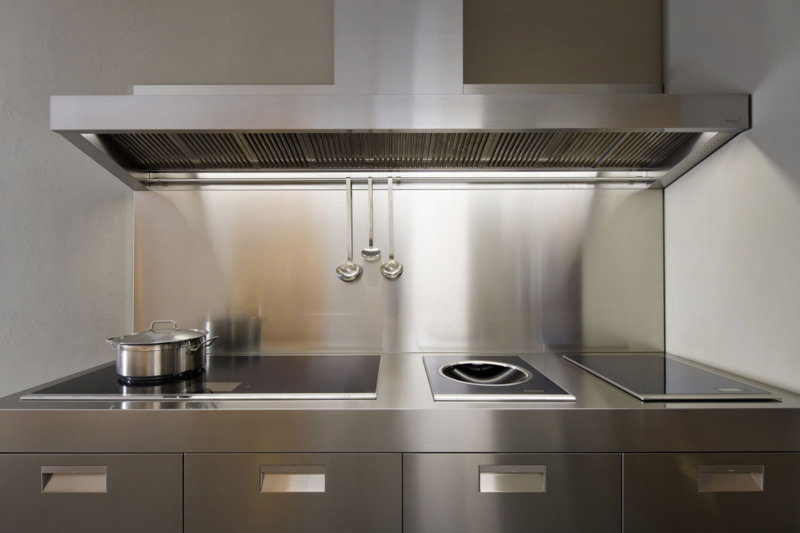How to decorate a kitchen apron. We select the material for the kitchen apron - practical advice.
An apron is not only kitchen clothes with cute ties and embroidery. Designers today call the kitchen backsplash and the surface of the wall between the cabinets and the countertop. IN Soviet time people did not think about the design of this important part of the kitchen, and most often they lined the apron with ceramic tiles. Now an excellent substitute for "ceramics" is glass with a printed image, mosaics and even steel sheets.
Registration kitchen apron in the form of an aquarium creates a unique atmosphere in the kitchen
Actually, an apron - regular wall, and therefore all finishes are acceptable for her. Mindful of the constant contamination of the wall surface from splashes, oil, steam, the apron is made of moisture resistant durable materials. Here are a few basic types of base materials for an apron.
Ceramic tiles on the apron
Thanks to the qualities of ceramics, an apron made of ceramic tiles can be called exemplary, because this coating repels grease, moisture and dirt. The variety of textures, colors, tile patterns leads to countless design options.
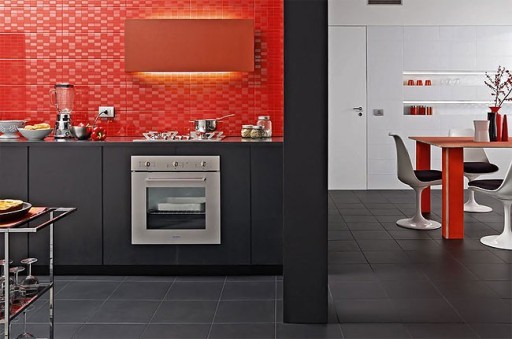
Mosaic effect tiles with correct selection lighting surprises with the play of colors and shades
- You can create an apron divided into zones. For example, lay out over the stove and sink decorative tiles, and over working surface countertops - simpler tiles, without distracting elements.
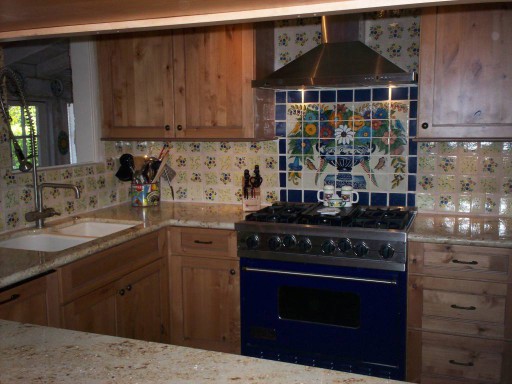
The design of the apron with division into zones has an additional decorative effect
- Pragmatic natures who have chosen the design of a kitchen apron using ceramic tiles are advised to select tiles without a clear relief. Unwanted dirt can accumulate in the recesses. Tile joints it is worth varnishing or making it as narrow as possible.
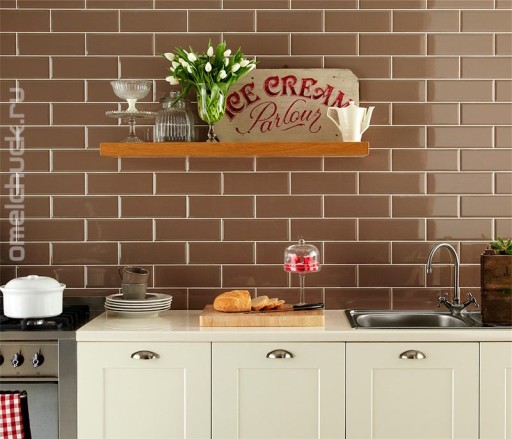
Brick tiles as a design option for a kitchen apron are steadily popular.
- Tiles should not be chosen “tone on tone” to the wallpaper, it is better to play with the color scheme. Perhaps you should stop at a contrasting or darker version. IN small kitchens- on a lighter one.
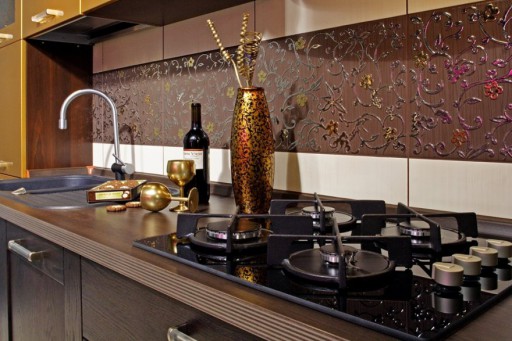
Vinyl stickers will decorate ordinary tiles whimsical graceful patterns
Glass panel - skinali for the kitchen
Since ancient times, glass has been attracting people's eyes - remember at least the magnificent colored stained-glass windows of cathedrals and the subtle elegant creations of Murano glassblowers. That is why, when the design of a kitchen apron is important for a person, he opts for glass. The glass apron looks elegant, and at the same time functional and practical. The surface of the wall is smooth, kitchen dirt does not linger on it, and since the glass is tempered, it does not crack from temperature and shock.
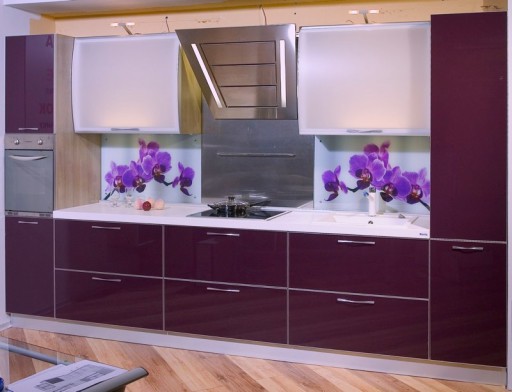
Bright prints on the apron can play the role of accents in the interior of the kitchen
There are two main modifications of the glass apron, their difference is in the transparency of the material. Matte strained glass used for kitchen aprons with backlight, and back-painted - to create outstanding design.

The use of backlight reveals practically unlimited possibilities for design experiments
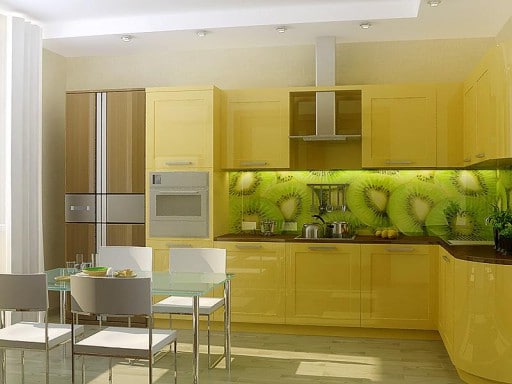
fashion trend on the Russian market- glass aprons with flowers, on maritime theme, with fruits
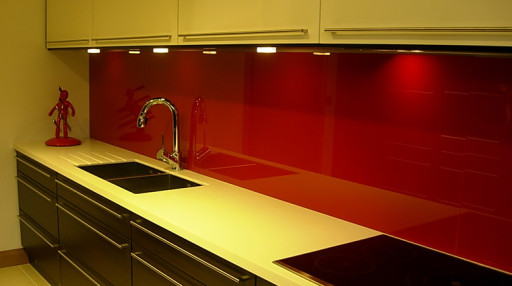
In Europe, glass aprons with abstract, intricate patterns, or plain ones that do not distract attention from the important cooking process are popular.
A small drawback of a glass apron is that it is always necessary to create it to order. The project must be meticulously small parts thought out. After all, if after a while you want to outweigh the rails or move the hooks for tableware, you will not succeed.
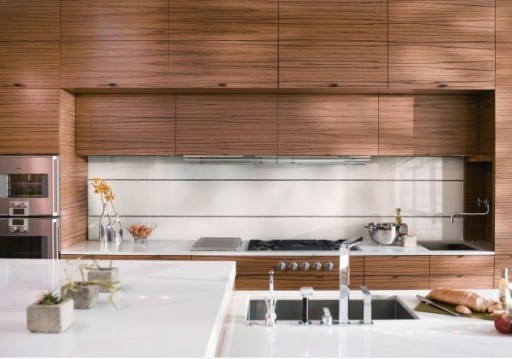
The glass apron looks exquisite, and at the same time it is functional and practical.
Also, the glass at the corners will be rounded, sometimes it does not fit into overall design kitchens. With the method of fastening a glass apron with clips, the same problems may arise with these fittings.
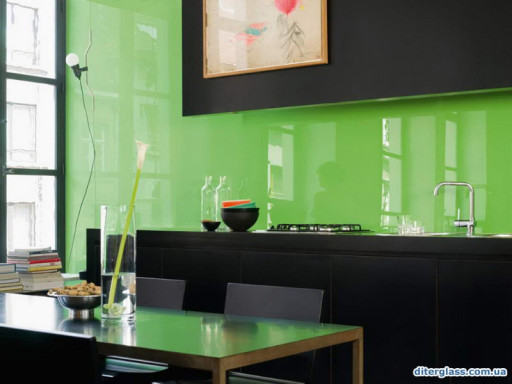
In the interior design of this kitchen, a glass apron was used.
Glass, however, can be glued to most necessary elements- shelves, supports, etc.
Ornament or mosaic
Mosaic used to decorate the walls in the castles of the aristocracy. Therefore, the design of the apron in the kitchen using small ceramic or glass tiles looks dignified, elegant and makes the owners feel like residents, if not royal, then princely palace. Mosaic looks great in the interior classical style, on either modern kitchen with glossy furniture fronts.

glass mosaic, selected for color scheme kitchen, looks harmonious and noble
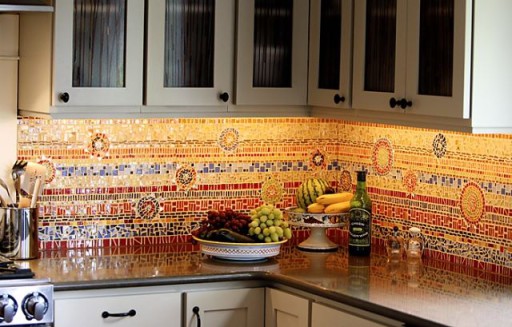
The visual effect of expanding the space can be obtained by using a small mosaic to decorate a kitchen apron.
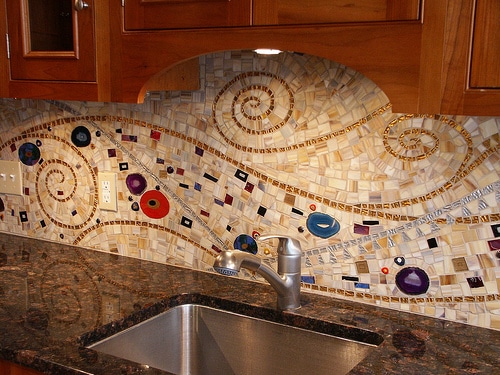
It is preferable that the colors of the mosaic ornament are in harmony with the interior, for example, with a pattern of curtains or towels.
MDF panels and laminate on the apron
Modern technologies allow you to change not only the tiles in the bathroom, but also ceramic tiles- on durable and beautiful MDF panels. True, they are not so strong and durable, but they look decent. Especially when the texture resembles smoothly planed and perfectly laid wooden planks. Or, for example, wonderful in the kitchen with stone countertops look kitchen aprons made of MDF "under granite", "under malachite", "under marble".

Laminated apron for the kitchen is one of the most popular design options.
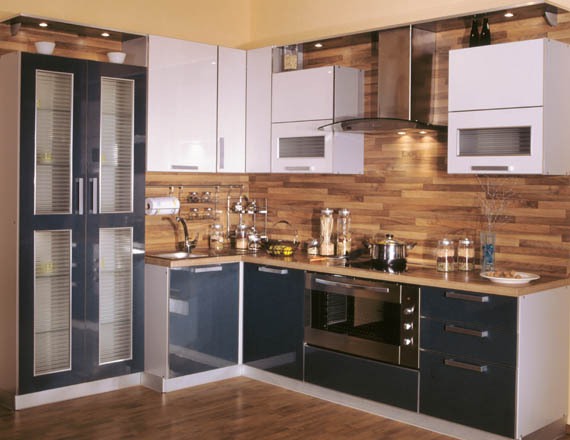
MDF panels for wooden planks look spectacular, but require more careful care
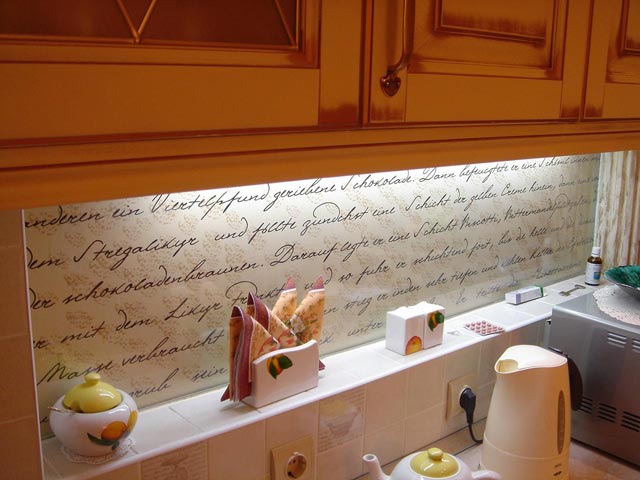
Inventive and light natures will like MDF panels with designer drawings
metal panels
Metal plates for an apron are suitable for high-tech style, which implies the presence of furniture and household appliances with shining metal surfaces.

Metal mosaic is one of the most spectacular ways kitchen apron designs
The metal for the apron is aluminum, steel, tin sheets - durable and moisture resistant. However, metal is more difficult to care for, and therefore they should be chosen for kitchens whose owners prefer to order food or do not like to cook.
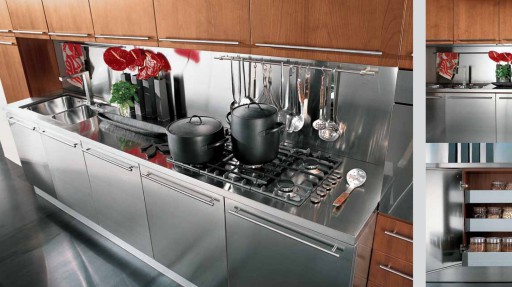
In some cases, it is advisable to use a one-piece metal apron
Designers say that metal in the interior of the kitchen perfectly complements light wood, glass and plastic. Be sure to think over the lighting, otherwise you may be disturbed by a host of sunbeams and glare.
Plaster - simple and useful
The oldest method of wall decoration does not lose its relevance. If you have only linen towels, ceramic dishes, plants everywhere in your kitchen, then you know that only plaster can absorb harmful substances. carbon dioxide released during frying. Do not forget that the plaster is hygroscopic - it tends to accumulate moisture - therefore, near the sinks, the kitchen apron should still be made from a different material.
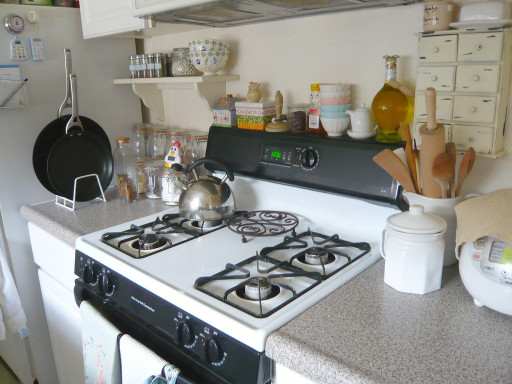
Most economical option an apron does not always contribute to maintaining cleanliness and order
Stone in the kitchen interior
Stone - another old way of decorating kitchen wall. If the mosaic could be found in the kitchens of the nobility of the Victorian era, then the stones were found in the medieval earls. Today, a stone apron is also found only in elite houses, since the cost of laying and trimming suitable stones high.
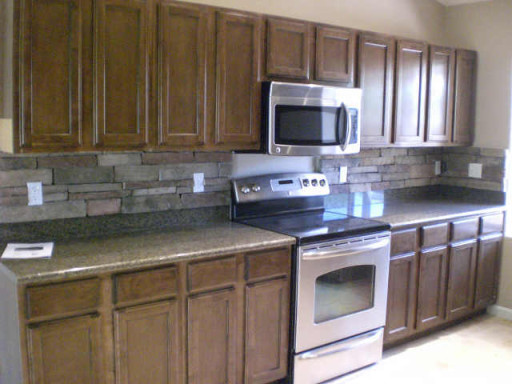
natural or fake diamond also works well as a kitchen apron
A stone apron fits into certain rugged interiors with a hint of naive (or eco-friendly) style.
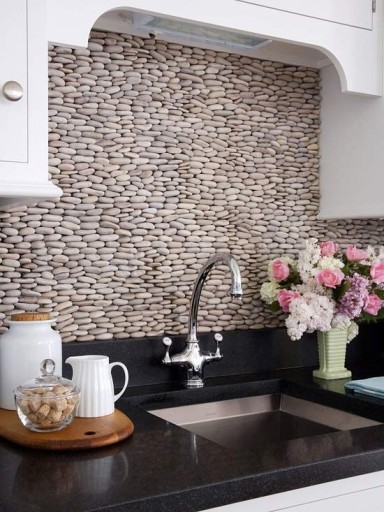
Pebble mosaic - spectacular and unusual way kitchen apron designs
Complements harsh stone aprons wooden furniture no frills, but lace or embroidered potholders, towels, tablecloths, napkins will help smooth the impression.
An apron is a part of the wall between the upper and lower cabinets. kitchen set. Its task is to protect the wall from moisture, hot steam, grease, splashes and any pollution. beautiful apron will stretch even an ordinary interior, and an improperly selected one will spoil the impression of expensive kitchen facades. To make it easier for you to choose, we have compared the most practical and spectacular options finishes of six important criteria. Which apron to choose for the kitchen, a comparison of popular materials, designer tips and photos of kitchen aprons - in this article.
Quick navigation:
Optimal dimensions
Usually the height of the apron in the kitchen varies from 45 to 60 centimeters. How high it should be in your case depends on the height of the household, the type of stove and the type of headset. So, it is more convenient for a low hostess to hang the upper modules lower, and make the space between the cabinets small - 40-55 cm.
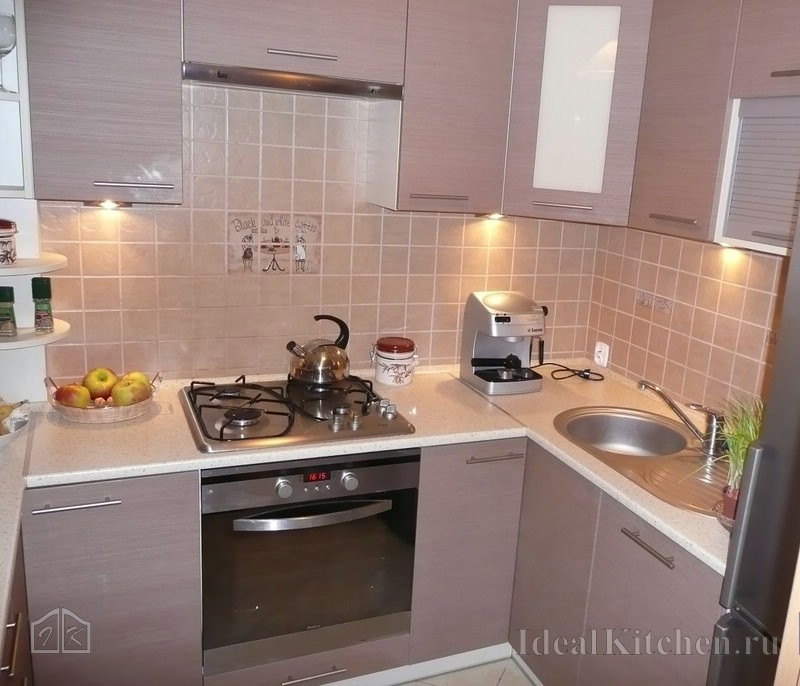 Between two tiers of cabinets left 60 cm
Between two tiers of cabinets left 60 cm 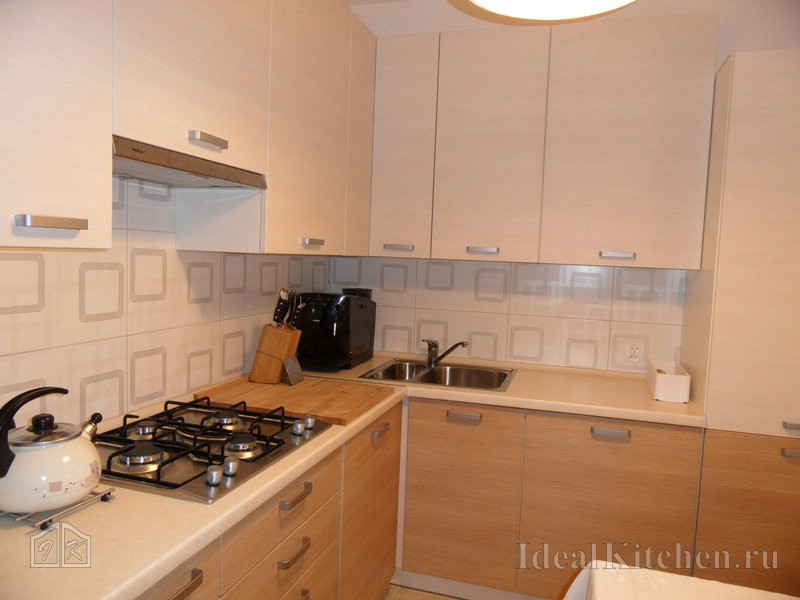 And there are about 40
And there are about 40 - in the kitchen with gas stove the distance between hob and the hood should be at least 75-80 cm. Provide for this in the design.
- Most often, the finishing material closes the entire wall along the countertop. If you wish, you can limit yourself to small protective inserts only in the sink and hob area.
- With absence wall cabinets it is worth decorating the wall to the ceiling.
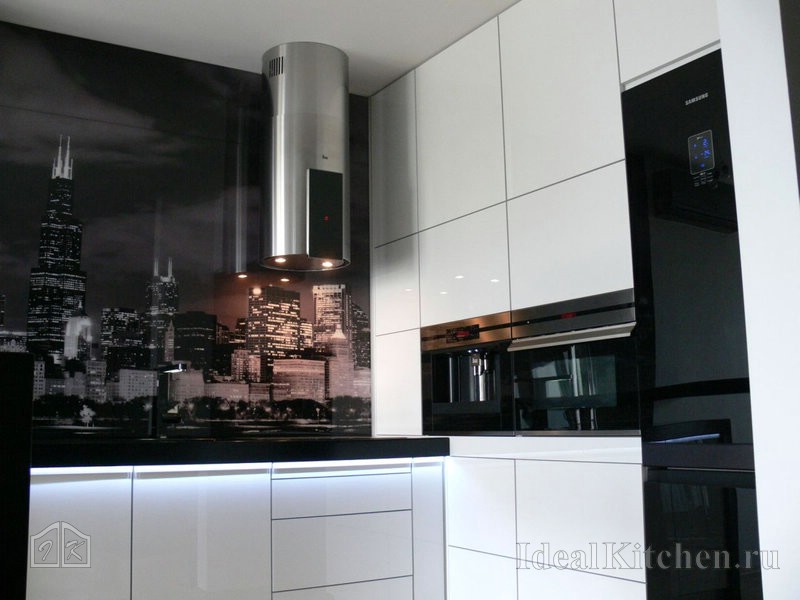 Idea for a little one corner kitchen without upper cabinets
Idea for a little one corner kitchen without upper cabinets The edges of the apron should go under the upper / lower cabinets for a couple of centimeters. It is desirable to protect the joint between the wall and the countertop with a plinth and process silicone sealant. Without it, water will flow floor cabinets. Back wall from fiberboard will swell and deform over time, and fungus will freely grow on the walls.
How to choose color and finish design
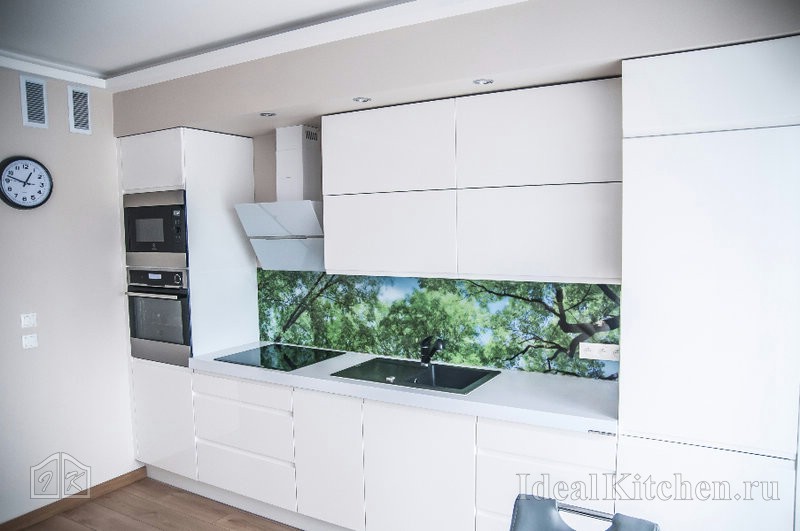
If the budget for repairs is limited, you can purchase an inexpensive set with simple facades, neutral wallpaper and flooring. But part of the wall kitchen area make it more expensive and turn it into an interior decoration.

WE RECOMMEND:
Types of aprons - pros and cons
From ceramic tiles
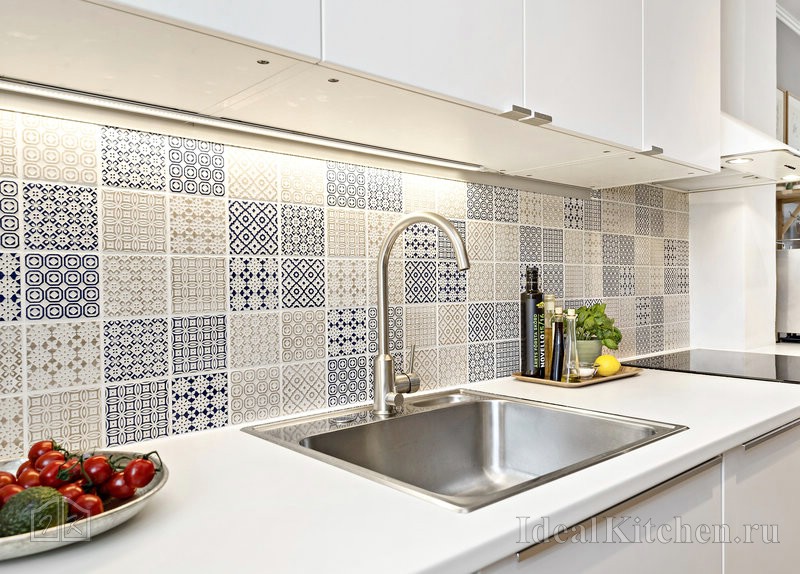
The best option in terms of price, quality, durability and convenience. In the decoration of the apron, glazed is more often used. tile, less often thin and light porcelain stoneware. The most popular formats are 10x10, 15x15 cm, 20x30 and 20x40 cm, as well as a different-sized "boar".
Ceramics have many designs for different tastes and every budget. Its surface can imitate the texture of stone, wood, metal, concrete. So, you will get a stylish, beautiful interior from interesting finish for reasonable money.
When choosing a tile for a kitchen apron, take a closer look at its texture: rough and embossed are difficult to keep clean, so you should give preference to smooth.
Examples of ceramic aprons in real interiors see the photos below:
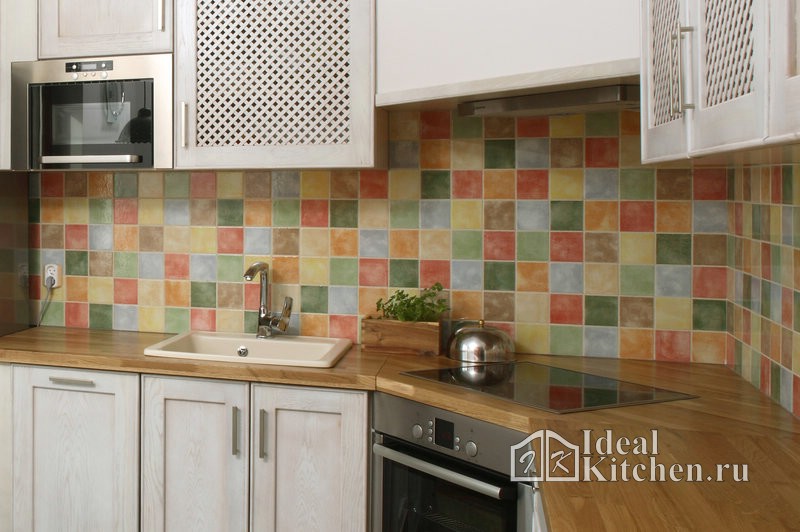
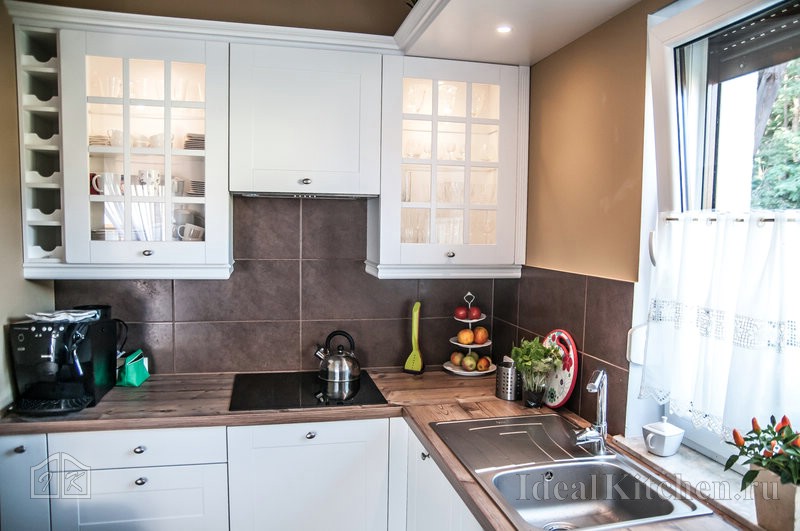

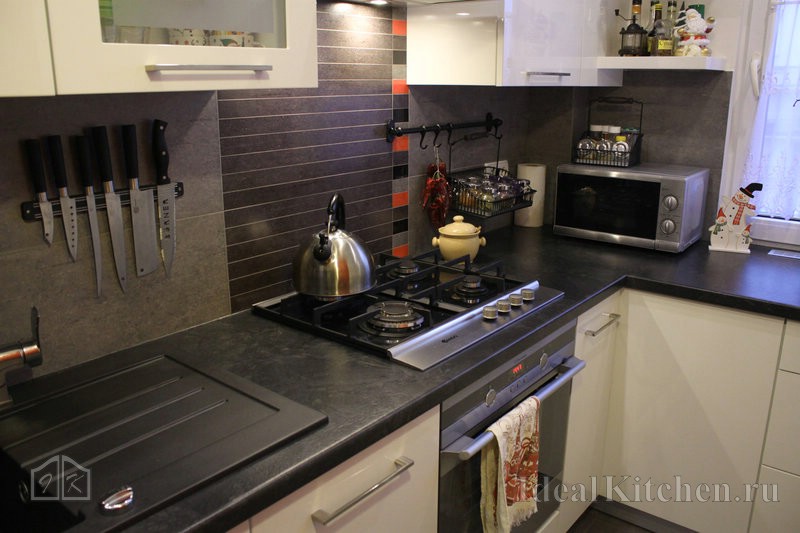

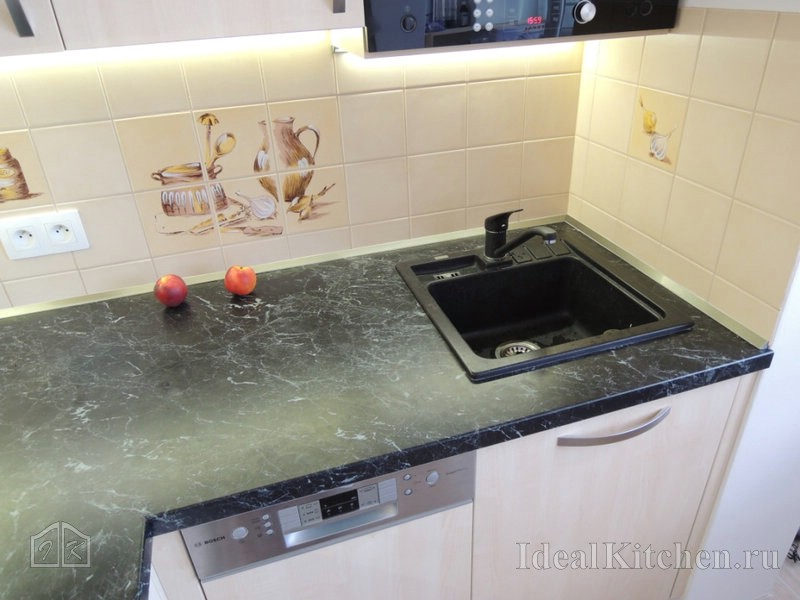
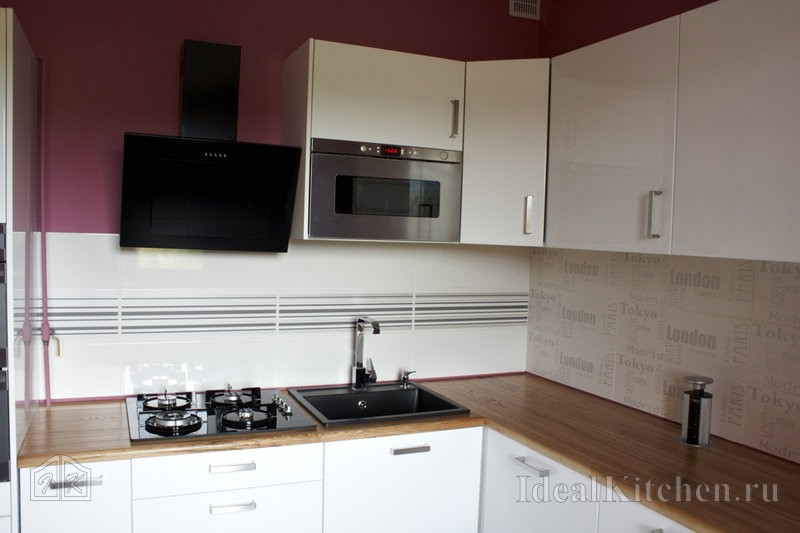
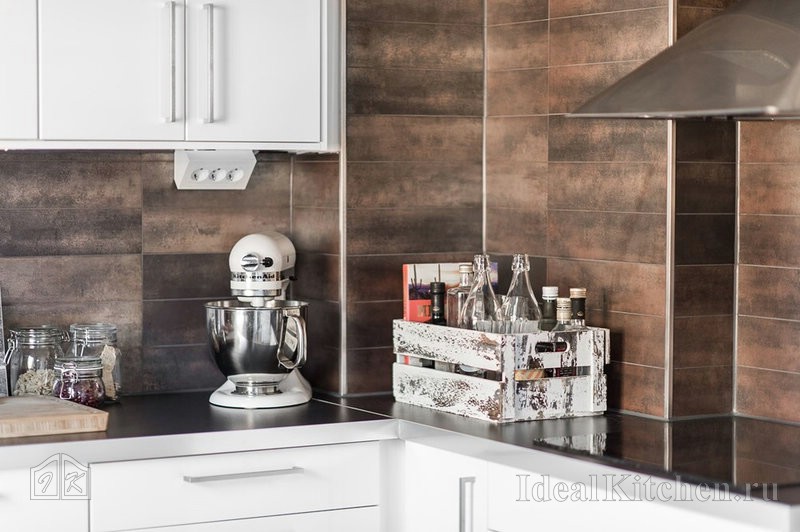
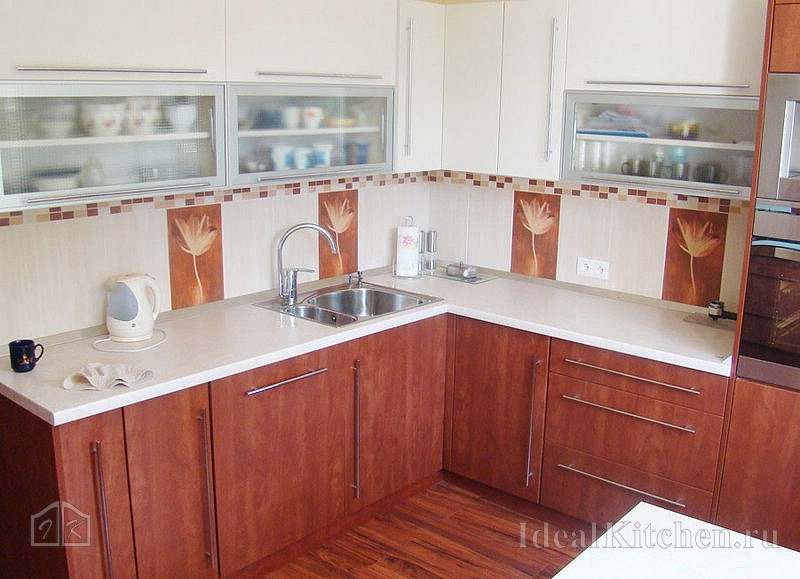
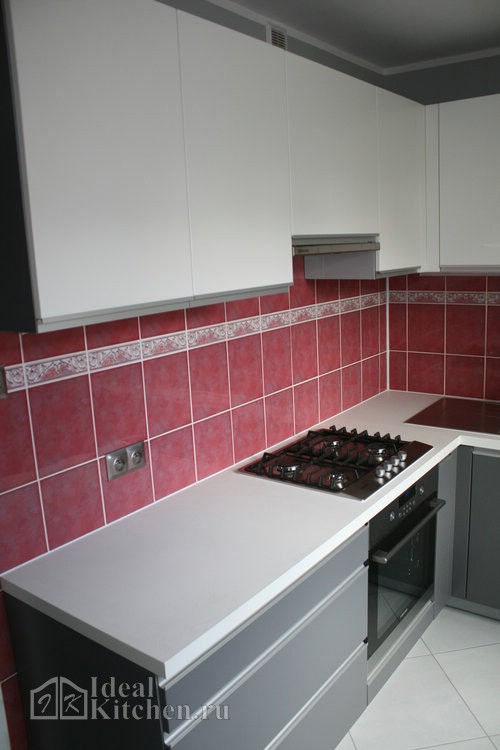
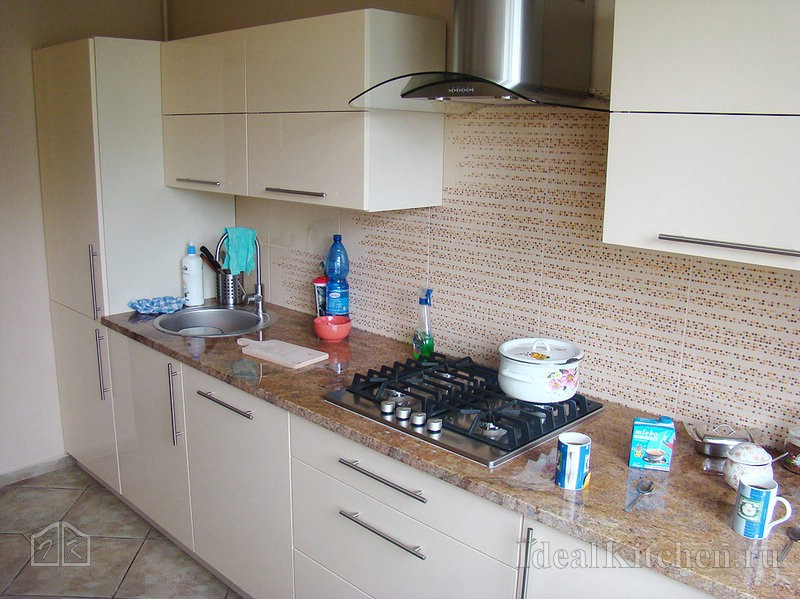
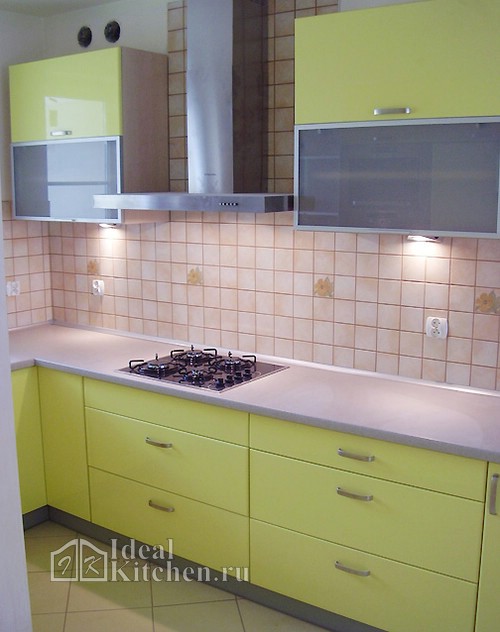
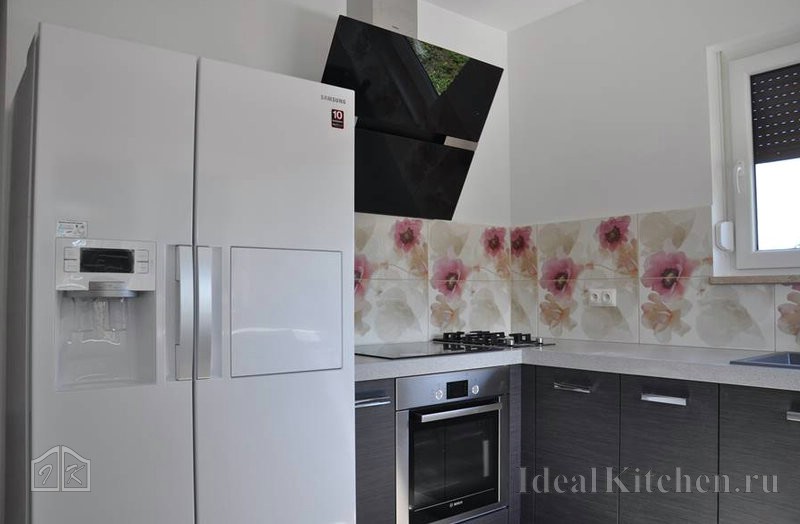
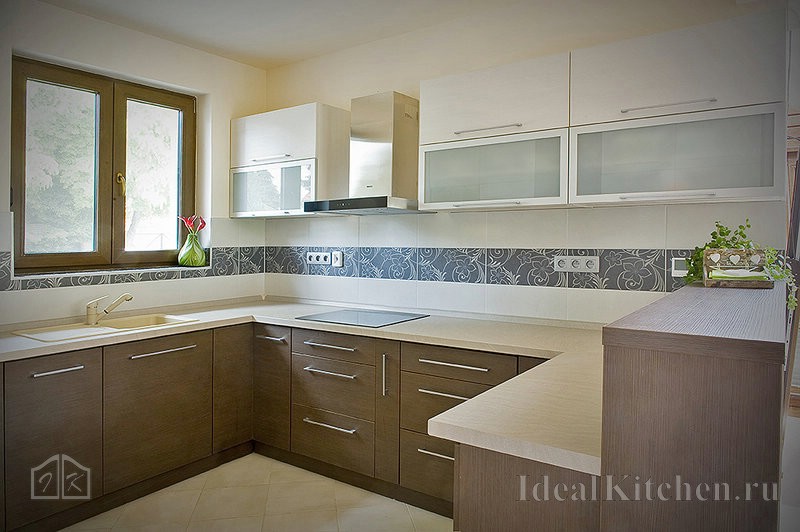
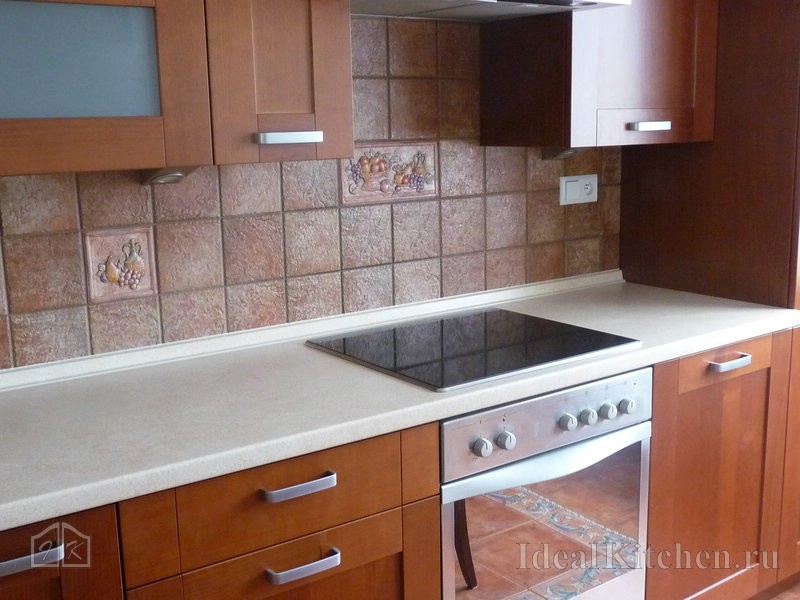
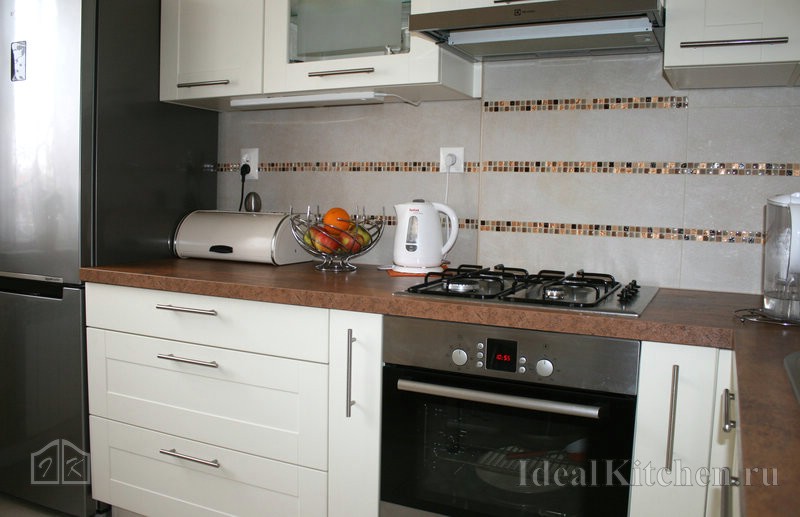
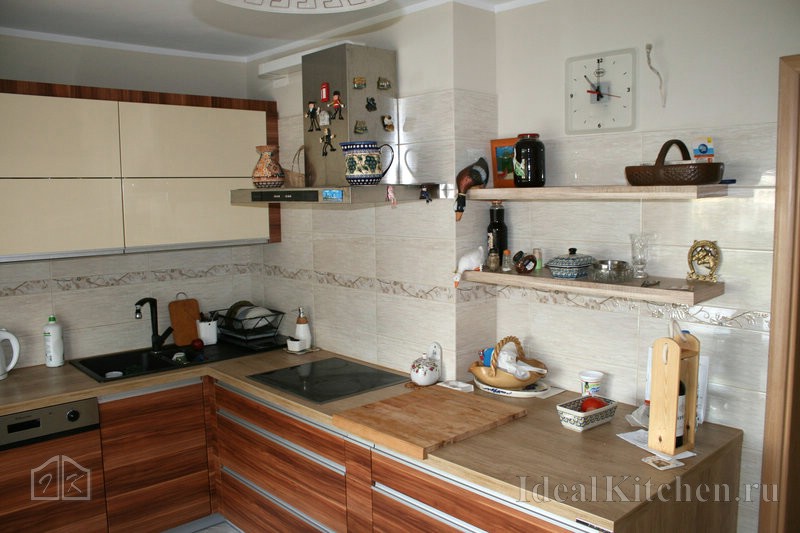


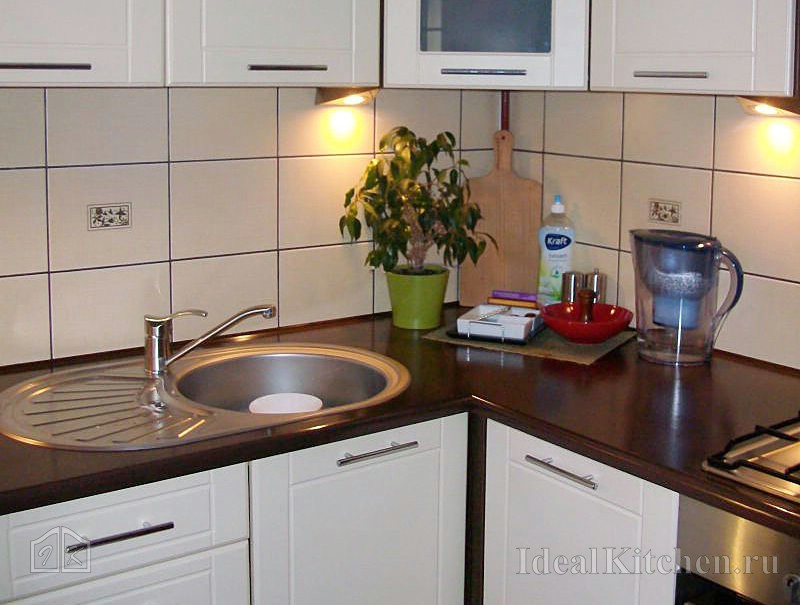
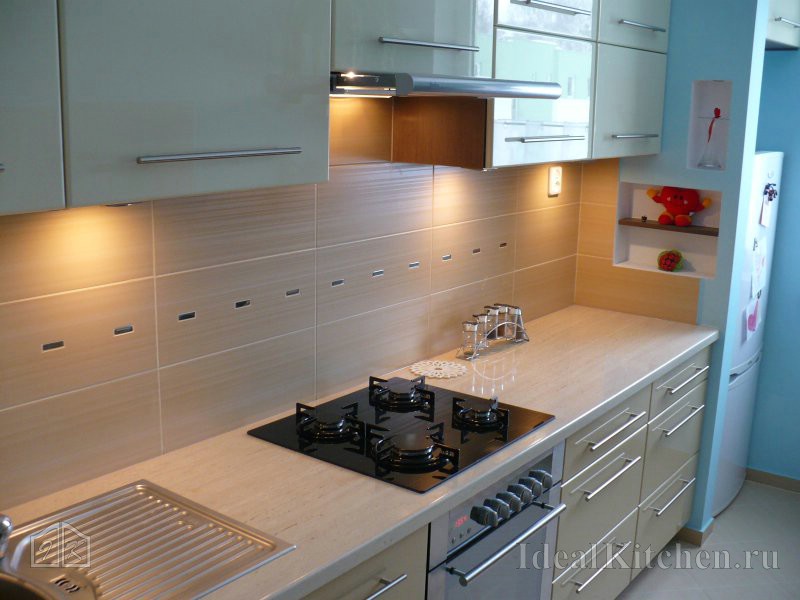
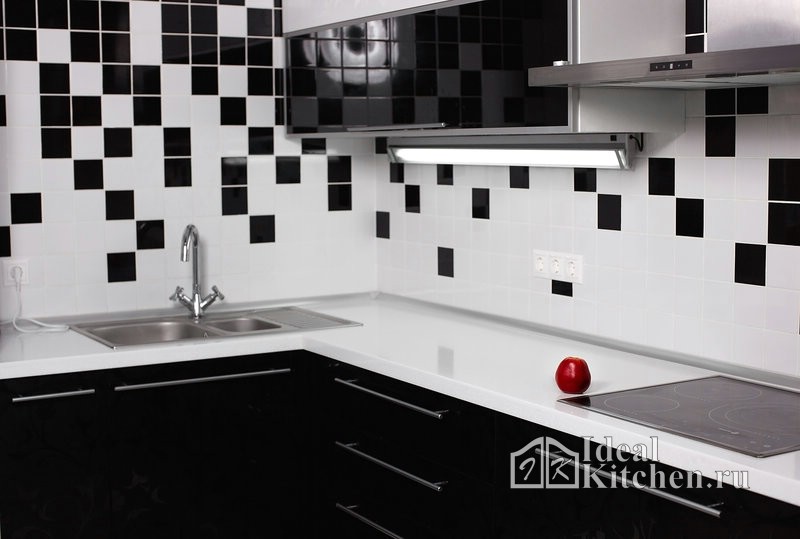
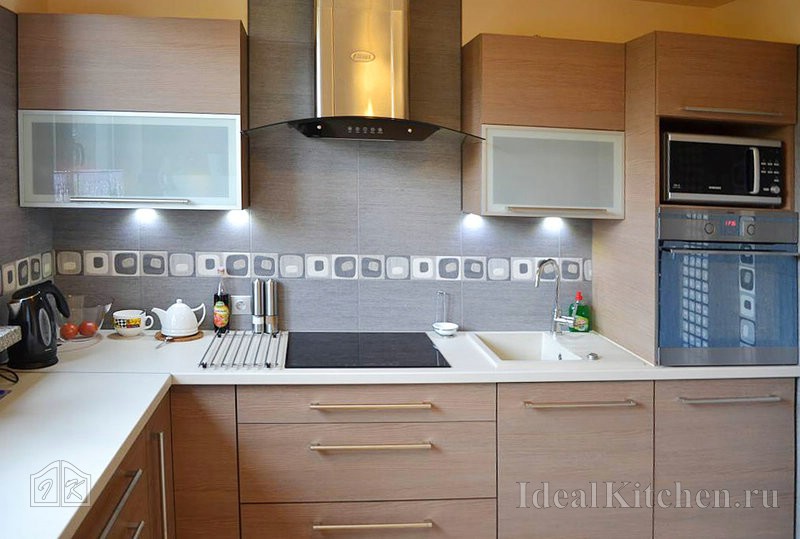
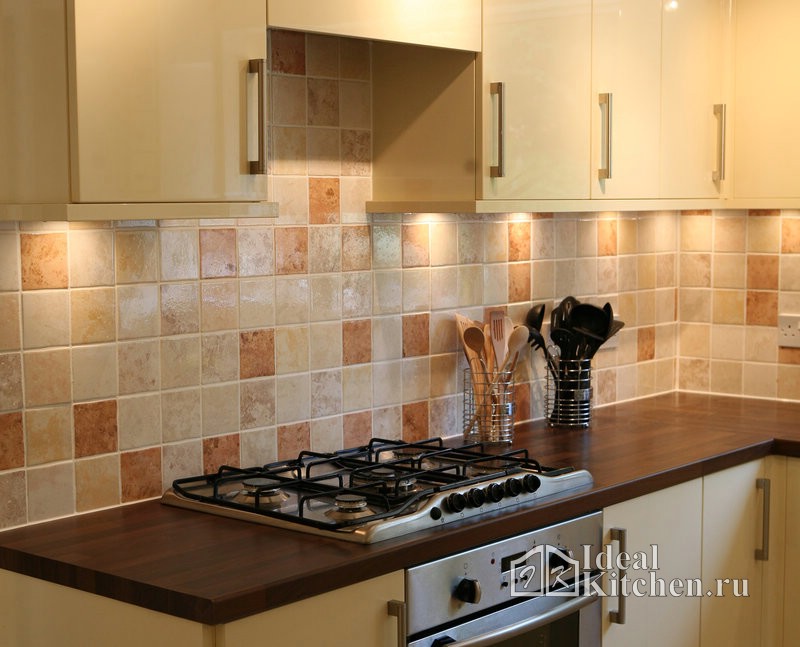
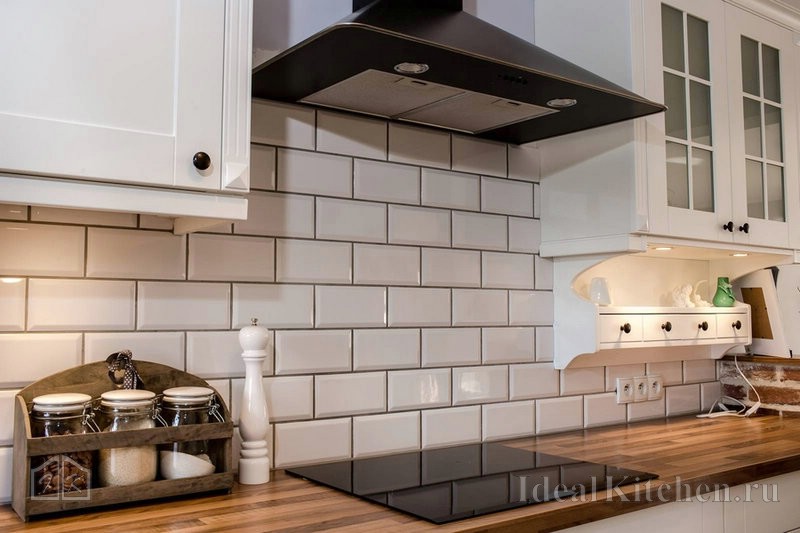
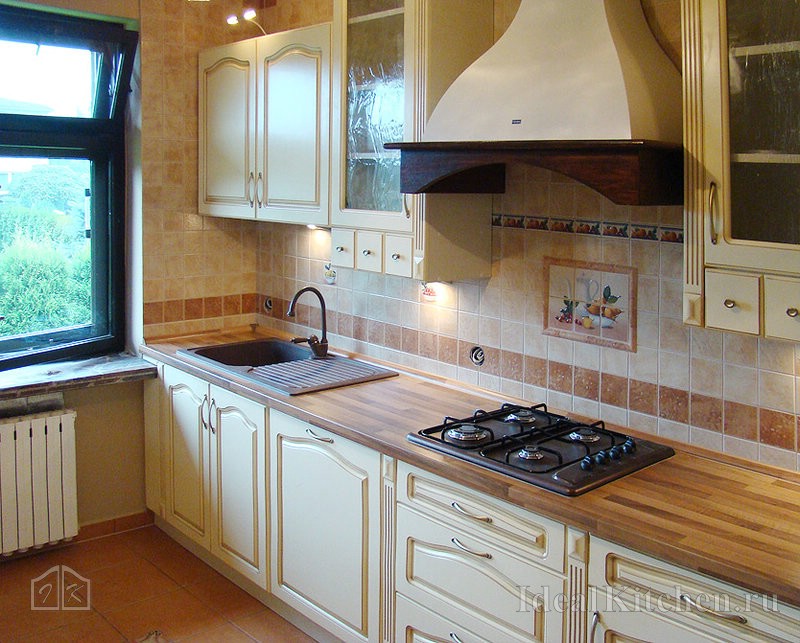
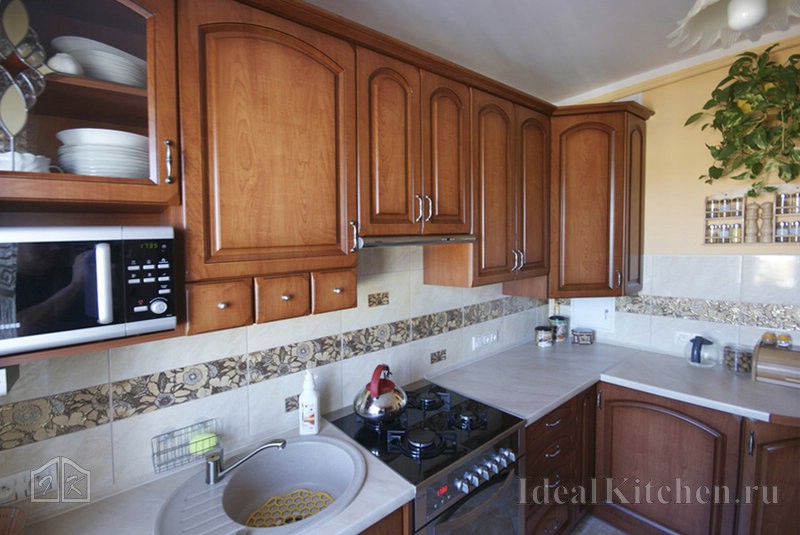
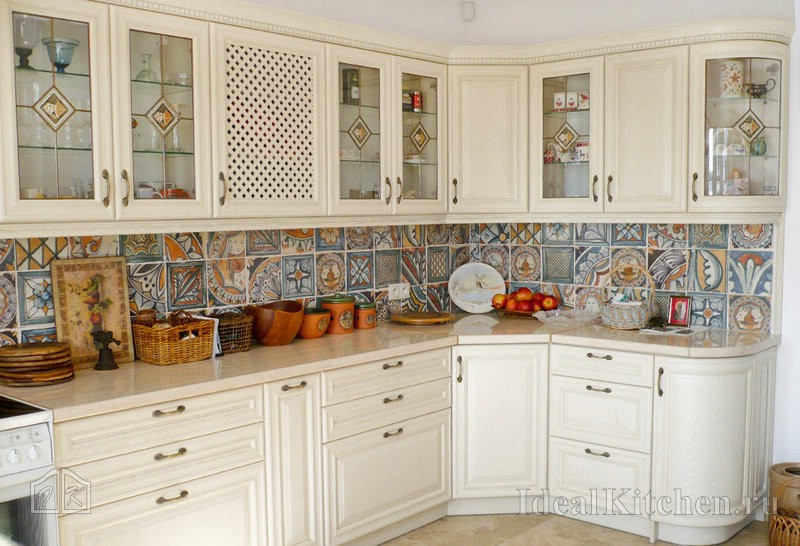
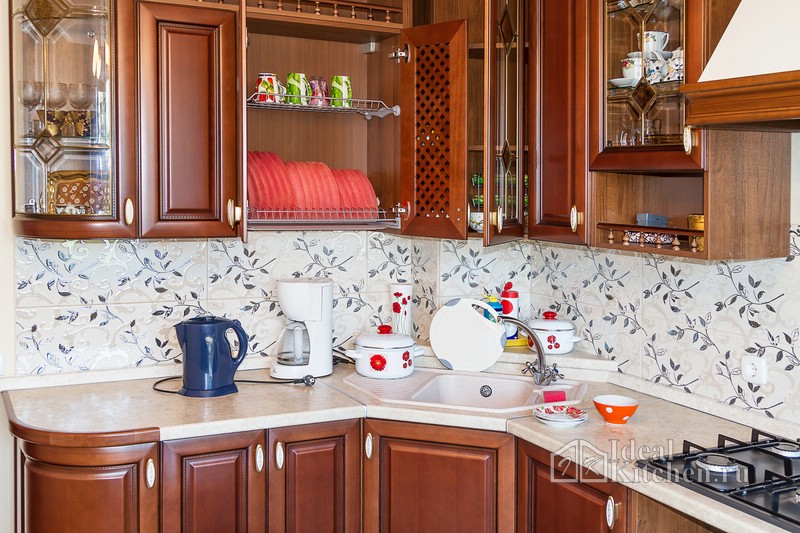
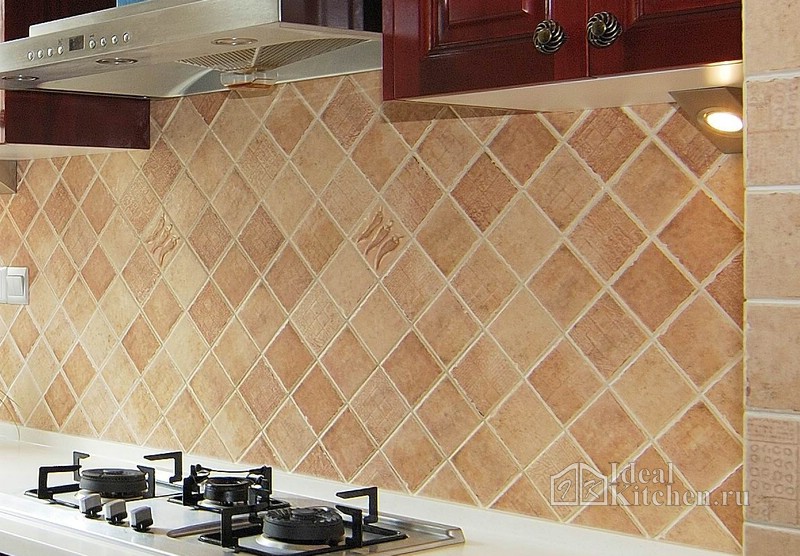
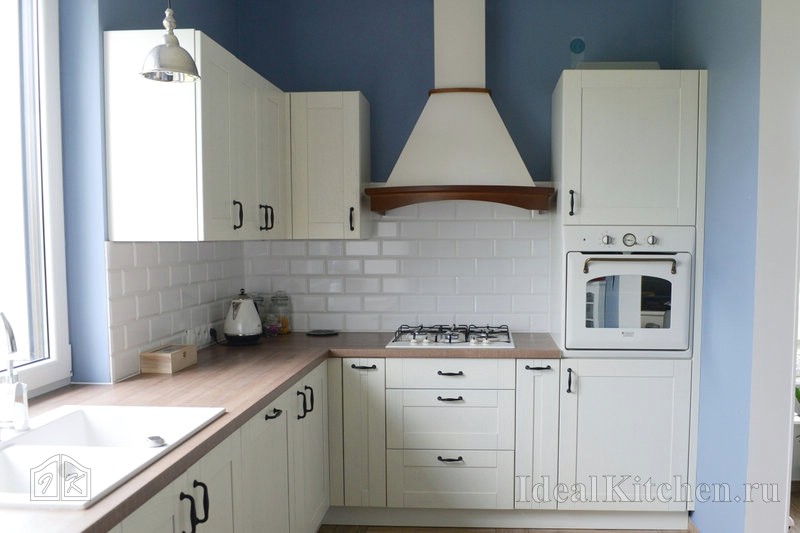

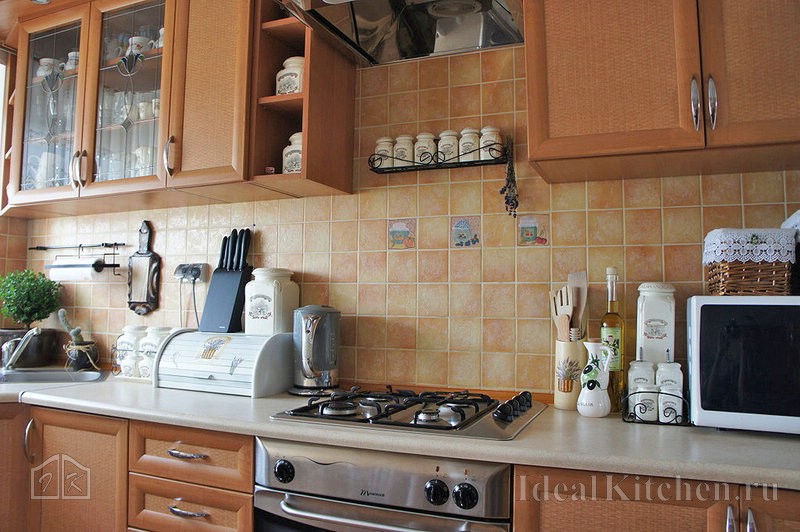
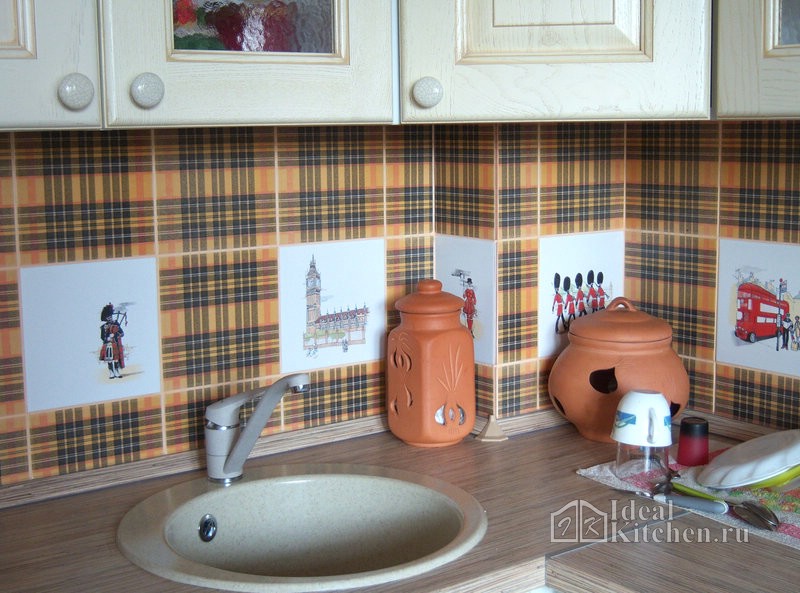

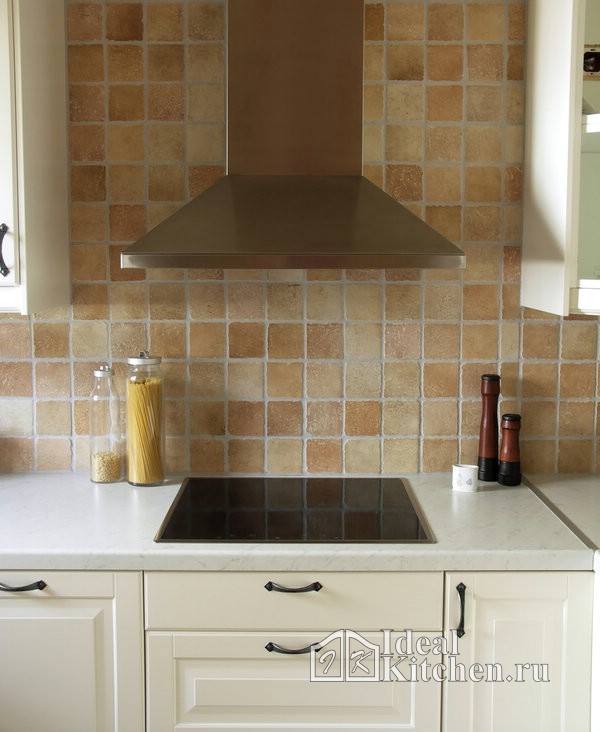
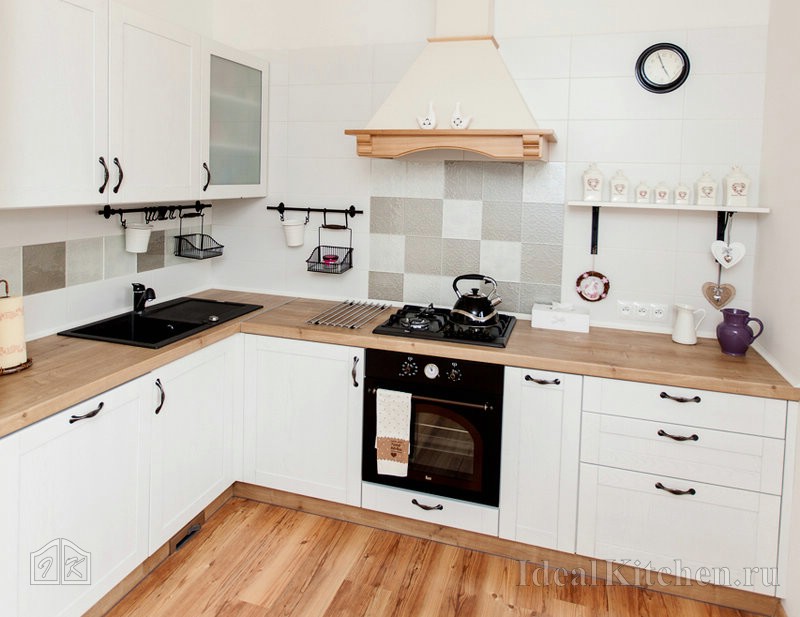
Price. Finishing an apron with tiles will cost more than plastic, but much cheaper than glass and acrylic stone. In addition to the cost of the material, do not forget to include the cost of leveling compound, tile adhesive, grout, sealant and craftsmen in the calculation.
Mounting . Laying should be entrusted to a professional. The work area is always in the spotlight, and laying tiles flawlessly without experience is not easy. Important point: ceramics is for a long time. If you don’t like the design of the tile, changing the apron will not be easy.
Training . Requires extensive surface preparation. Curved wall will have to be leveled.
Durability . A kitchen apron decorated with ceramic tiles will easily serve you for 15 years or more.
Moisture resistance. ★ ★ ★ ★ ★
Care . ★ ★ ★ ★ ★
You can use detergents, including those with light abrasives. Tile joints require special care. Ordinary light grout darkens over time and looks untidy. To avoid this, use an epoxy that does not change color.
From photo tiles
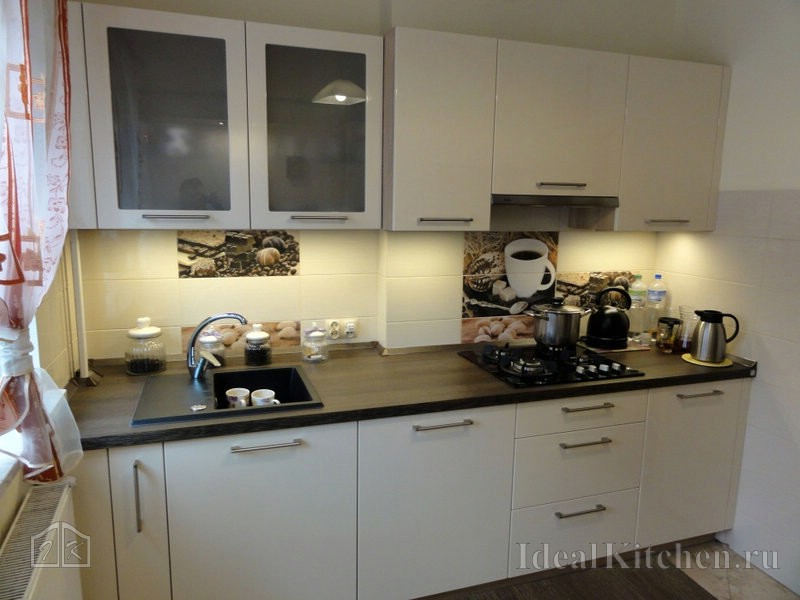
You can limit yourself to factory decors with photo printing (available in the collections of most major manufacturers) or make photo panels to order. Most of the pros and cons of this type of finish are the same as those of ordinary tiles. But note a few significant drawbacks:
- the price of photo tiles is much higher than conventional collections
- inexpensive sublimation-printed ceramics fade and fade in the sun over time, and the decal costs twice as much
- does not like aggressive household chemicals, especially with abrasive elements
- factory-made photo decors are more durable and stronger than custom-made ones
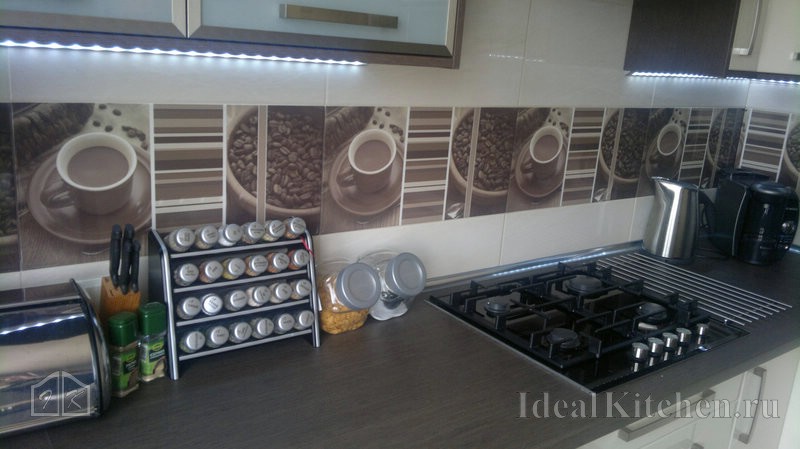
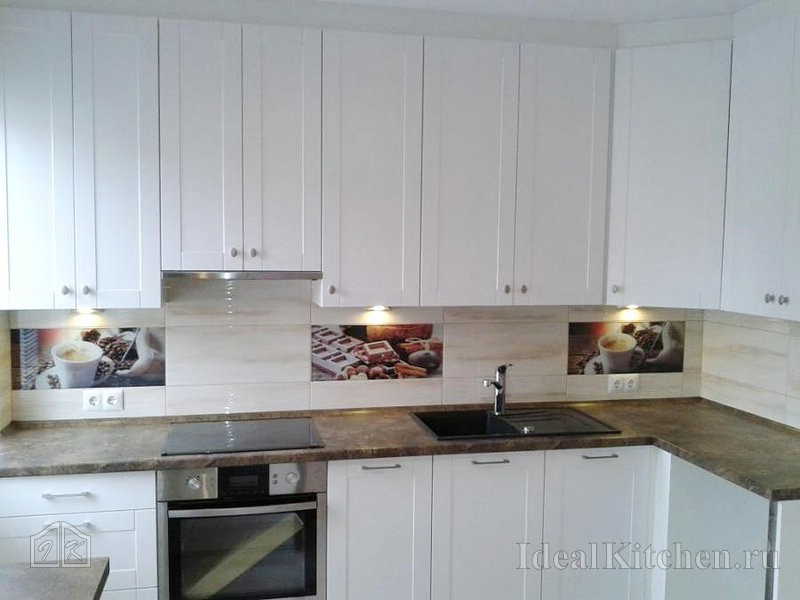
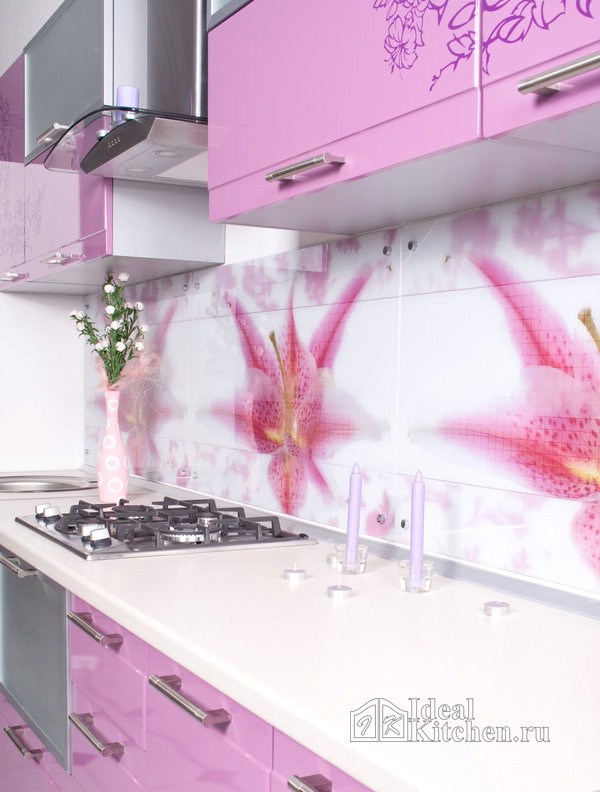
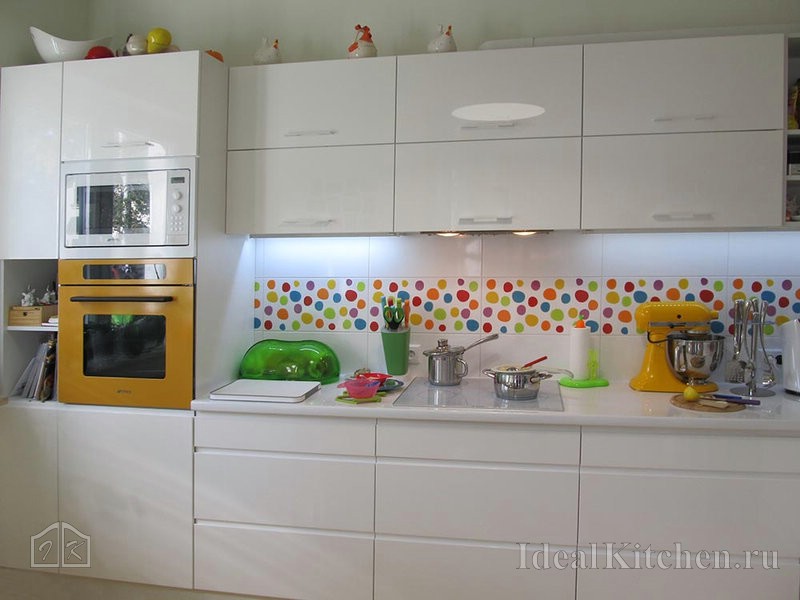
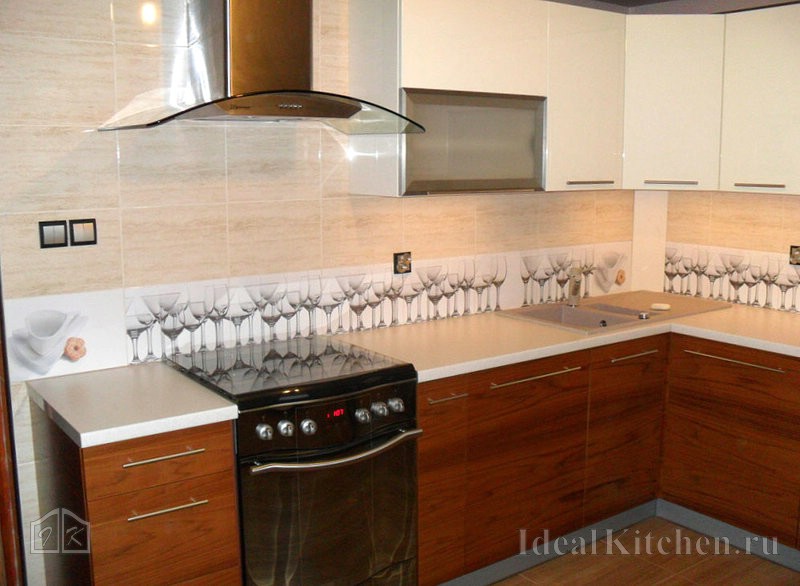
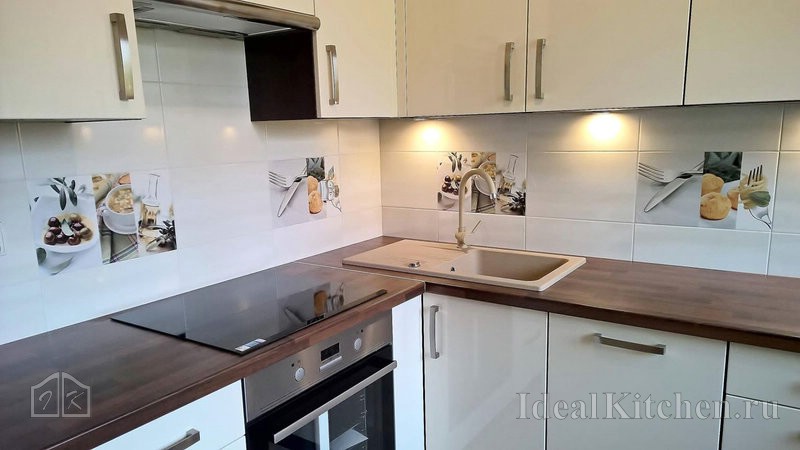
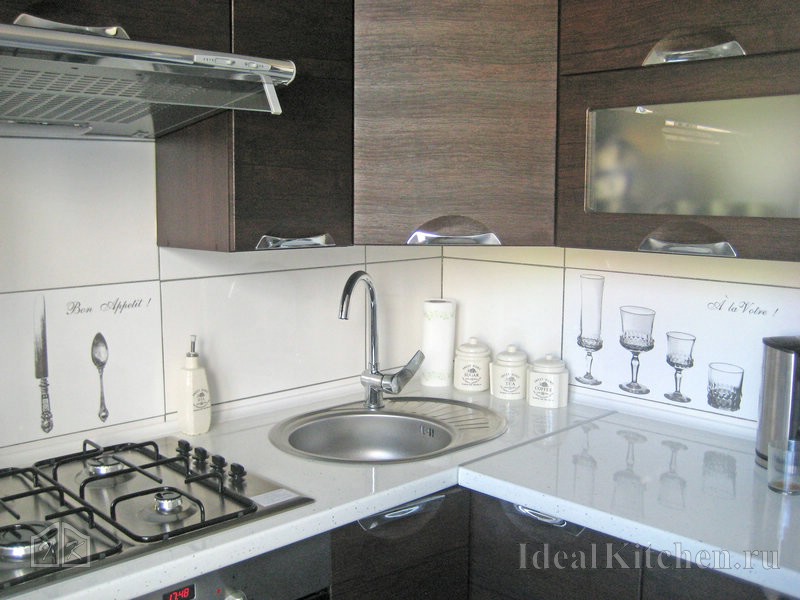
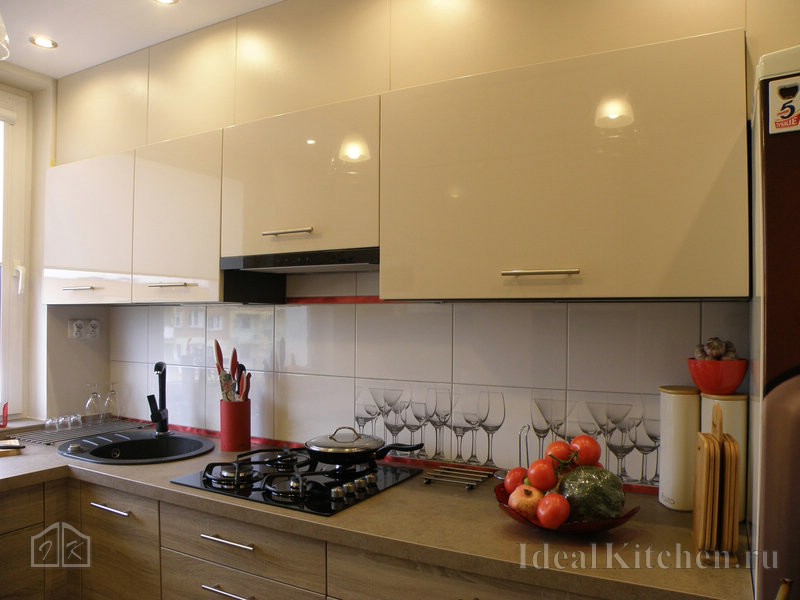
From glass
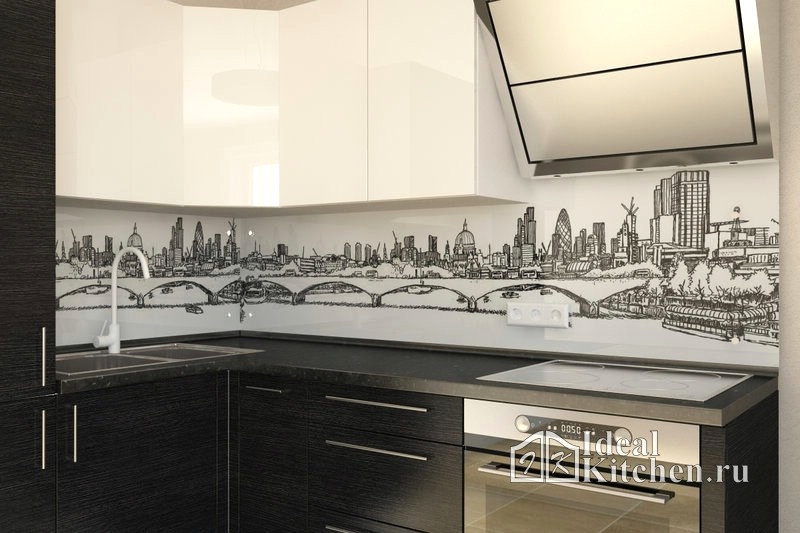
Beautiful and practical finish, which in many properties is not inferior to the tile. They were easier to care for than it is commonly thought, and heat and moisture do not spoil them in any way. appearance. On the kitchen apron, durable tempered glass with a thickness of 6 and 8 mm is used with different designs: transparent, painted, tinted, frosted and decorated with photo printing.
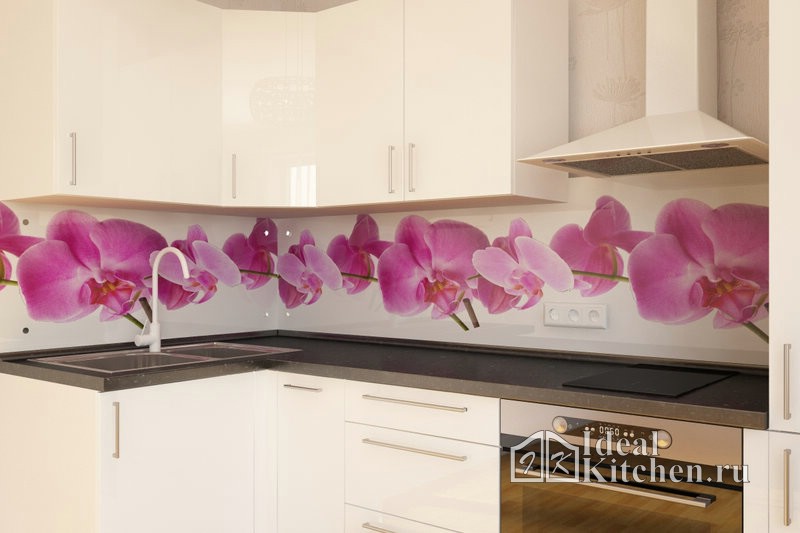
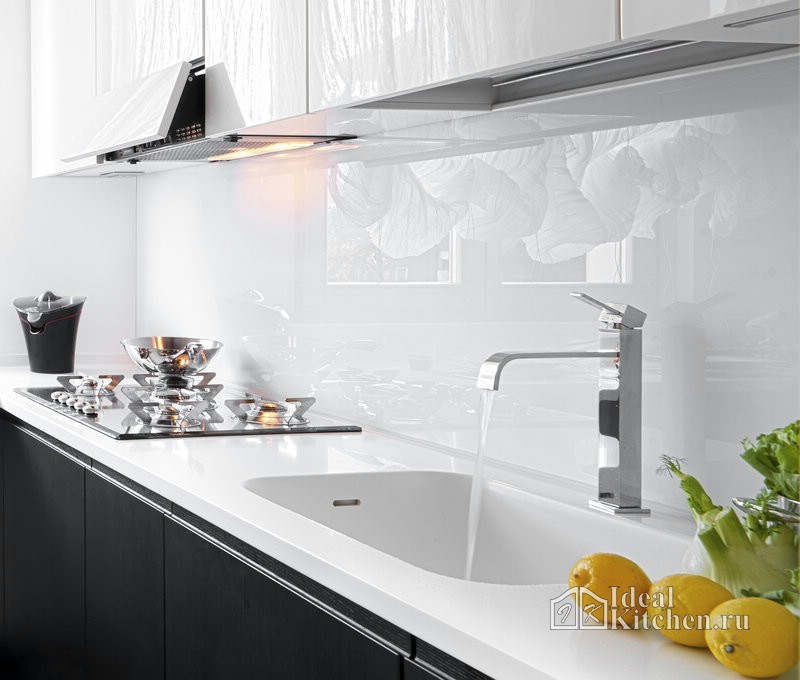
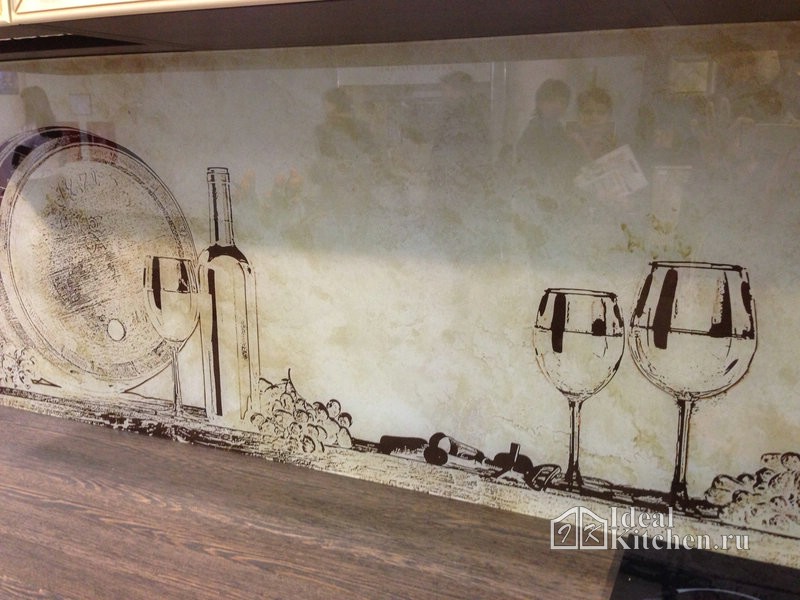
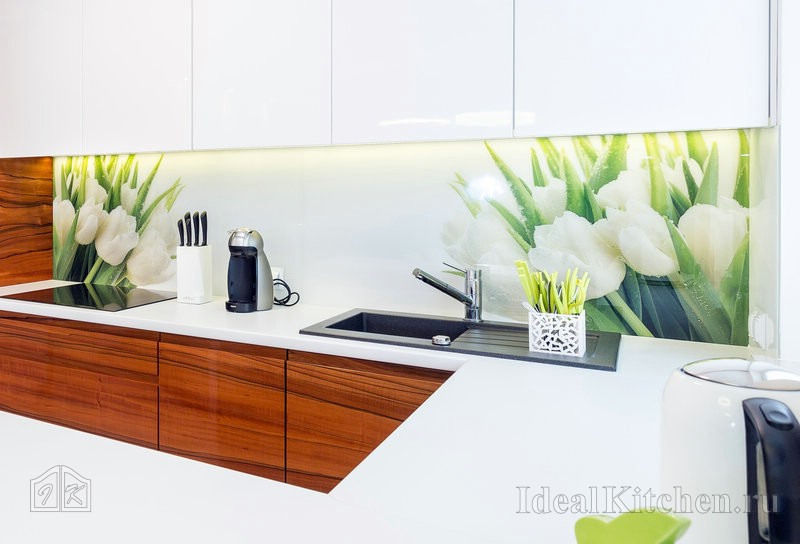
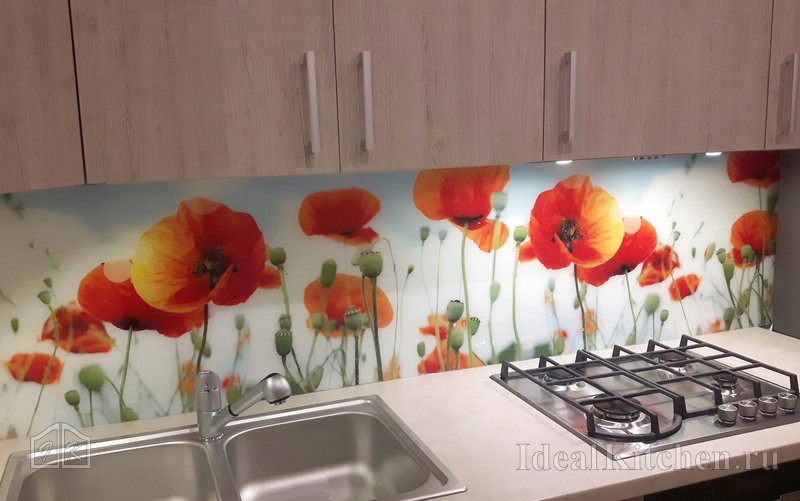
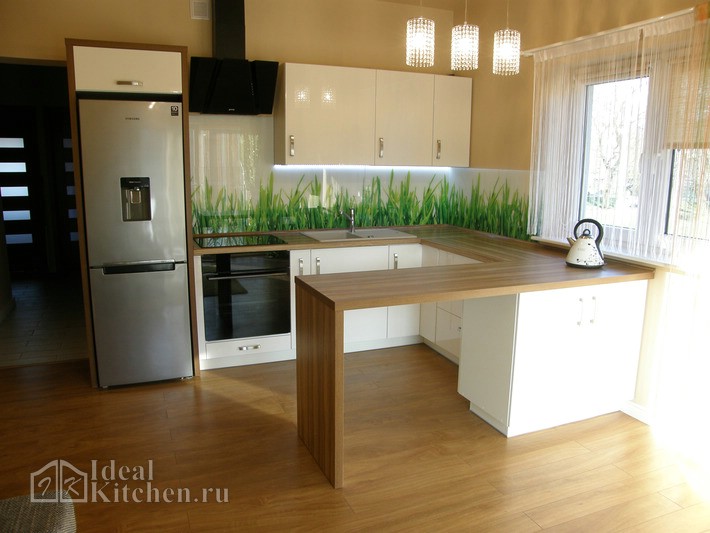
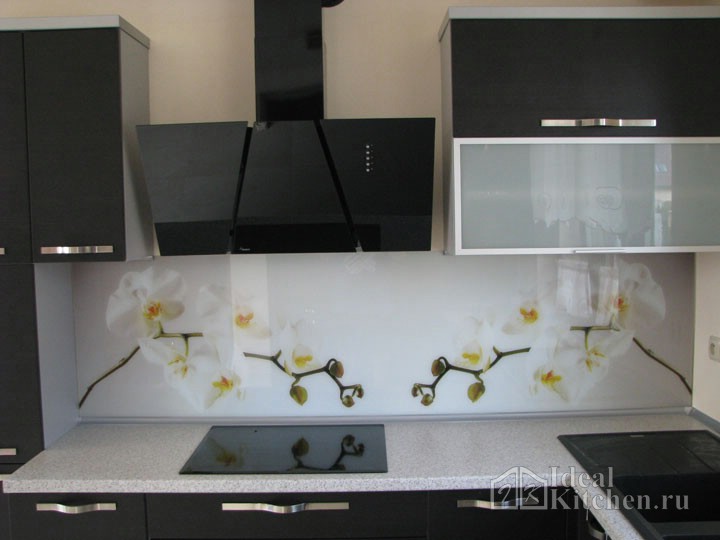
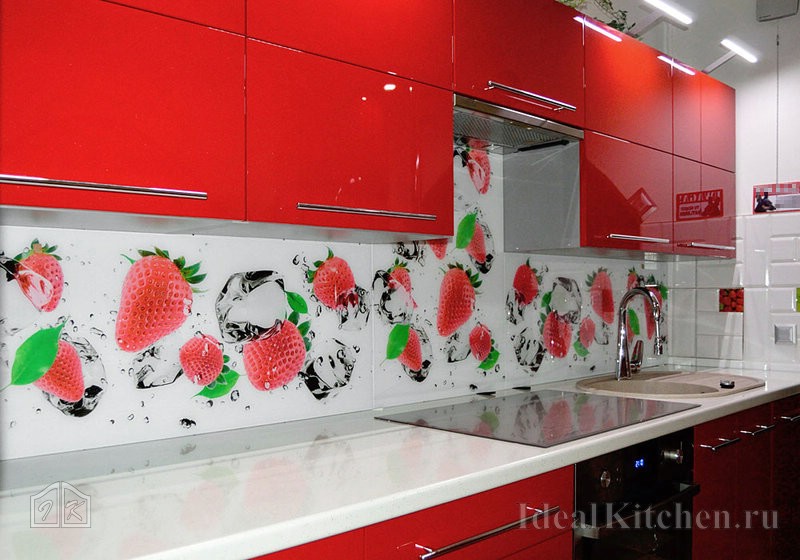
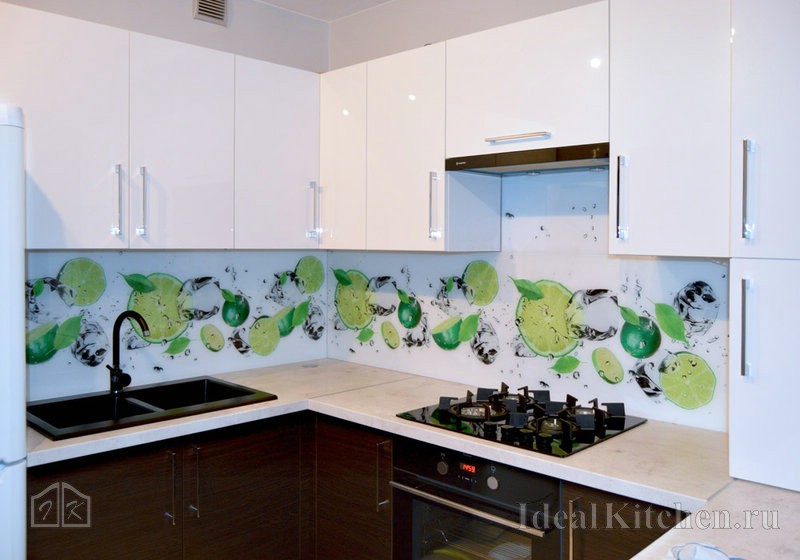
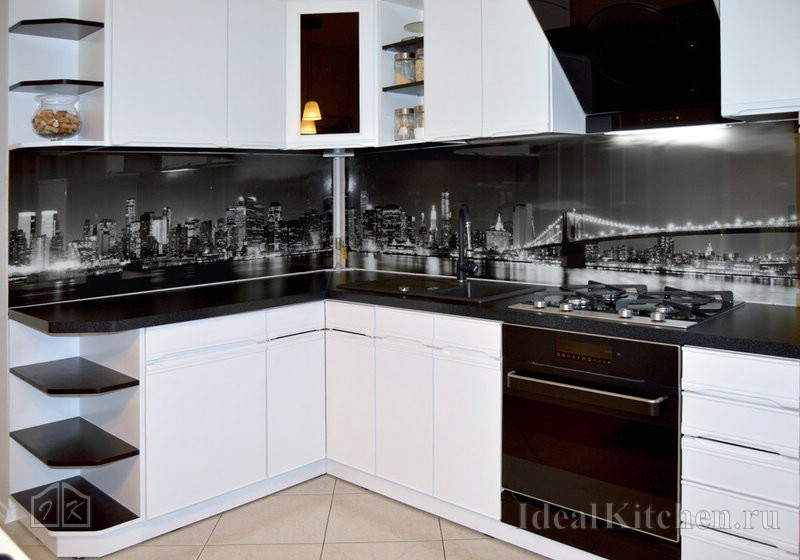
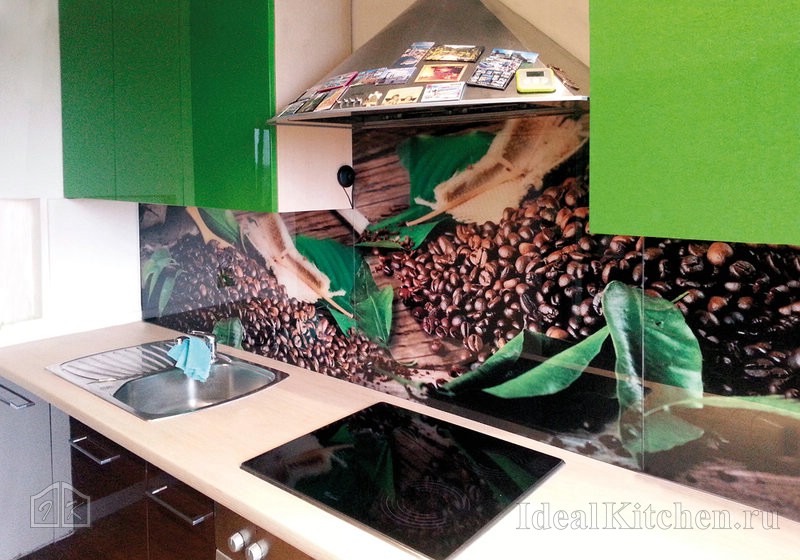
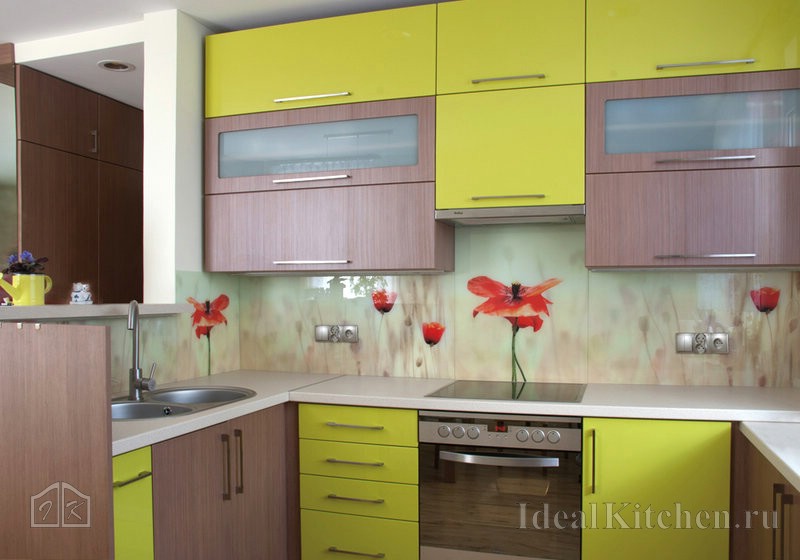
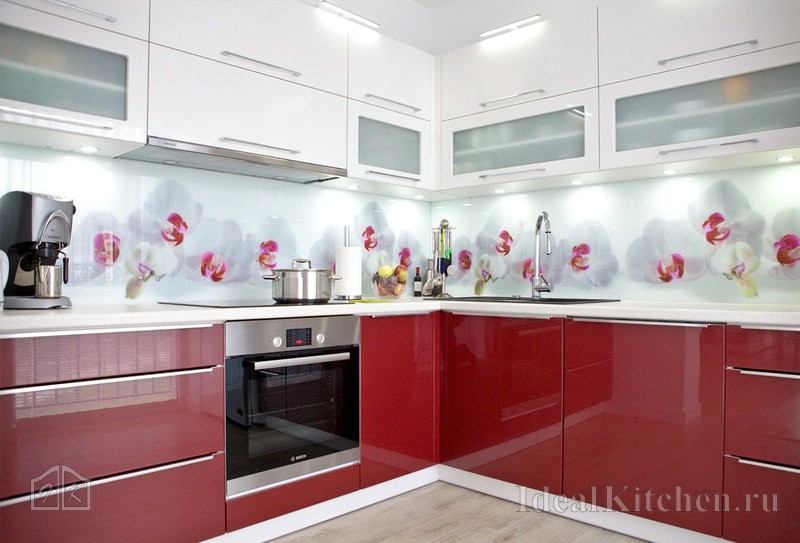
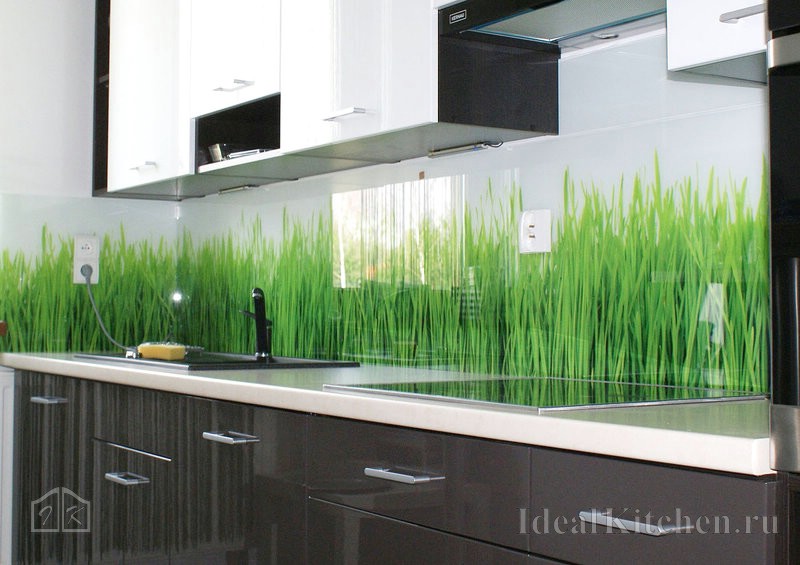
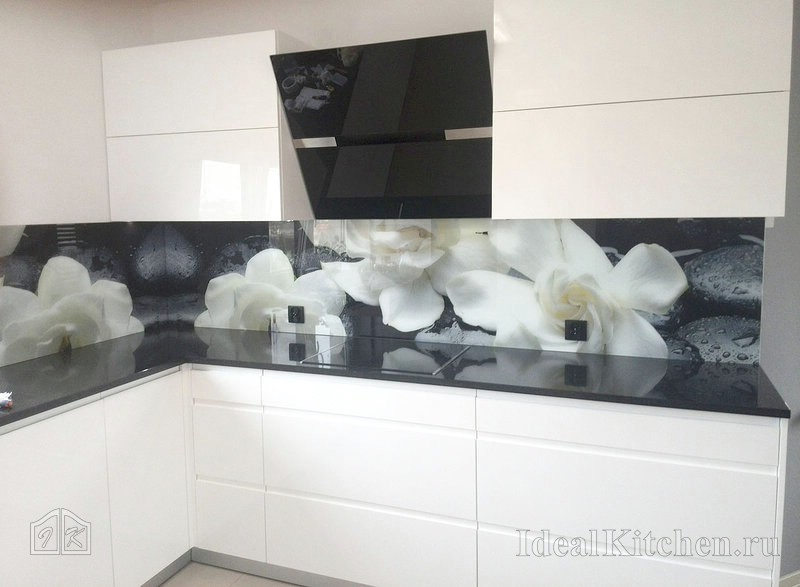
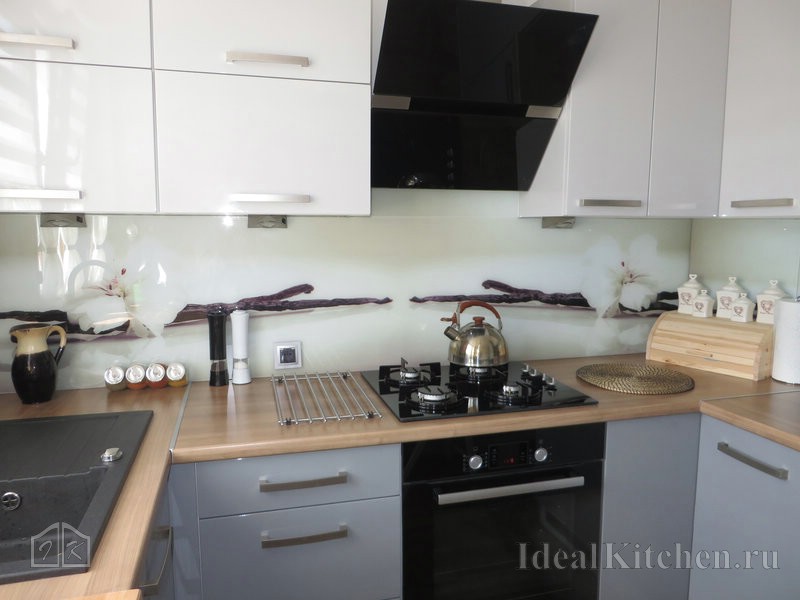
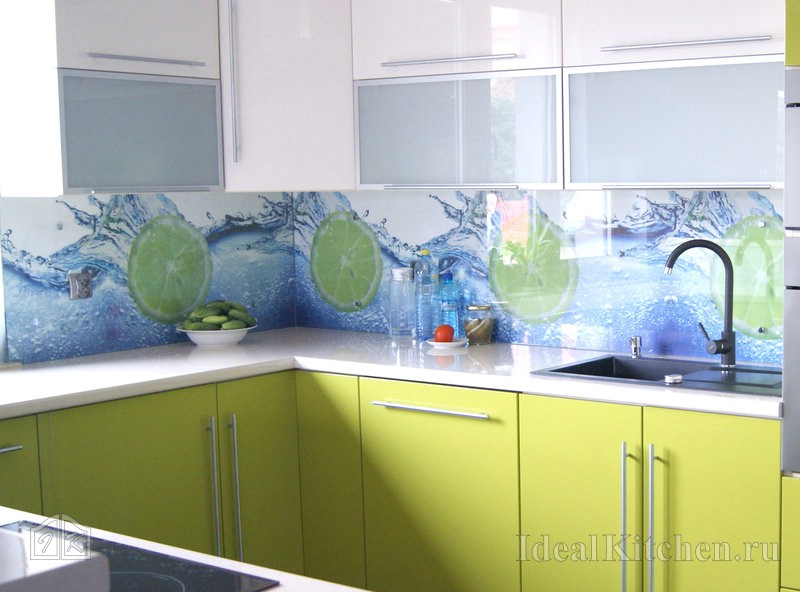
Price. It is difficult to call such a finish budgetary: glass apron for the kitchen is much more expensive than tiles and mosaics, not to mention plastic. In addition to the cost of manufacturing skinali, you will have to pay extra for fitting and trying on a picture (you can choose an image from the catalog), photo tests, installation, cutting holes for sockets and other services that are not obvious to an inexperienced buyer. Most inexpensive option- a transparent colorless panel, the wall behind which can be painted with paint or pasted over with beautiful wallpaper.
Mounting . The main advantage of a glass apron compared to other types of finishes is the speed of installation and the absence of "dirty" work. Mounting process finished panel takes a couple of hours, but requires experience, accuracy and skill. In case of damage, it will not be possible to get rid of the replacement of a small fragment: the coating will have to be changed entirely.
Training . When using special fasteners (and this is the most popular way to install skinali), there is no need to level the wall. Glass lags behind the wall by a few millimeters, so it will hide bumps and old finishing materials, including tiles. To put the panels on the glue, the base must be perfectly clean, dry and even, otherwise they will not stick well.
Durability . Contrary to the fears of many, they were capable of long time decorate your kitchen without losing its attractive appearance. Some companies give a 5 year warranty. Of course, we are talking about high-quality tempered glass kitchen aprons with UV printing with good inks, and not cheap imitations of plexiglass with a pattern on the film.
Moisture resistance. ★ ★ ★ ★ ★
Care . ★ ★ ★ ★
Fingerprints, water and grease marks are more noticeable on glass than on ceramics. But a smooth panel without seams is much easier to clean than walls covered with mosaics or tiles, where you have to clean out numerous seams. It is enough to wipe it regularly with a damp sponge with soapy water and use glass cleaner from time to time.
Made of plastic
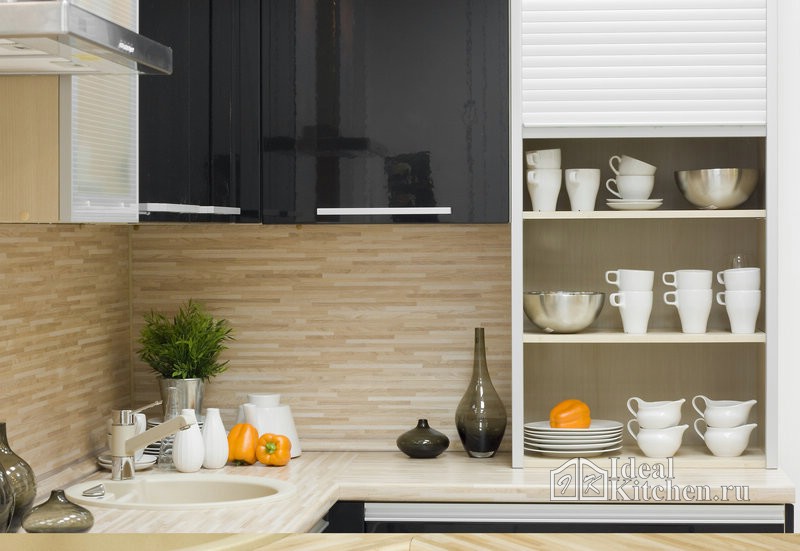
A good choice for economy class kitchens and temporary repairs, especially if you are going to do it yourself. Decent assortment plastic panels can be found in any building hypermarket like Leroy Merlin, OBI, Castorama, etc.
There are two options:
- Furniture panel made of MDF, chipboard and fiberboard, lined decorative plastic HPL - plain or decorated with wood, tile, stone, mosaic. May also be finished with photo printed acrylic.
- PVC wall panels. Flexible screens are attached to the wall with glue and aluminum strips. In terms of practicality and durability, they are inferior to MDF and chipboard: they are thinner, lose color faster, they cannot be installed in kitchens with a gas hob.
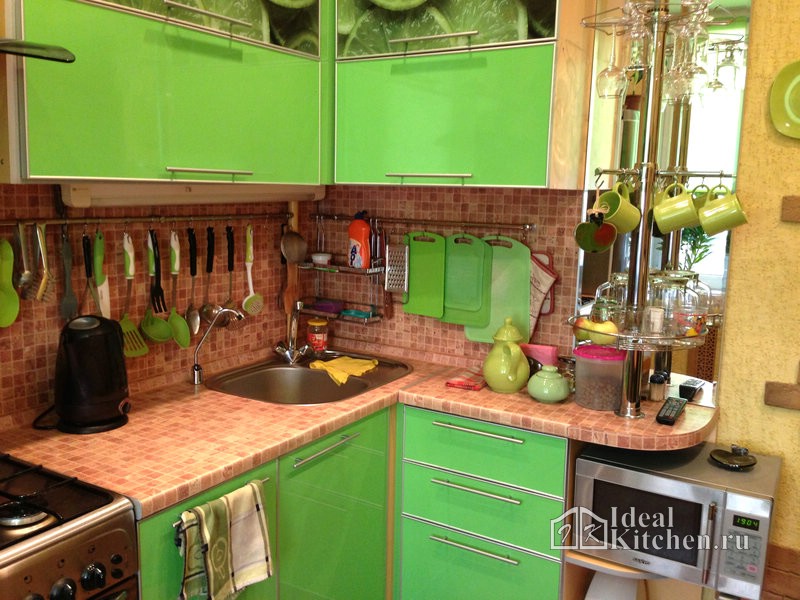
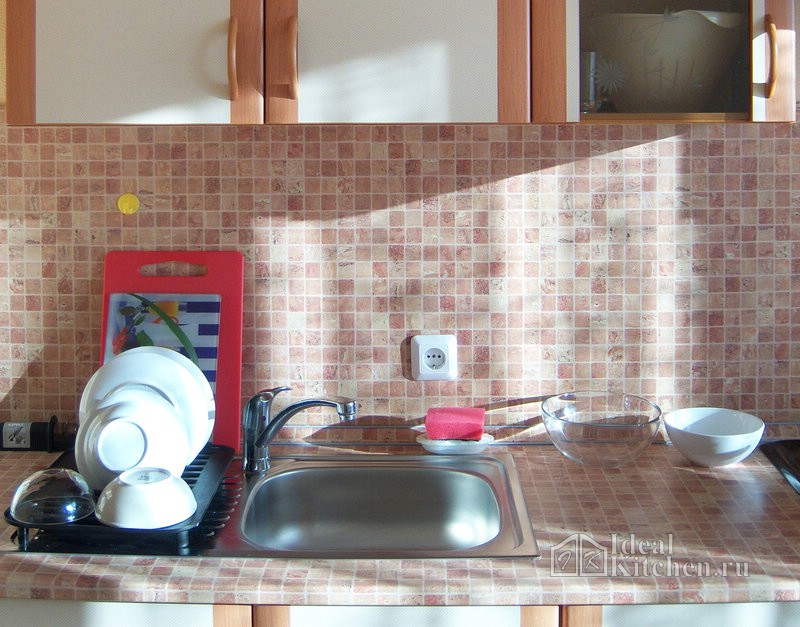
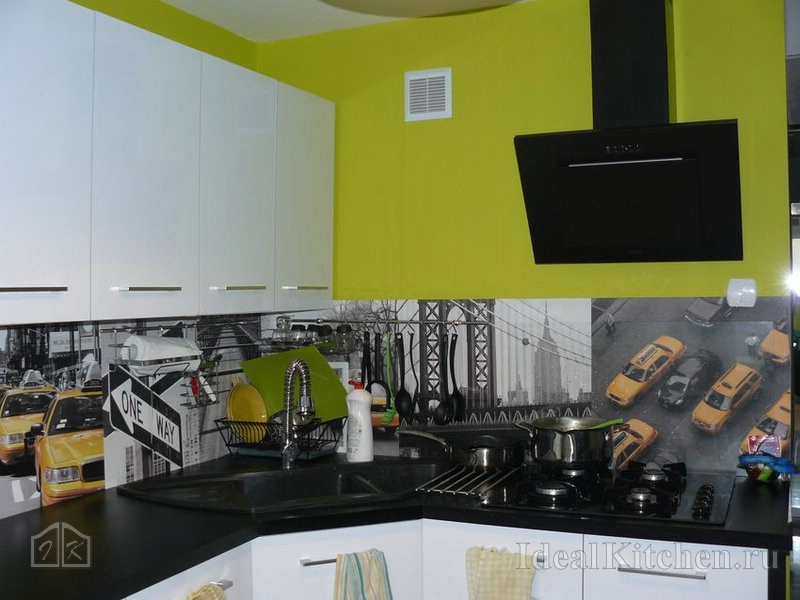
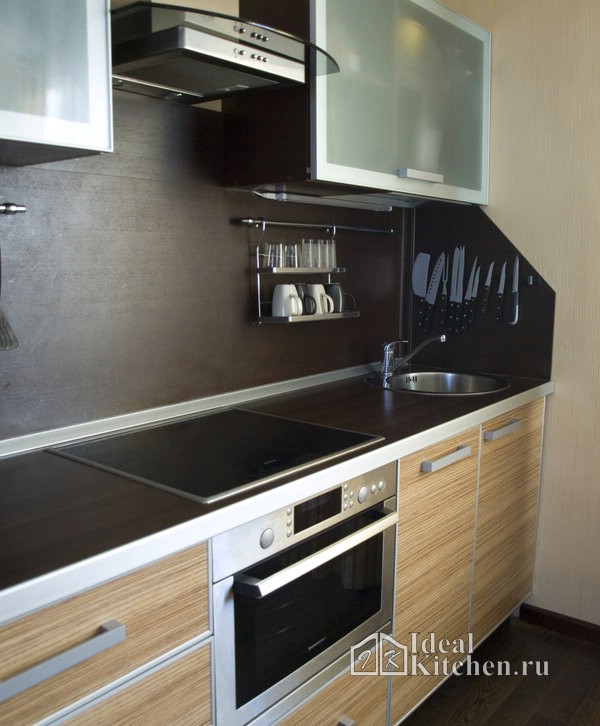
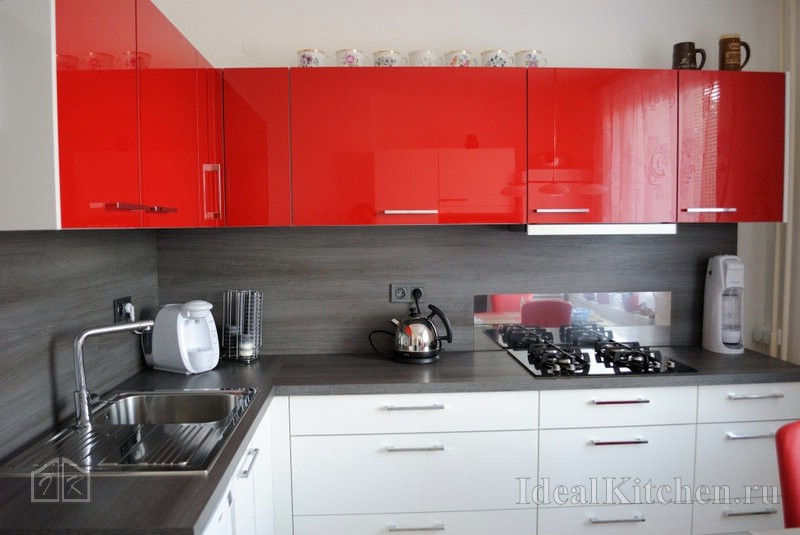
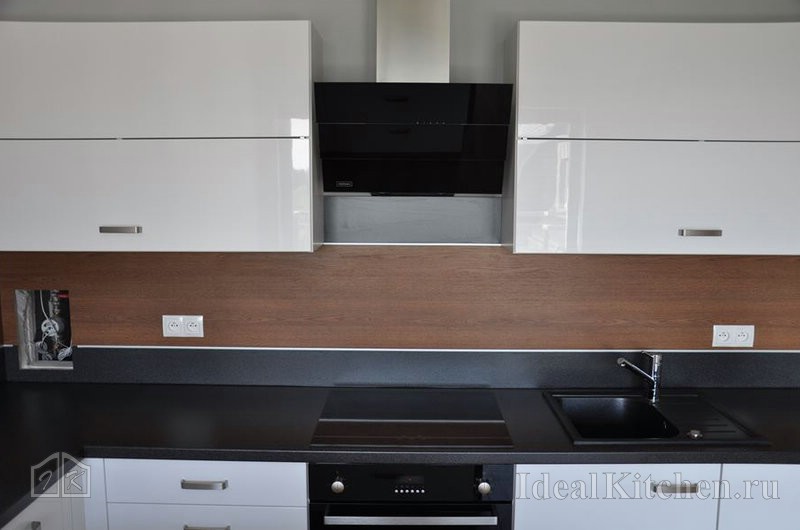
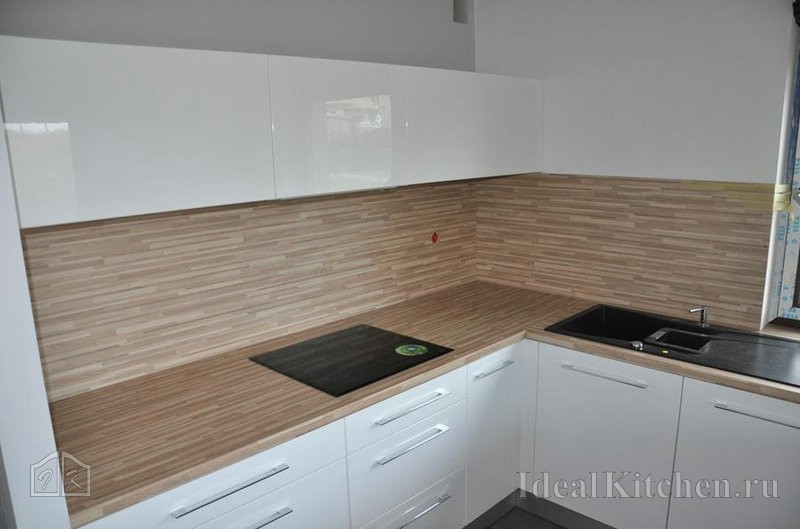
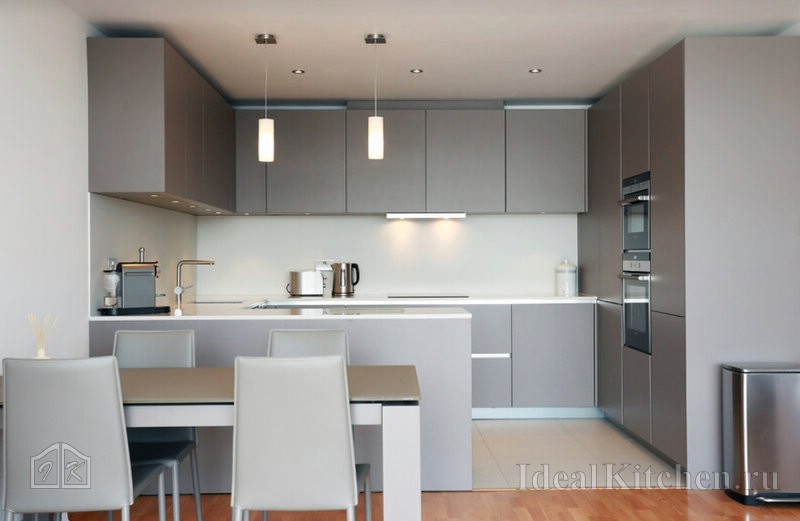
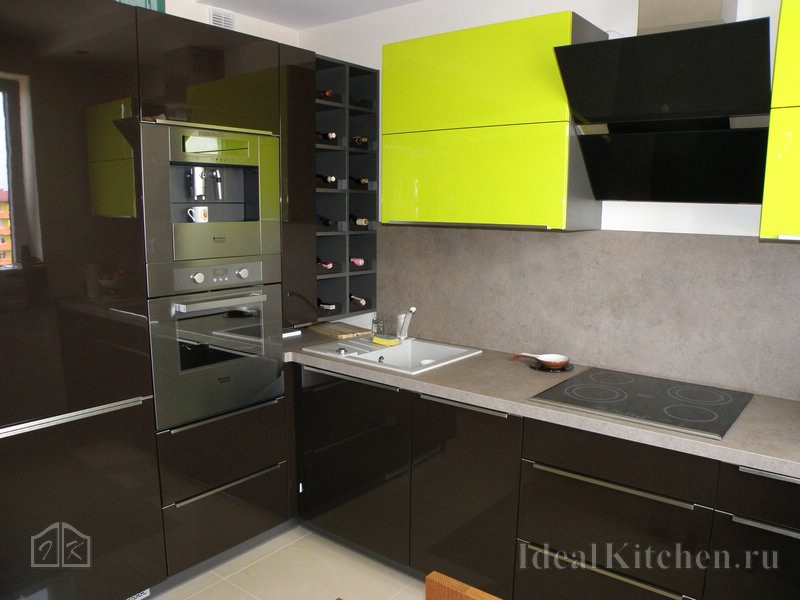
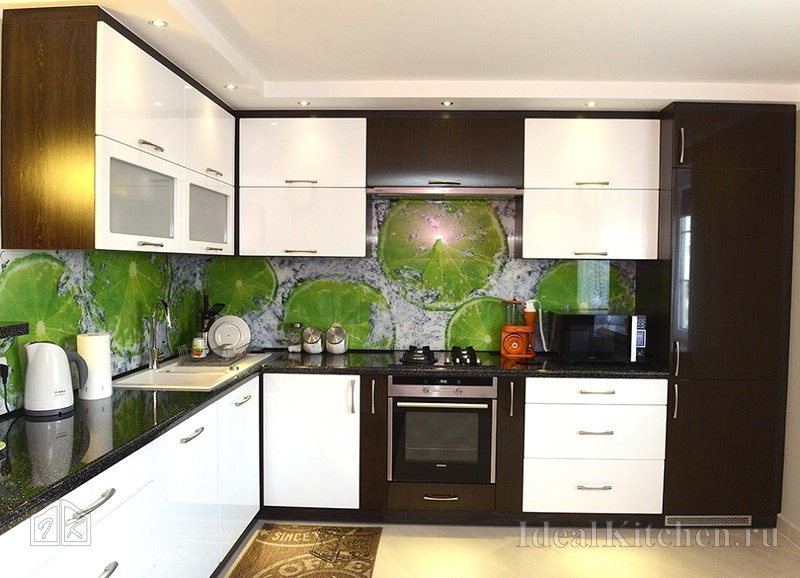

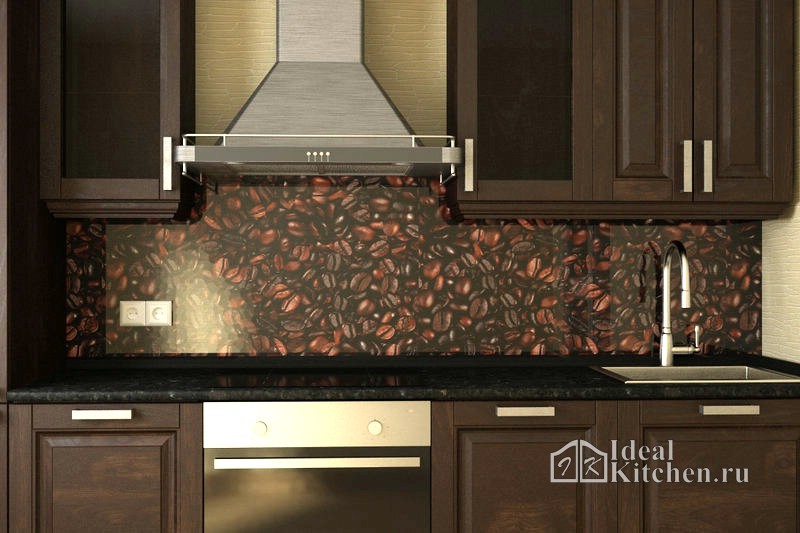
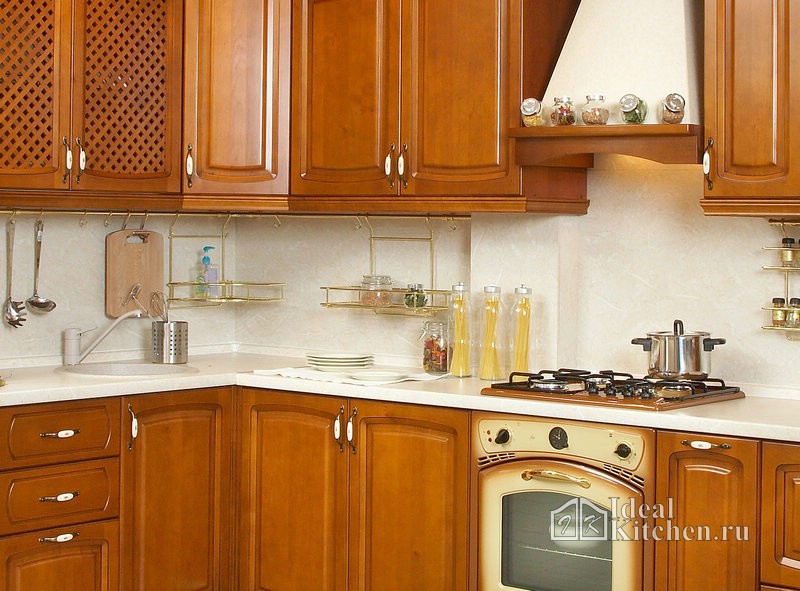
Price. Most a budget option in our selection. A three-meter panel can be purchased for an average of 1.5-3 thousand rubles.
Mounting . An important advantage of a plastic apron is its easy installation, which even a beginner can handle. Unlike tiles and glass, it is easy to make holes for sockets and roof rails in them right during the installation process. When the panels need to be changed, the old ones can be dismantled easily and quickly.
Training . It depends on the type, but most products do not require wall alignment: they are mounted on a wooden crate.
Durability . Of all the materials in our review, plastic kitchen splashbacks have the shortest lifespan. Compared to other options, they will lose their appearance the fastest and are unlikely to last more than 3-5 years. But they are easy and inexpensive to replace.
Moisture resistance. ★ ★ ★
According to this indicator, aprons for the kitchen made of plastic lose to competing materials. But if you take a quality panel ( MDF is better than chipboard) and close the joints with the countertop with a plinth, you should not be afraid of problems.
Care . ★ ★ ★ ★
smooth flat surface Simply wipe with a damp microfiber cloth or soft sponge. Make sure that water does not flood the edges, otherwise the chipboard may deform and swell.
From a mosaic

Mosaic finishes in contrasting colors will make the design of the kitchen bright and dynamic. Mosaic has many types: it can be glass, ceramic, stone, metal... This is a “chameleon” material that looks different depending on the lighting and perfectly assembles the interior together.
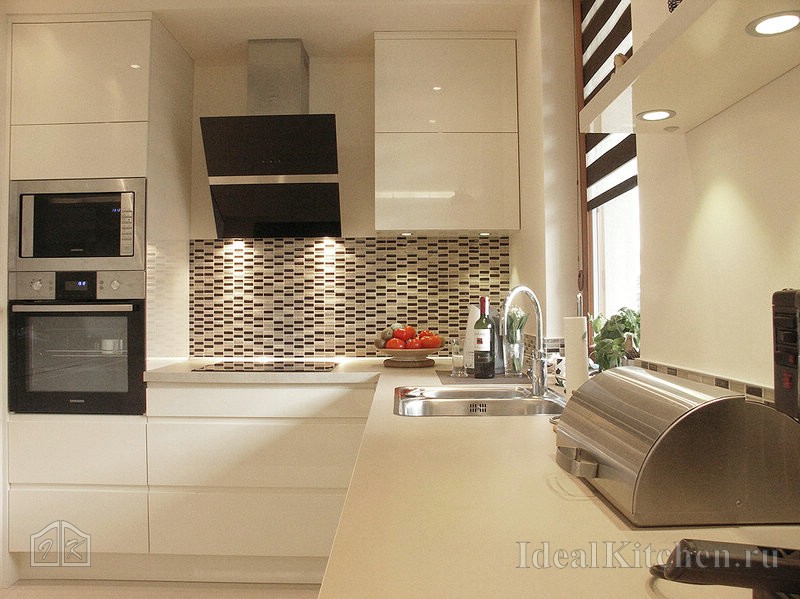
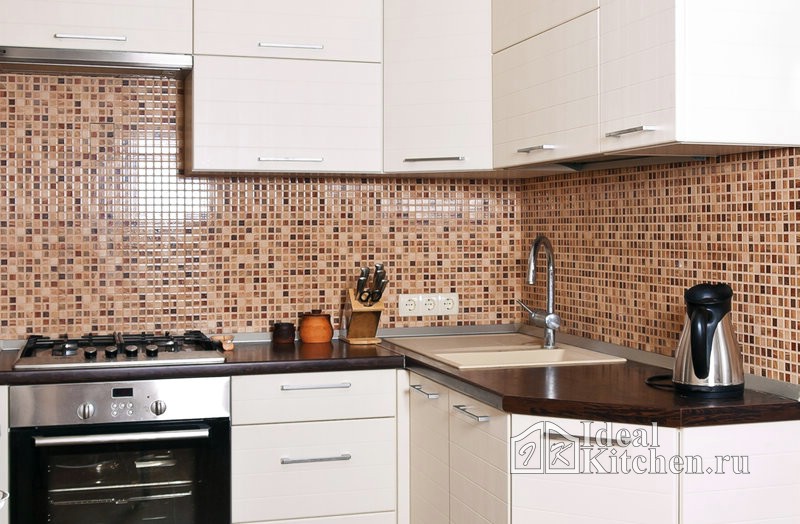
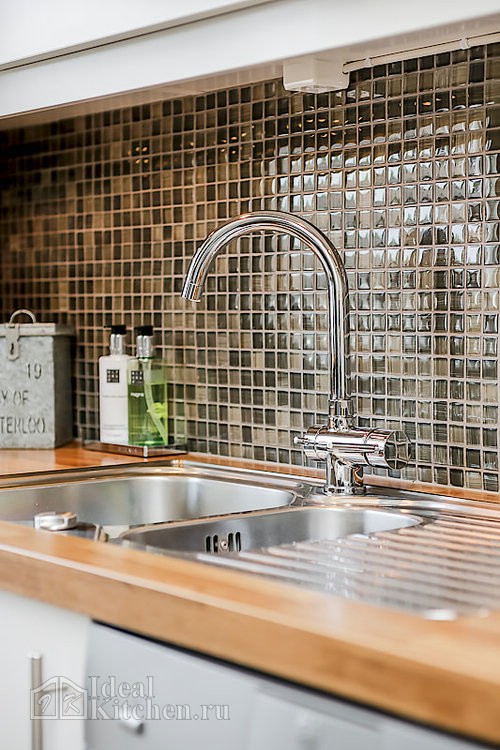
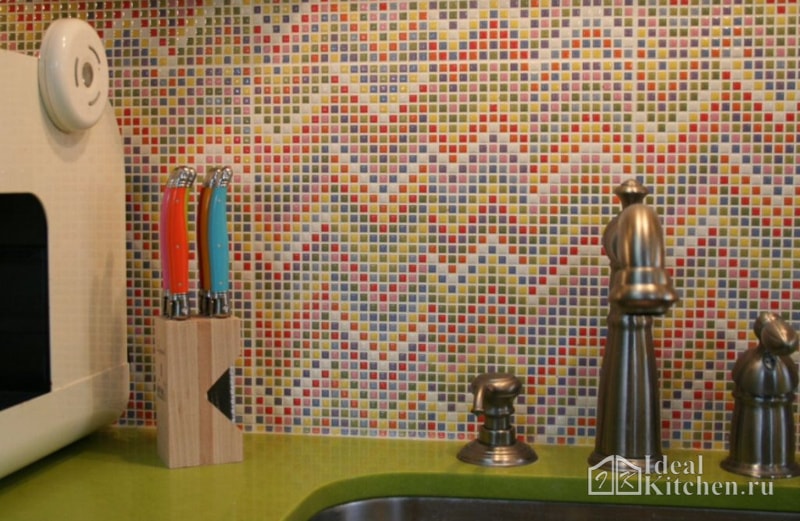
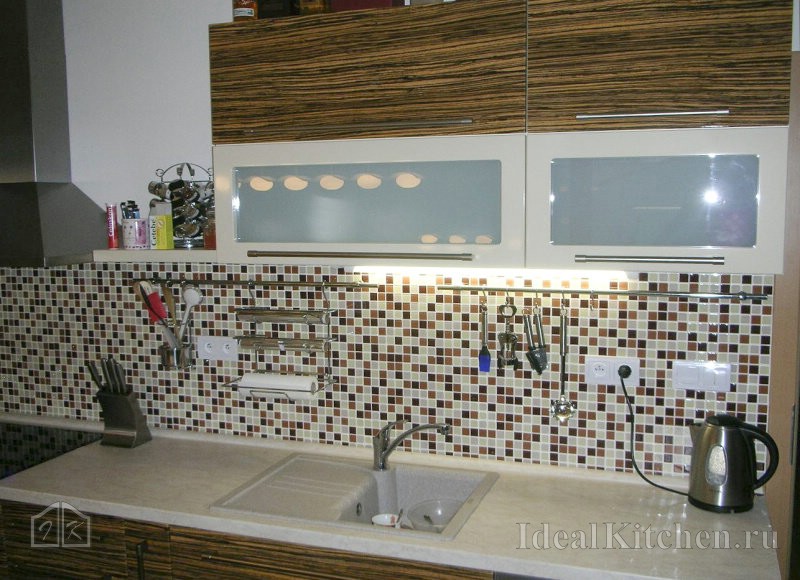
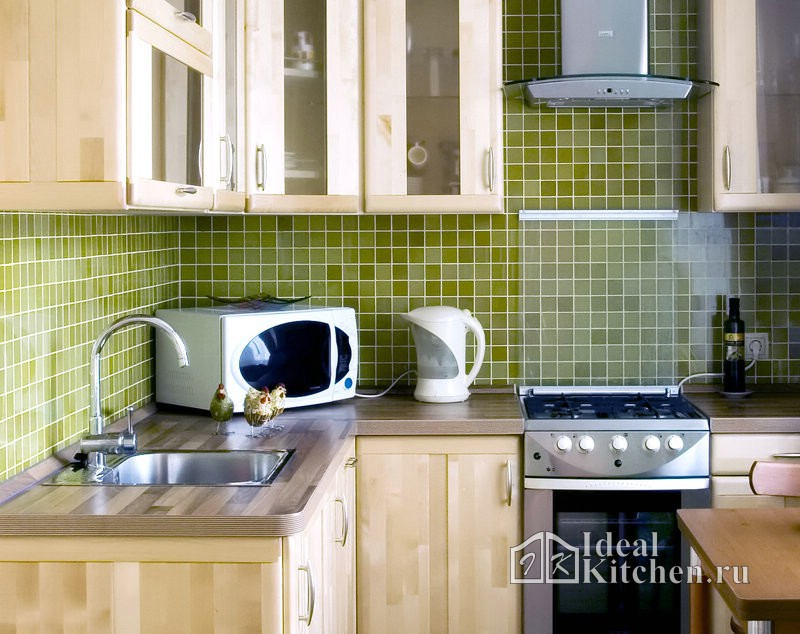
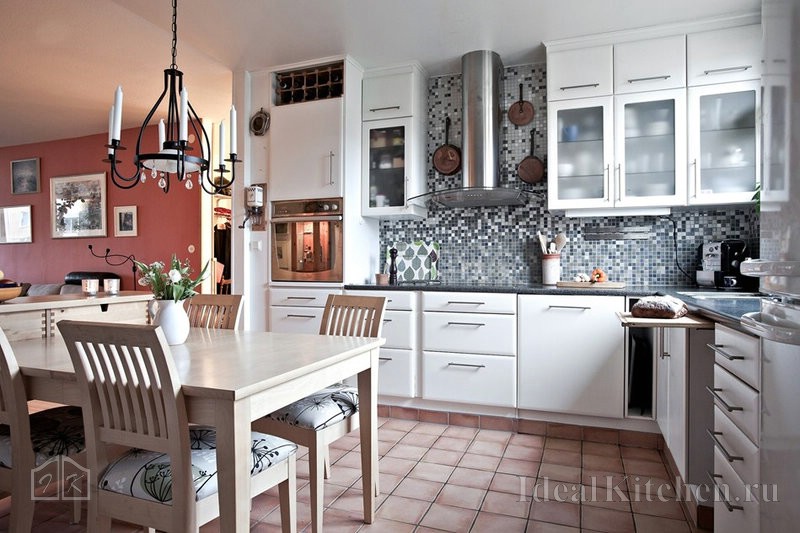
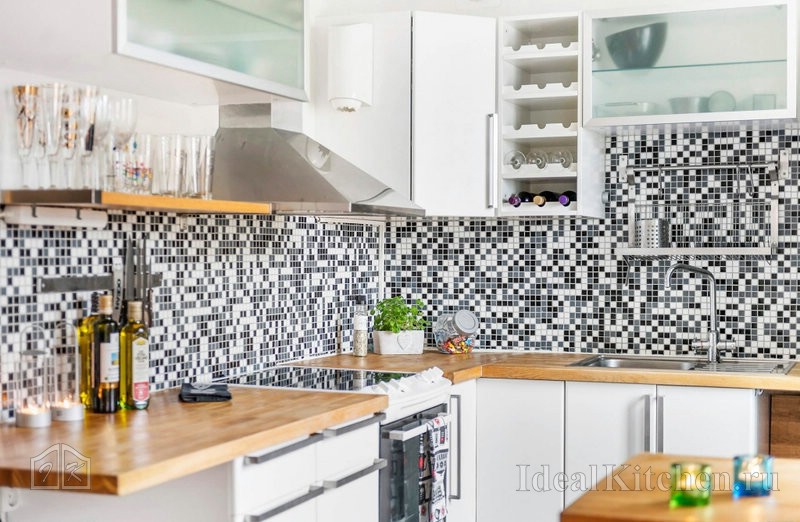
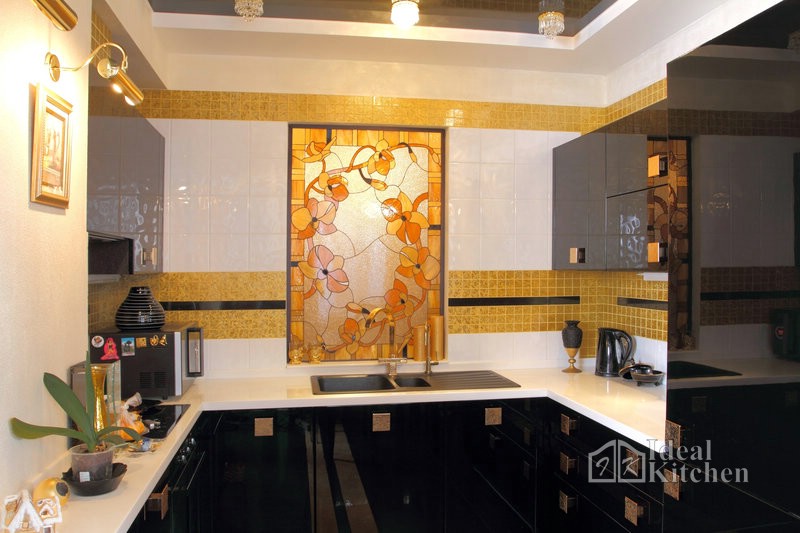
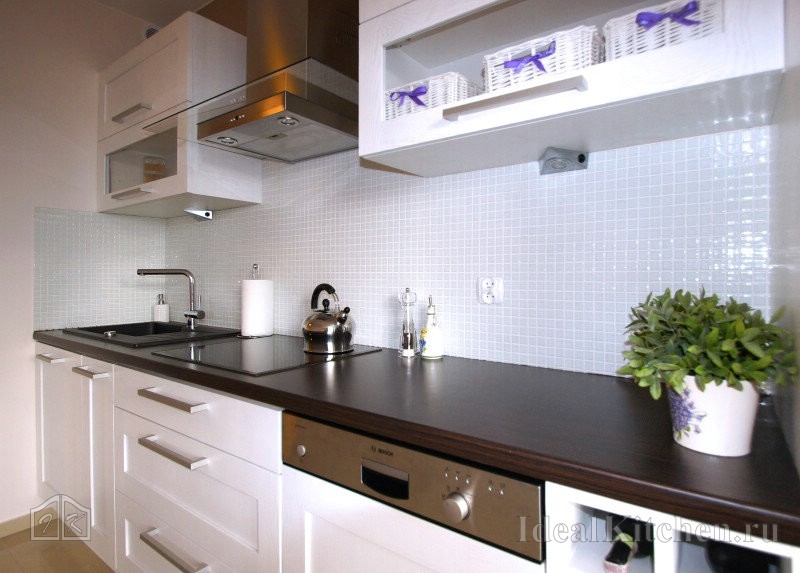
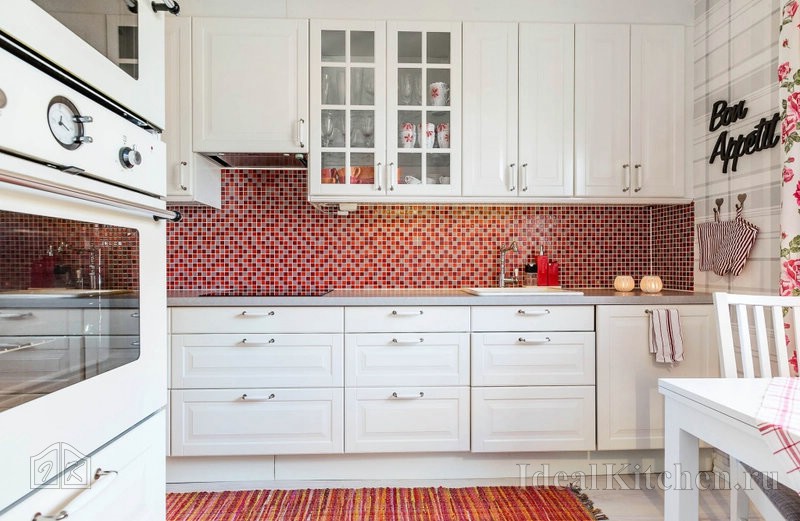

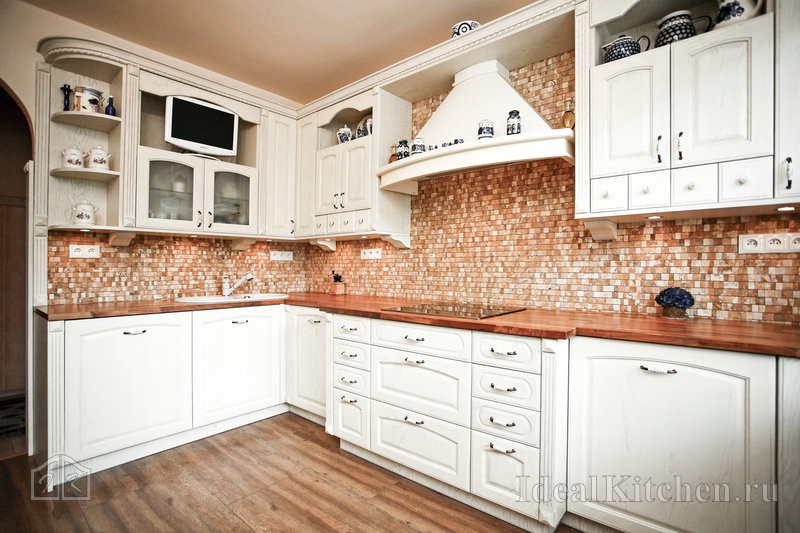

Price. Compared to ceramic tiles and porcelain stoneware, mosaic is a less profitable option. Laying work will also cost more, and necessary materials: you will have to buy special glue and grout. If you want to save money - choose a tile for a mosaic. It is cheaper and greatly simplifies installation.
Mounting . Laying and grouting numerous seams is a laborious process: it requires experience, time and great accuracy.
Training . Although it is possible to mosaic curved surfaces (for example, a radius wall), leveling and carefully preparing the surface is indispensable. Any unevenness in the work area will be conspicuous and spoil the effect of a beautiful finish.
Durability . Will last without a hitch long years. According to European manufacturers, the normal service life quality material- 20-25 years old.
Moisture resistance. ★ ★ ★ ★ ★
Care . ★ ★ ★ ★
Made of acrylic stone
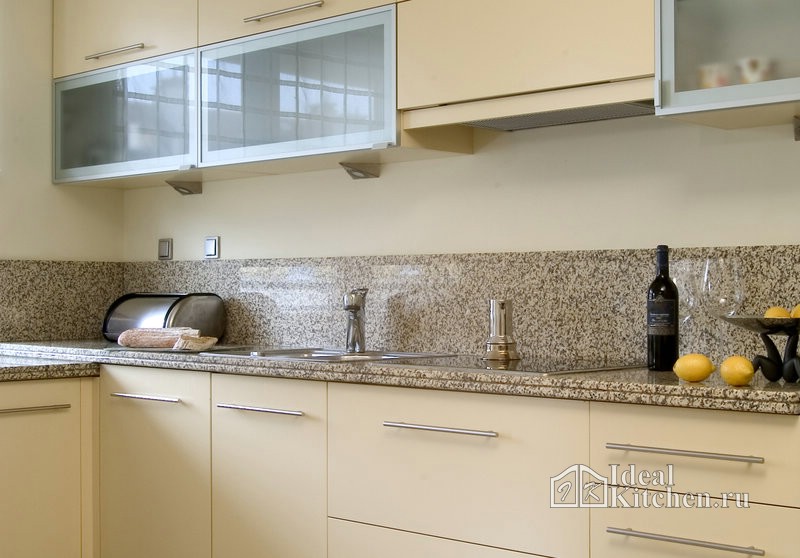
Most often, both an apron and a countertop are made of artificial stone at once.
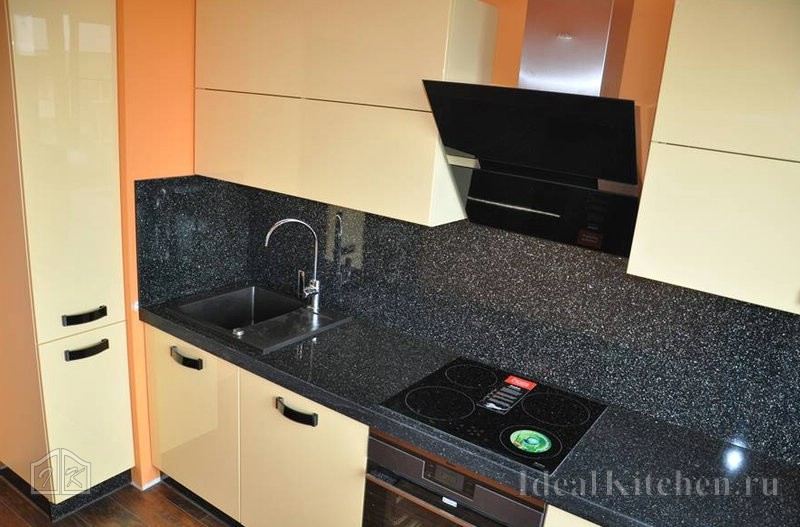

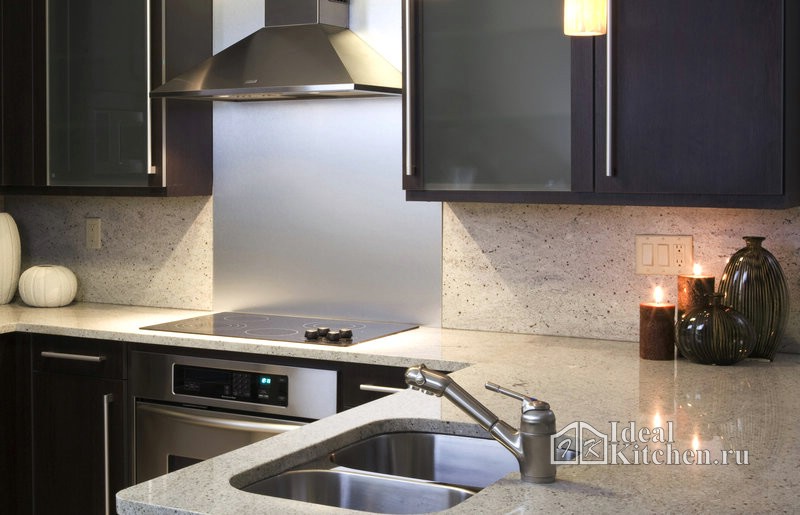
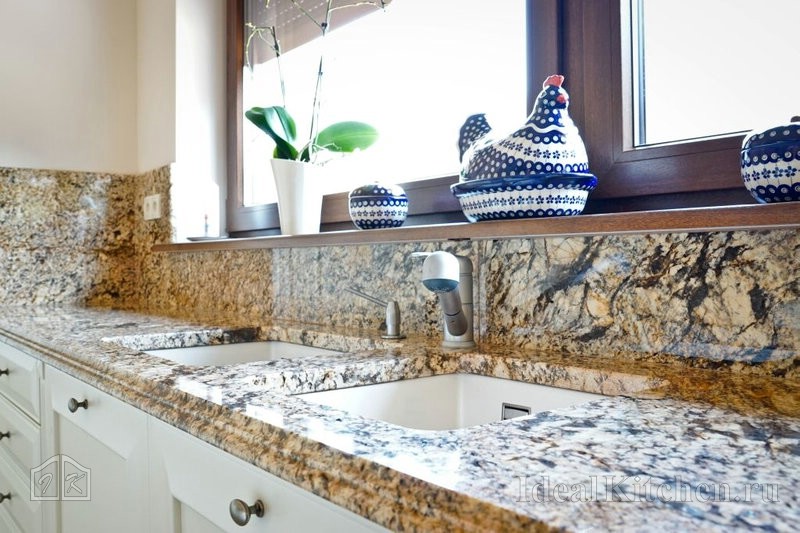
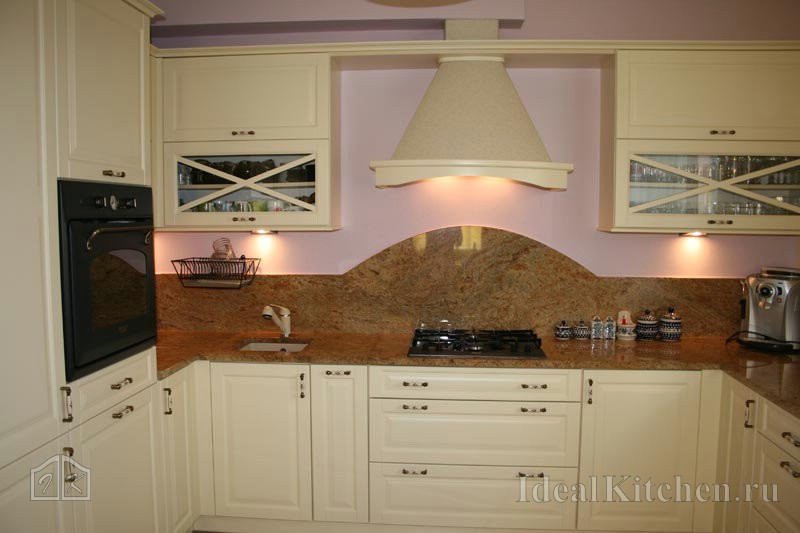
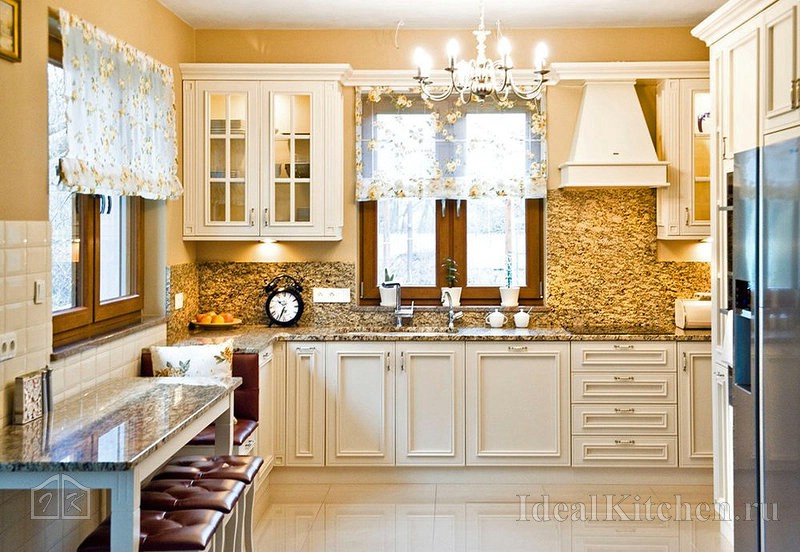
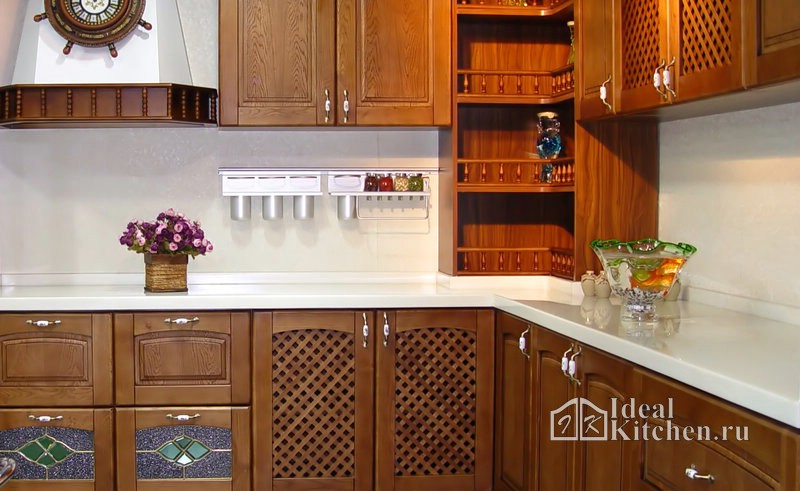
Price. Perhaps the most expensive design option in our selection.
Mounting . Requires work experienced craftsmen, but there will be no dirt during installation.
Training . In order for a thin panel to fit snugly against the wall, it is important to properly prepare the base. First of all, get rid of irregularities so that there are no voids left.
Durability . With careful handling acrylic stone will last you a very long time. If you often touch the surface with pots and kitchen utensils micro-scratches will appear over time. To the credit of the material, it is easy to restore: grind cracks and build up chips. After polishing it will be like new.
Moisture resistance. ★ ★ ★ ★ ★
Care . ★ ★ ★ ★ ★
Due to the absence of micropores on the surface and the absence of seams where dirt usually collects, the wall is easy to keep clean. Simply wash the panel with clean/soapy water. Even stubborn dirt can be easily removed without special tools.
You can learn more about this finishing material.
Photos of aprons from unusual materials
If you want a “not like everyone else” finish, take a look at the ideas below. The wall above the countertop can be painted with moisture-resistant paint, wallpapered, finished with laminate, mirror tiles, sheet of stainless steel, decorative plaster, brick, stone. Not all solutions are practical in the kitchen: sometimes you need additional protection as clear glass or acrylic varnish.
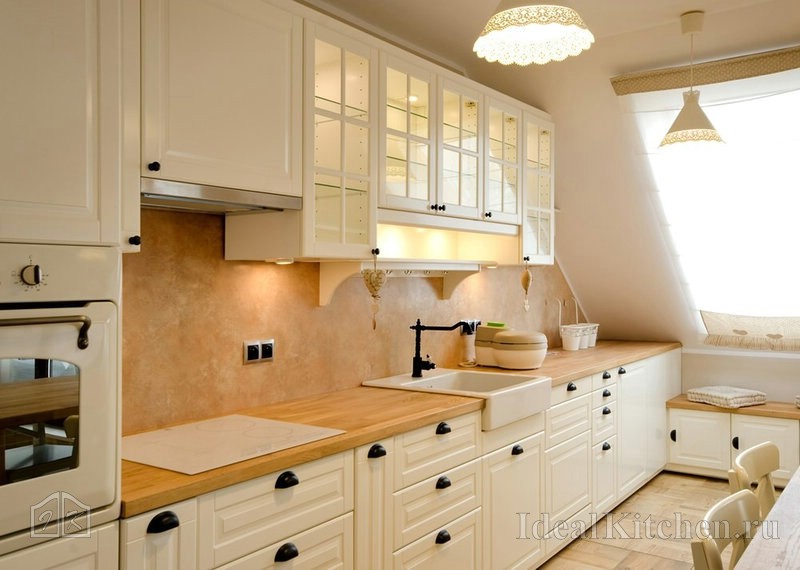

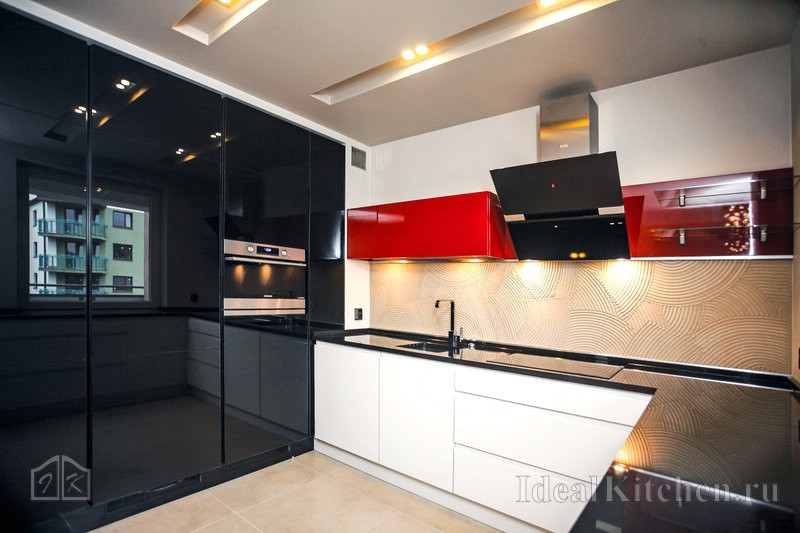

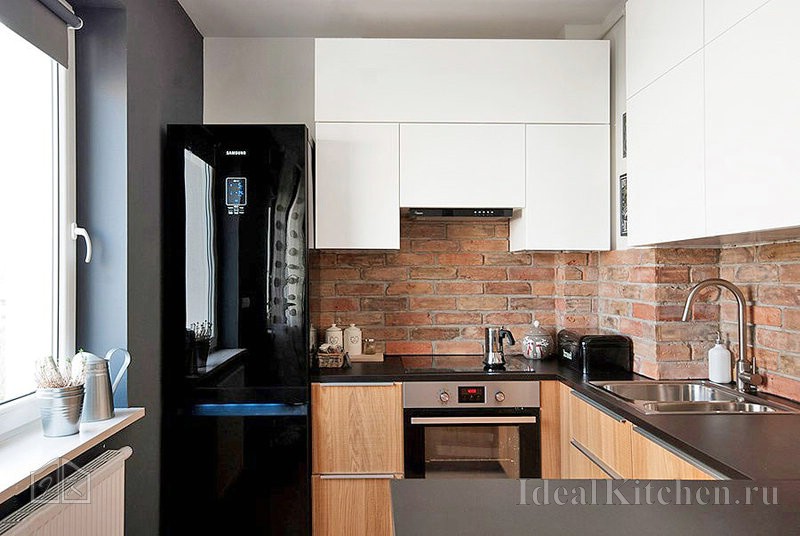

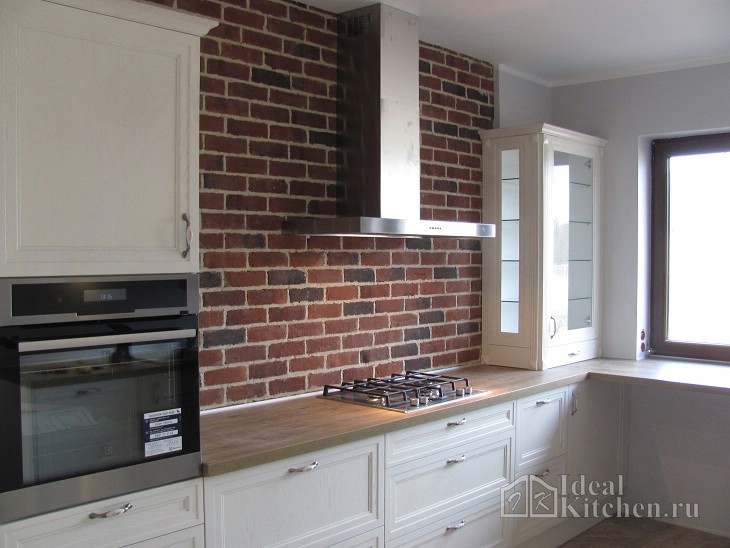
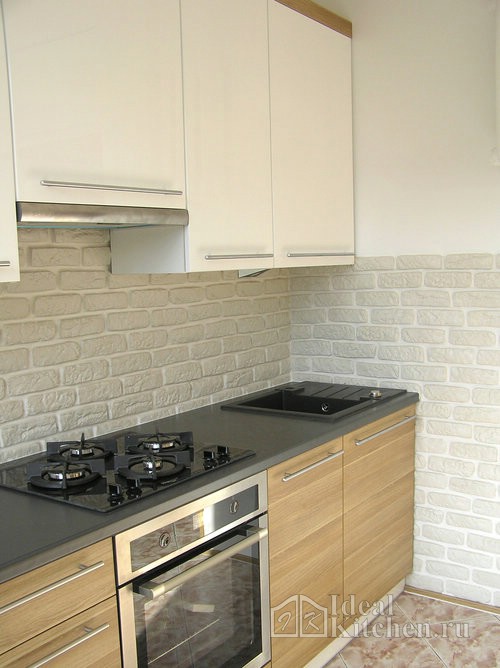
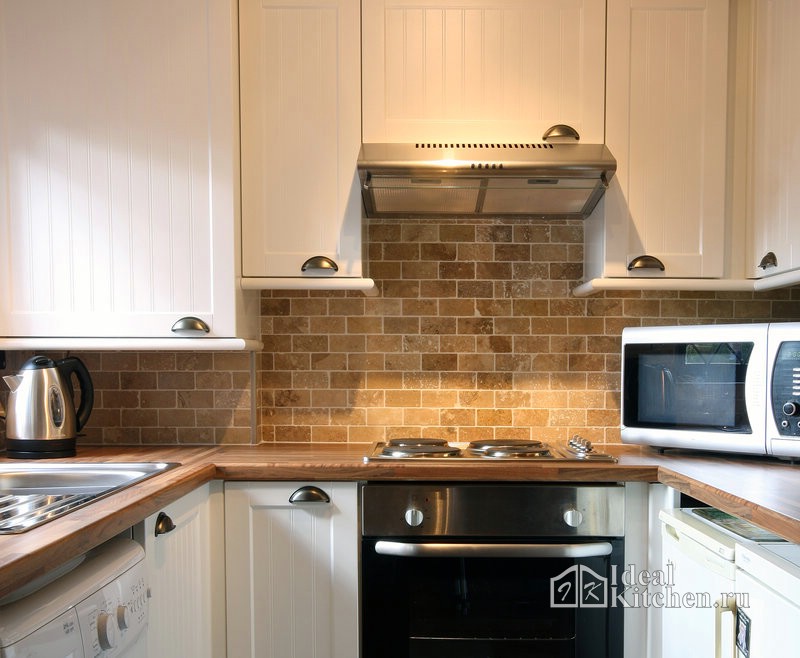
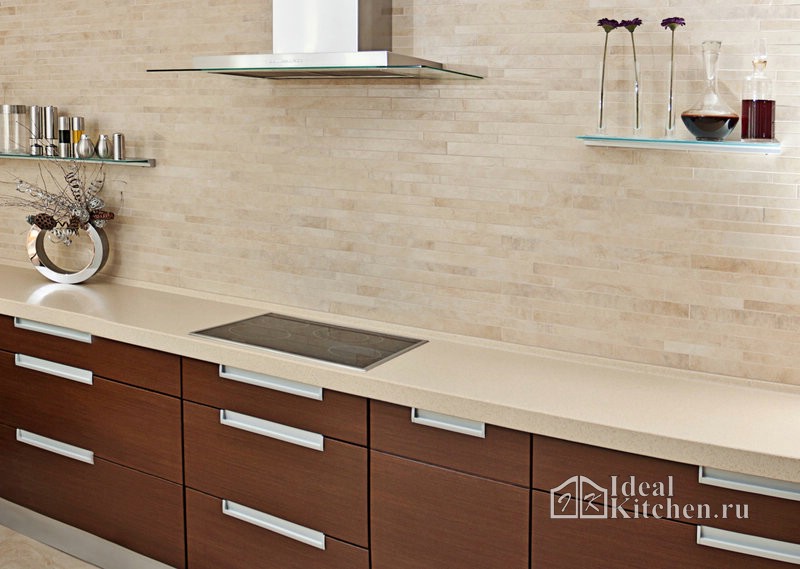
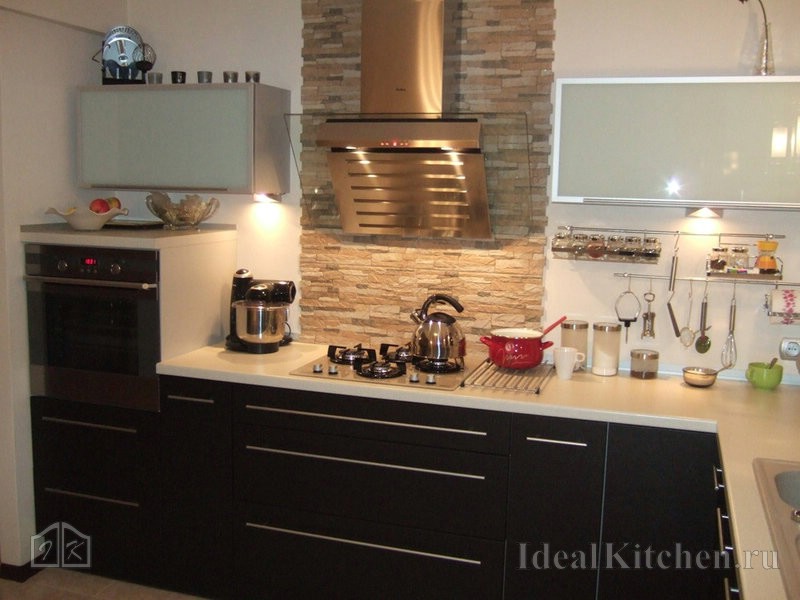
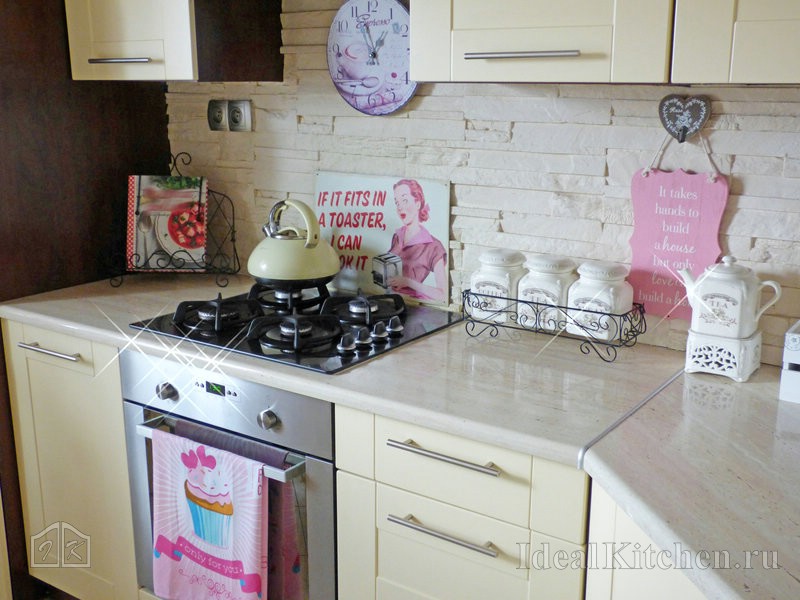
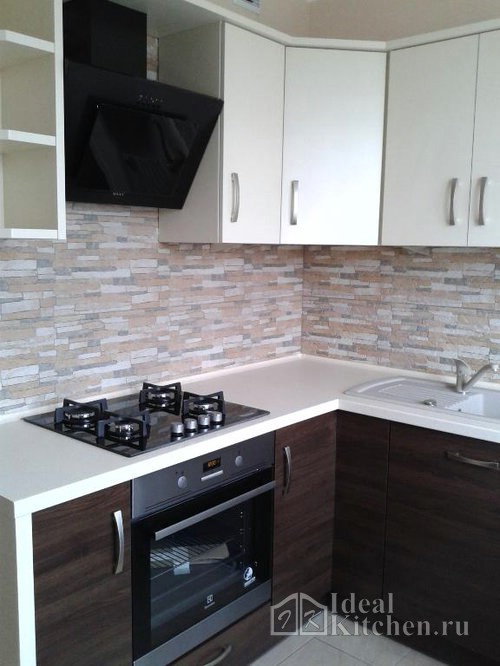
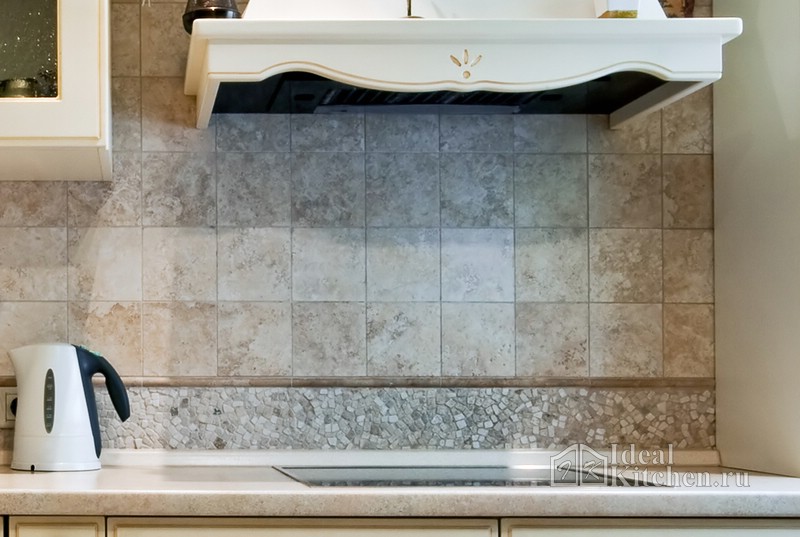

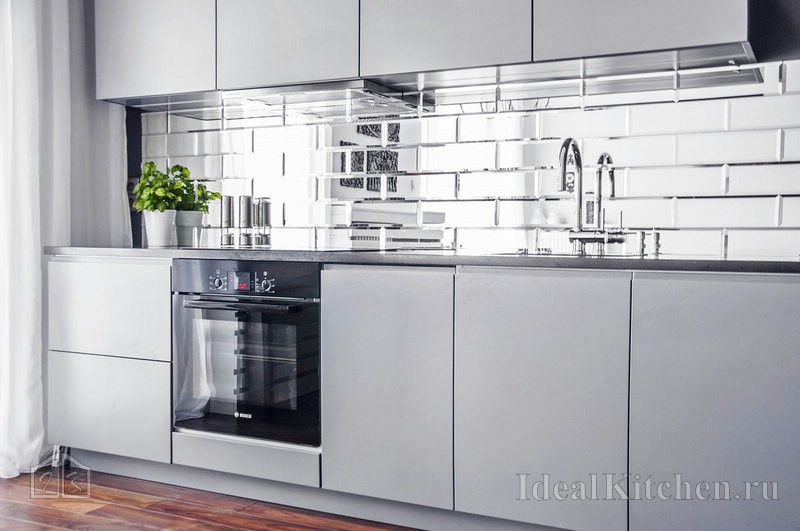
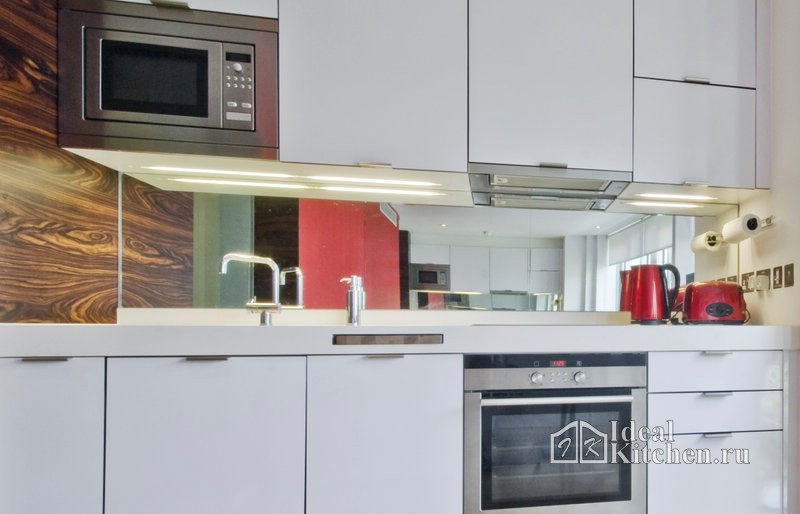
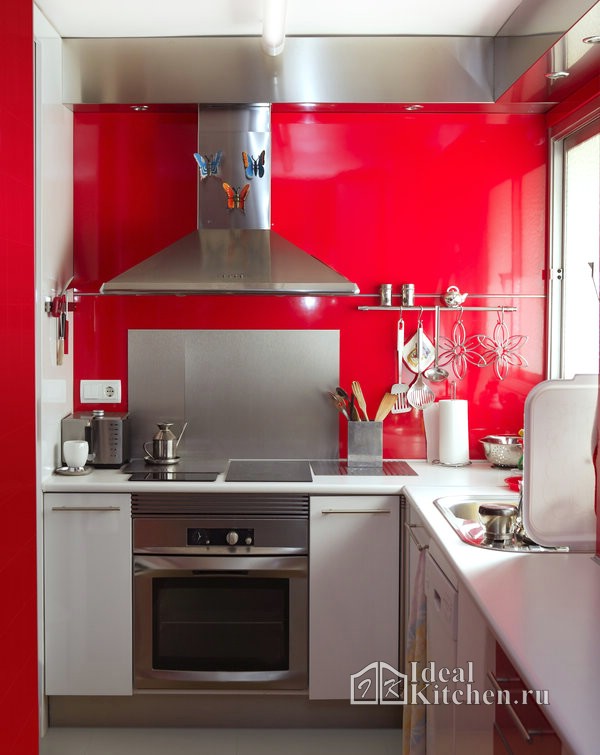

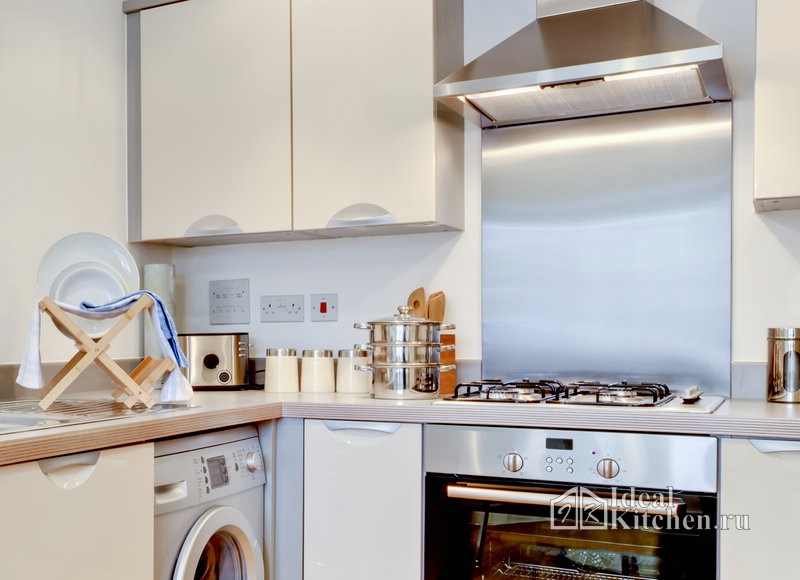
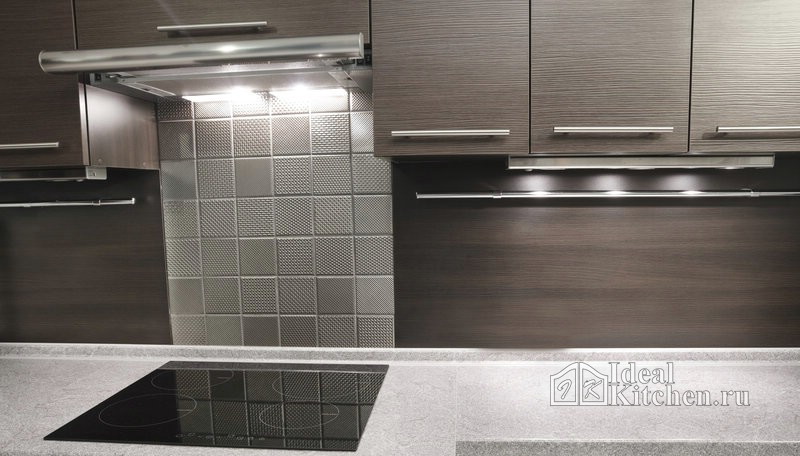
No one will argue with the statement that the kitchen is one of the most frequently visited and loved places in a house or apartment. The owners of spacious premises install sofas or large round tables to pass the evening at friendly gatherings or with family, they acquire expensive furniture. Owners of small ones also try to equip their tiny kitchenettes as comfortably as possible. The blessing is on the market today great amount accessories for this room and furniture sets. For any, as they say, taste and wallet. Nevertheless, in every kitchen, regardless of how and with what it is furnished, there is an area that is equipped in accordance with generally accepted rules. This is the space between the bottom and upper cabinets headsets. And they call it simply - an apron. And it must meet certain requirements and be made of special materials. We will talk about what types of aprons are and what they are made of in our review.
General requirements
All the types of aprons available today are so diverse that it is sometimes difficult to make a choice. However, in any case, it is worth remembering that the material from which you will make the lining must meet quite specific, and very stringent requirements. After all, an apron is an area located above the desktop and stove, so it is exposed to steam and all kinds of pollution more than all other places in the kitchen. Therefore, considering all available types of aprons, choose a material that can be easily and quickly cleaned. And even better, so that the dirt on it was not particularly visible. Well, this issue is solved more due to the pattern and colors.
Considering all the types of aprons for the kitchen offered by manufacturers, give preference to those products that are likely to be resistant to moisture and temperature changes, which means that they will serve for a long time and faithfully, without losing their visual appeal. 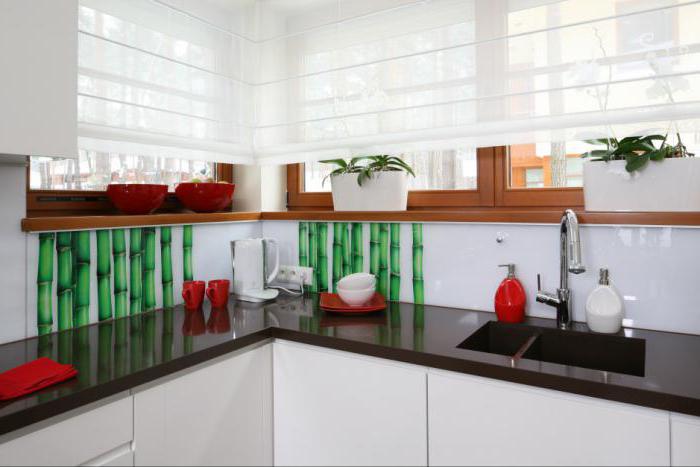
As far as design is concerned, here general requirements not today. An apron for the kitchen can be selected taking into account the color of the facades of the headset, countertops, wallpaper on the wall, or even choose an option that will look like a bright spot against the general background. As already mentioned, the types of aprons are very diverse, so there will be no problems at all in terms of design. We, in turn, will try to help with advice. And let's talk about what is most often lined with this area. That is, in other words, what types of aprons are most popular.
Tile
No matter how numerous the types of aprons offered by manufacturers, ceramic tiles - a long-liver among all finishing materials for the kitchen - have always been and probably will remain in the first place. This facing material Lots of pros and almost no cons. It is durable, not afraid of temperature changes, easy to clean, in addition, it is fireproof, which is the first thing that owners should pay attention to. cookers. Dirt on the tiles is also less visible, as well as smudges of grease, especially if the colors are appropriate. Ceramic apron will have an original attractive appearance for a long time.
What are there for an apron in the kitchen? Yes, very different! You can simply purchase a tile that is most suitable in color and pattern for the existing interior, thereby creating individual design, or you can buy ready-made panels. Or even order a photo print. 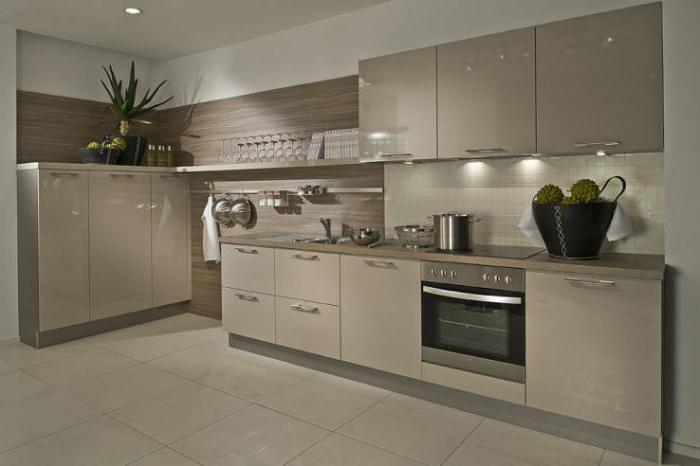
As for the shortcomings, there are perhaps only two of them. The first is that laying ceramic tiles with your own hands is sometimes quite problematic. Especially if the base coat is not particularly pleased with the quality. The second is that it is quite difficult to remove it from the walls if necessary. However, the issue is resolved. Carefully choose the material both in appearance and quality, and you will not have to face its shortcomings. But the price will certainly please.
mosaic apron
By and large, this is a type of tile. True, today mosaics are made not only from ceramics, but also from metal and glass. Very modern version surface decoration above the desktop. It is especially suitable for cladding rounded surfaces. The disadvantages are similar to those of ceramic tiles, plus the cost of such a finish is much higher. 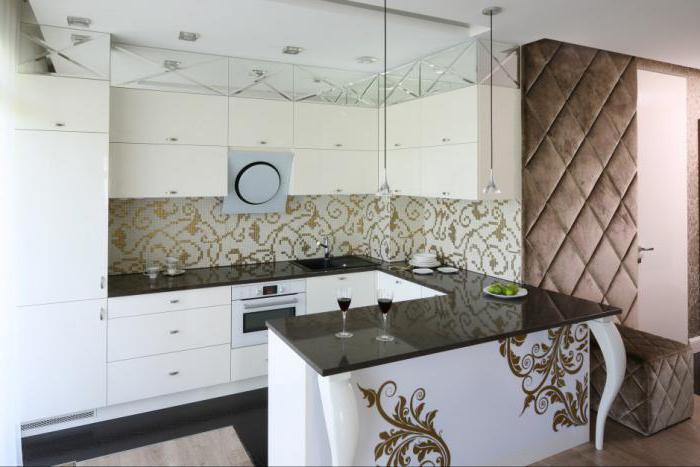
MDF
A budget option, such an apron is most often purchased along with when it is made to order. As for color solutions, here the choice is huge, but most often it is made the same as the countertop, which allows you to create harmonious design. Incidentally, this is the most budget solution. If someone wants the apron to be different, then you can order photo printing, that is, put it on MDF surface any picture you like.
As for the advantages, this is, first of all, the low cost of the material, and secondly, the ease of installation. Attach it to the wall using a frame or even, if the surface allows, using liquid nails. Removing such a panel from the wall is as easy as fixing it. 
Among the shortcomings, it should be noted that such aprons are short-lived. Especially if you remove dirt from them using aggressive chemicals. In addition, it cannot be called a plus that these panels are combustible materials.
Glass
Considering the types of apron finishes and not lacking money, you can opt for glass version. Such panels appeared on the market relatively recently and they are quite expensive, but they have such an attractive appearance that few people regret the amounts spent. Unless only when faced with the shortcomings of such an apron. In second place among which (after cost) is the need for almost daily care. After all, even the slightest pollution is visible on the glass, what can we say about one that is located next to the surface on which borscht gurgles, diligently spraying greasy drops in all directions. So, if you have a glass apron in the kitchen, be prepared for the fact that with a rag and a cleaner you will have to stand near it every day. 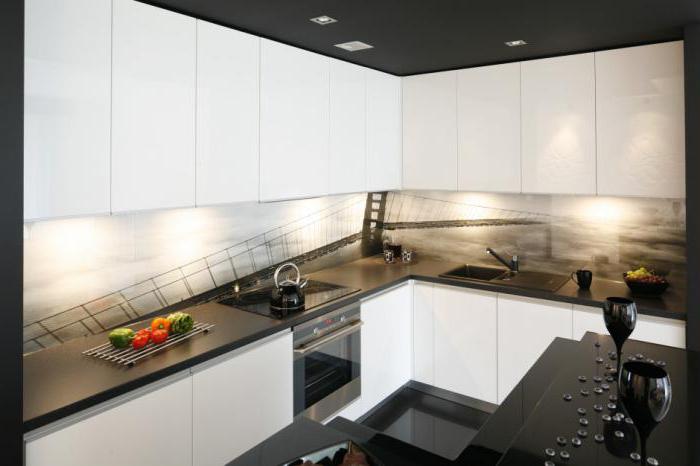
As for the pluses, this is primarily the appearance. The glass panel can be just plain, and with a pattern printed on it. And in the latter case, manufacturers offer almost artistic masterpieces that are ready to decorate the wall not only in the kitchen, but also in the museum. Such an apron is made of solid dense, so that there are no seams on it, in which grease or dirt will accumulate. Well, to mount it yourself, of course, is also undesirable.
Plastic
This is a simple and, perhaps, the most short-lived version of a kitchen apron. It is inexpensive, but also does not last long. Since it scratches during cleaning, absorbs odors, and can be deformed by temperature changes, which, as you know, is not so rare in the kitchen. combustible But as mounted, and removed very quickly. 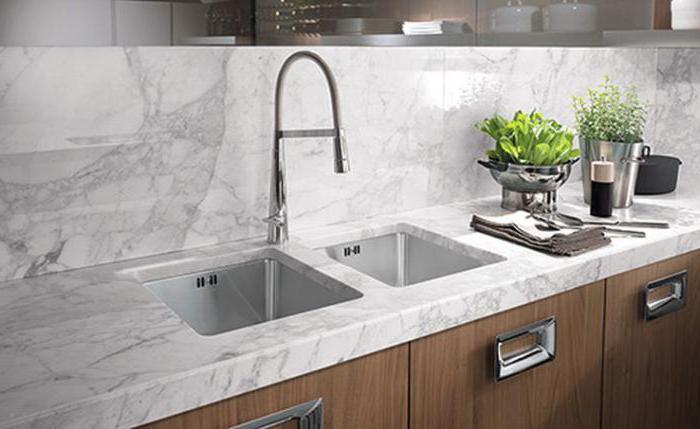
Mirror panels
An extreme option, but having the right to exist. First, it's unusual. Secondly, it's beautiful. Thirdly, you can visually expand the space of the kitchen. True, the last plus is rather doubtful. Due to the fact that the kitchen will visually become larger, you cannot put an extra refrigerator here, but all the shortcomings in the event that there has not been cleaning for a long time will also be visible on the other side of the desktop. In addition, such an apron, however, like ordinary mirror need to be washed very often.
Metal apron
A novelty on the market, which appealed to fans of hi-tech, minimalism and loft. It is made, as a rule, from stainless steel, and therefore it has an appropriate appearance. True, on sale you can also find corrugated options with a pattern embossed on them. Durable enough, not afraid of fire, steam, temperature changes, but also requires daily care. 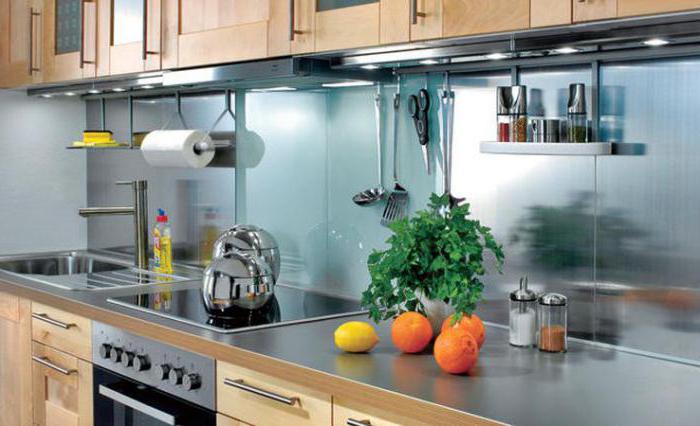
Incidentally, this one and mirror version it is unlikely that it will be possible to install it yourself, since installation requires caution, skill and the presence of special fasteners and tools.
Stone kitchen apron
Made from both natural and artificial materials. The first ones are very expensive, and therefore they are not particularly popular. But the second ones are cheaper, they have far from the worst characteristics, in addition, they can imitate almost any surface. Such aprons are attractive in appearance, durable, easy to care for. Quite often, not only an apron is made of stone, but also a countertop, thereby creating an exquisite harmonious interior. 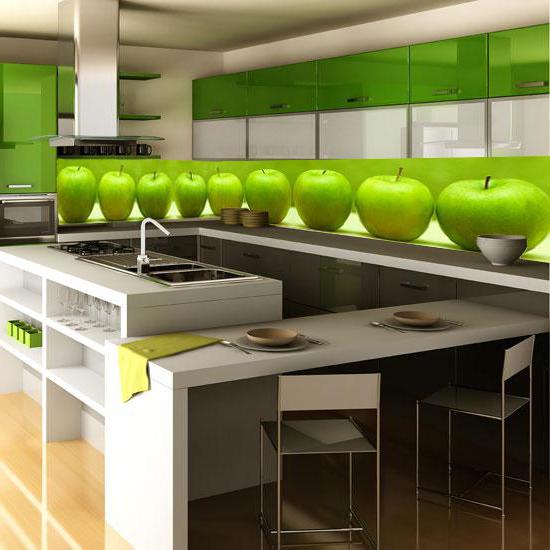
Conclusion
We tried to talk about what types of kitchen aprons are most popular today. As you can see, there is a choice. You can buy expensive finishes, or you can find a more budget option. In any case, you can be sure that there is a suitable material for almost any interior.
Part of the wall between the surfaces of the headset (plates, tables, cabinets, sinks) and hinged shelves and cabinets are called an apron for the kitchen.
But what to choose: a ceramic apron for the kitchen, glass, stone, MDF or laminate? This question worries many, we will analyze in detail the pros and cons of each material.
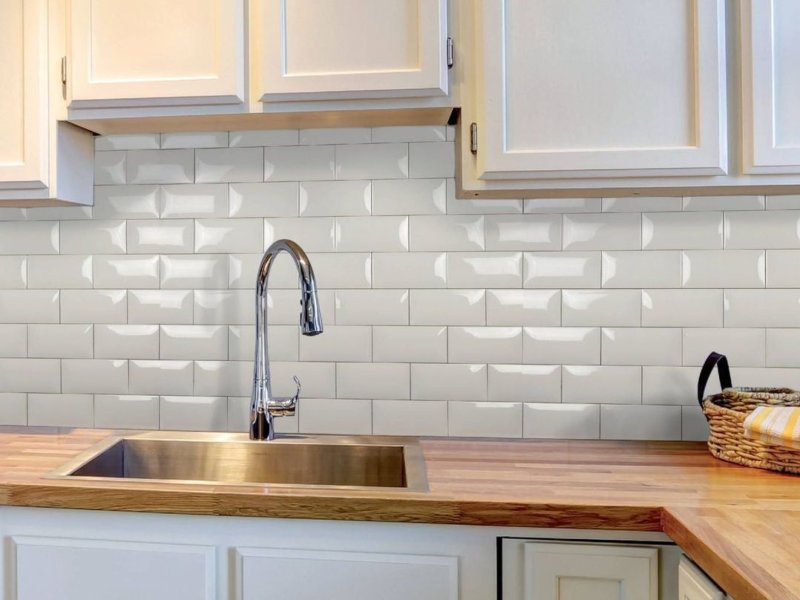
Apron tiles
Popular traditional ceramic tiles. It is durable, hygienic, low-porous.
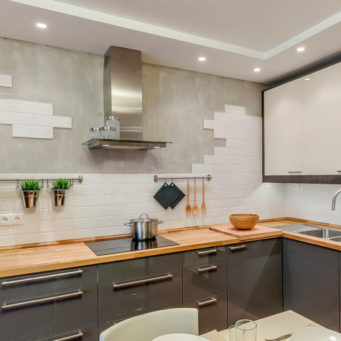
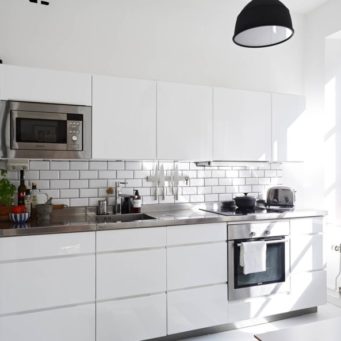
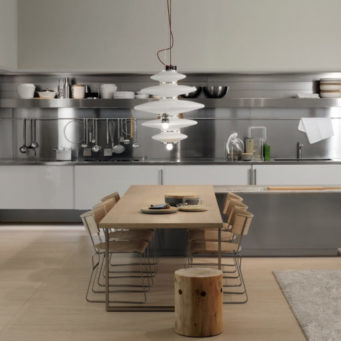
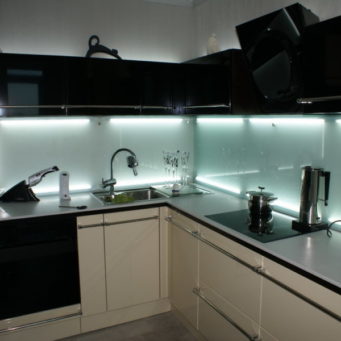

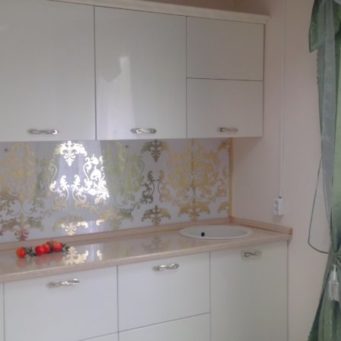
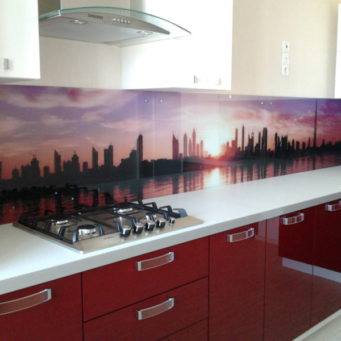
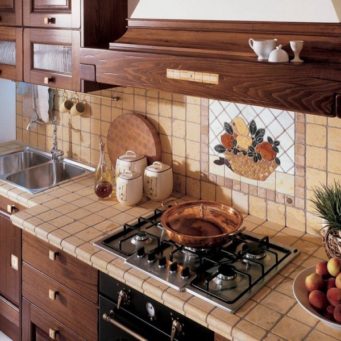
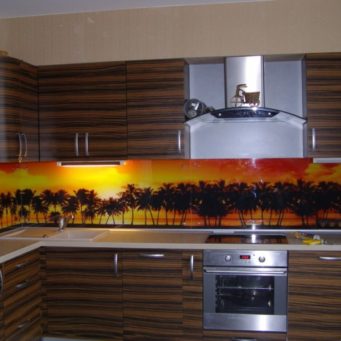
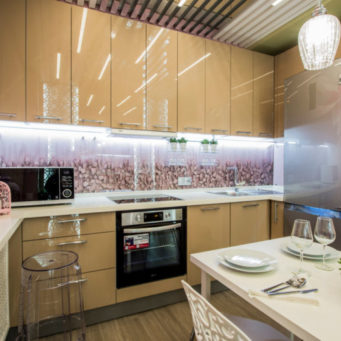

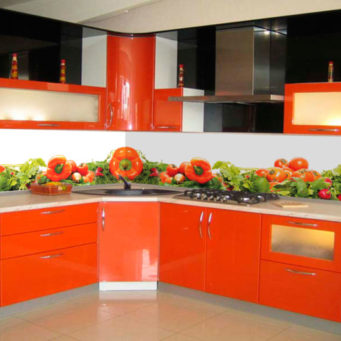
But a huge choice makes it possible to create interesting designs from other materials.
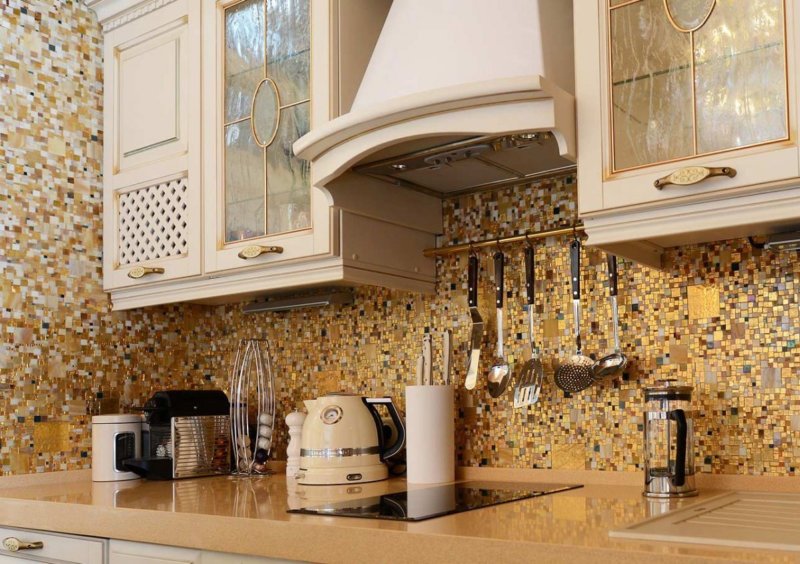
Not suitable for an apron: plaster, photo wallpaper or whitewash, and plywood and chipboard are afraid of water, swell and deform.
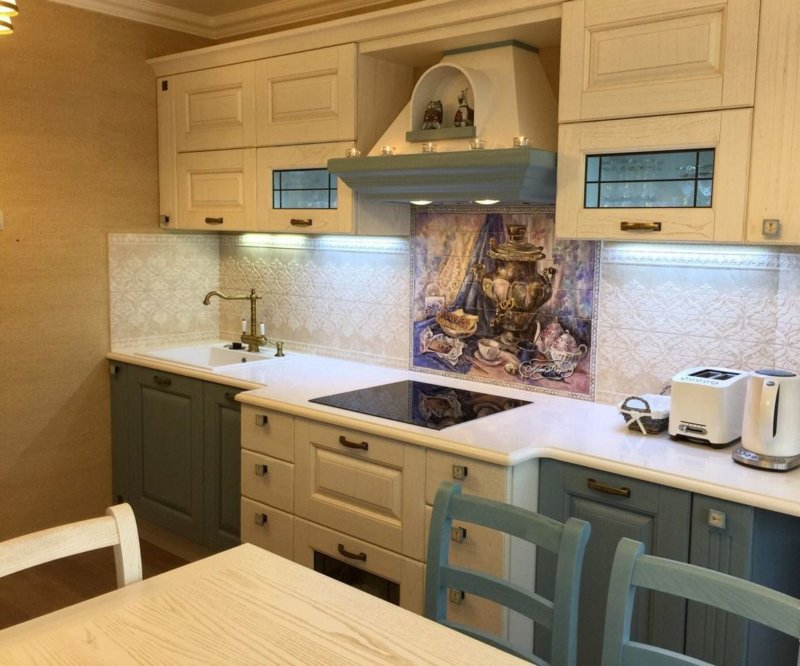
Moisture resistance, strength and fire resistance of the material are the main requirements for a kitchen apron. Favorite material, proven over the years - tiles for the kitchen on the apron. Consider what materials are used.
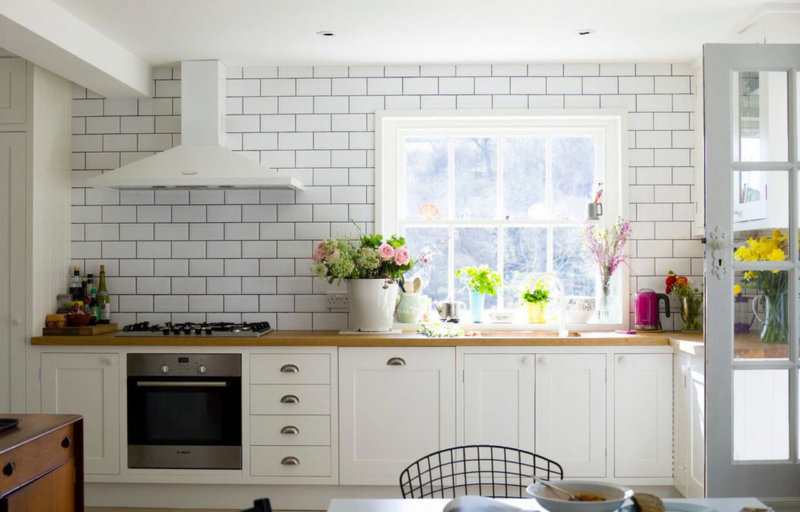
Stone
Natural (artificial) stone for a kitchen apron - perfect option. This brickwork, which is coated with water-repellent varnish, suitable for country or loft.
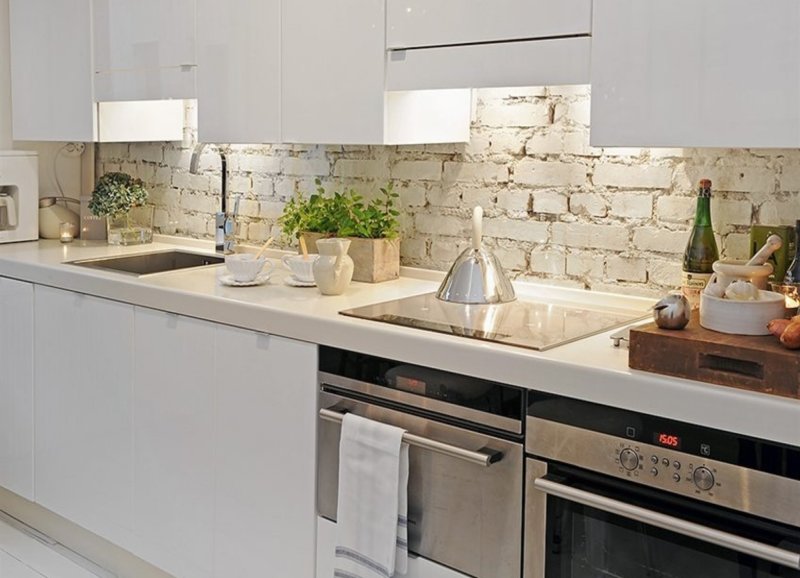
It is better to use marble, granite or basalt - they are polished. Natural stones look luxurious, are not afraid of fire and overheating, are stronger than ceramics. Marble absorbs different dyes, requires careful maintenance.
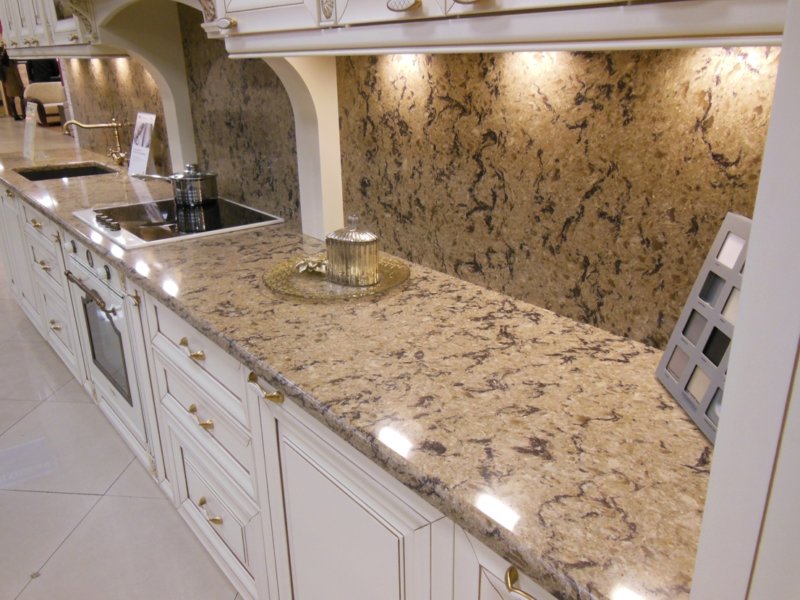
Artificial stone has many colors and types of finishes. Lighter and much cheaper than natural, durable, low-porous, does not absorb dyes, durable.
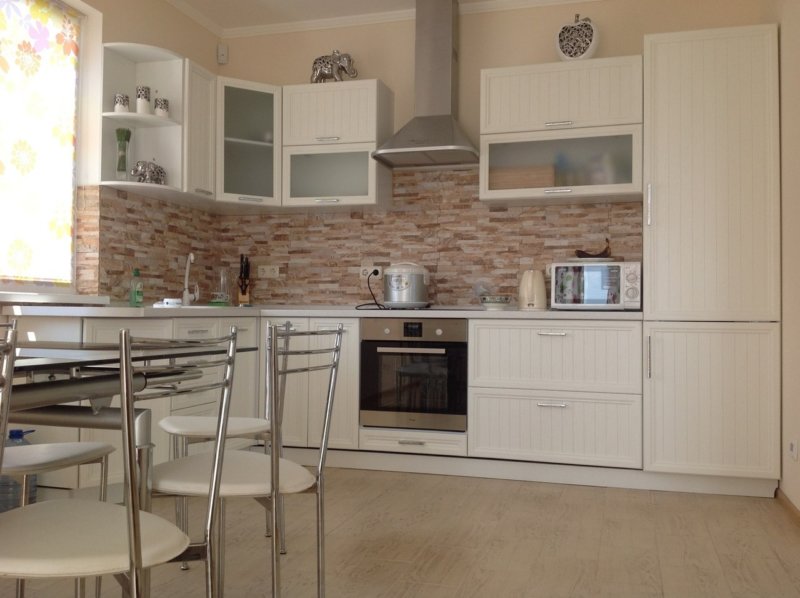
MDF for apron
Next to the chipboard, the MDF kitchen apron is practical, more resistant to moisture and fire, and durable.
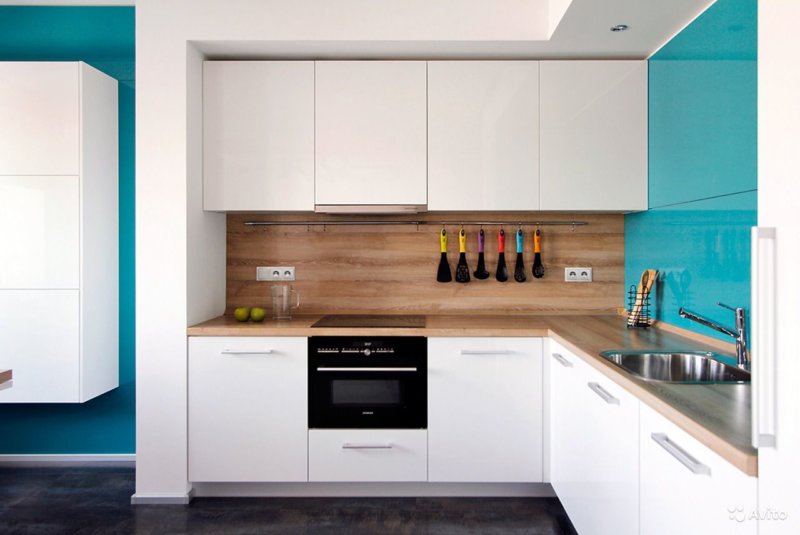
Laminated imitates wood colors better chipboard, looks especially good if the table top and apron are made in the same material.
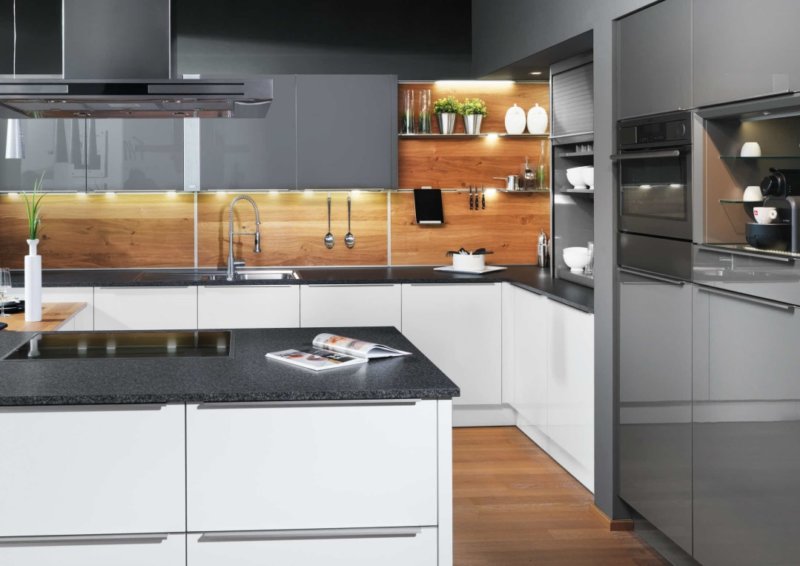
With acrylic film MDF (matte or glossy).
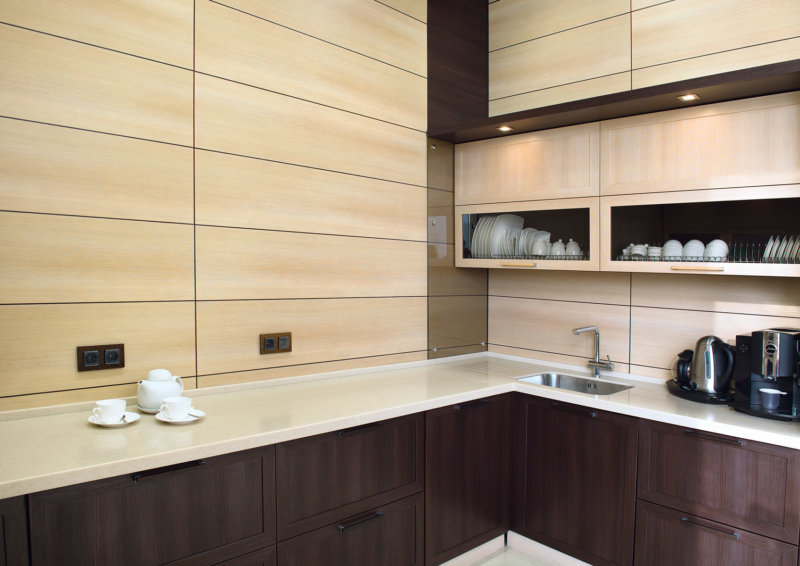
New moisture resistant material - MDF with acrylic panels. It has wide choose decor: with gloss, changes color "chameleon", with pearl shine, with photo printing, etc.
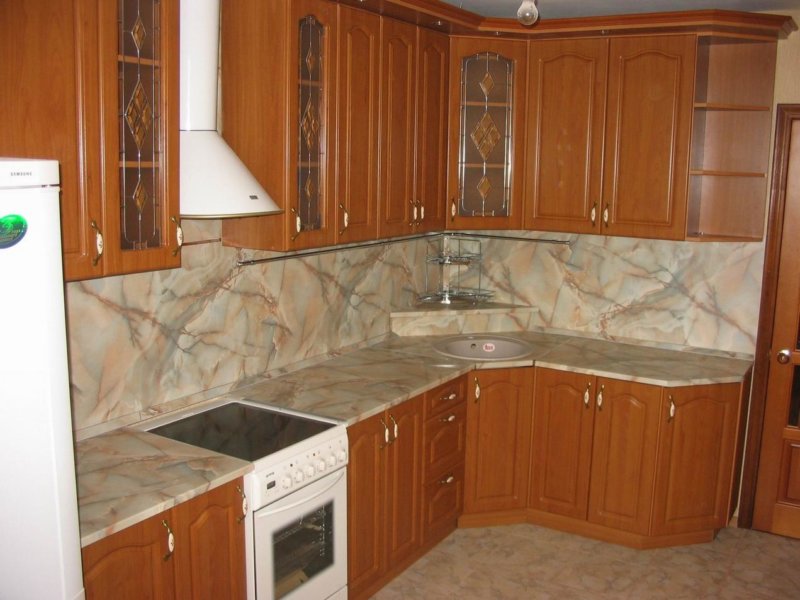
Wood application
Wood finishes for the kitchen the best way, wood is afraid of water, hot spray from the stove and steam. Can the tree be covered? protective varnish if an electric stove or induced - then the tree will do.
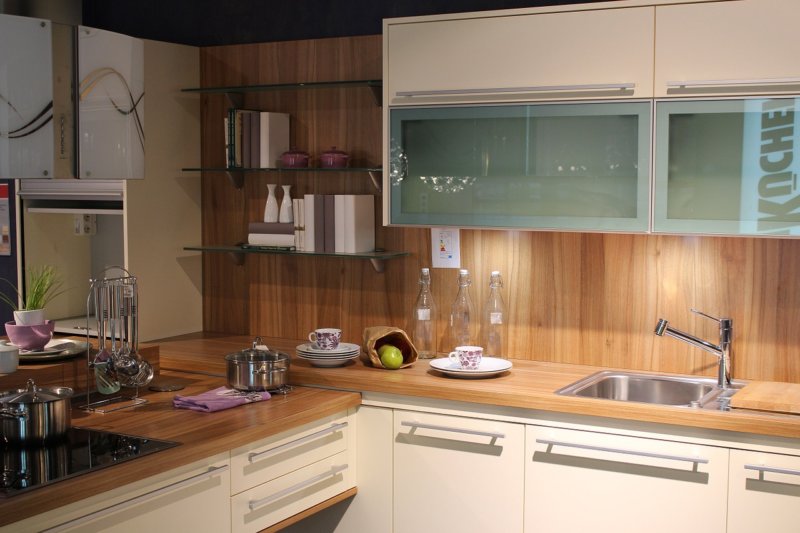
Apron laminate
Only fit waterproof laminate, the shade should be combined with the floor. Beautiful imitation of stone and wood.
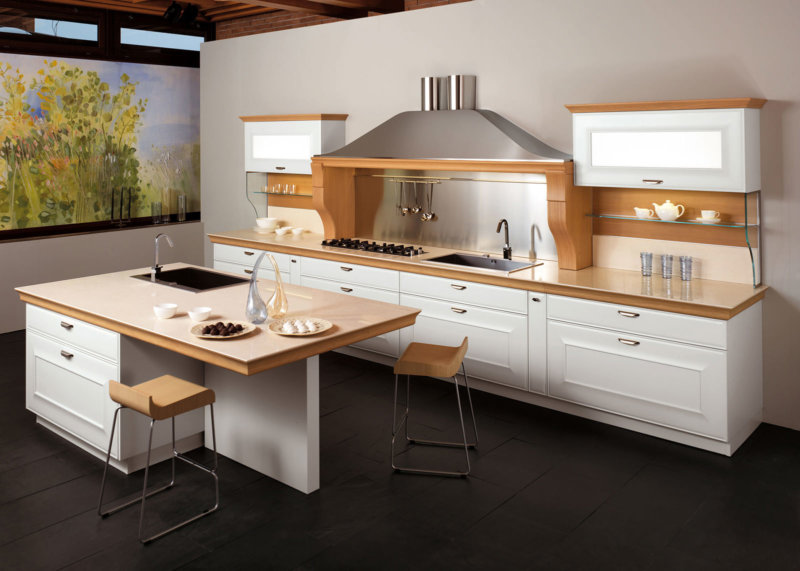
fastened liquid nails, the edging is fixed with aluminum profiles for good tightness at the joints between kitchen worktop and an apron. Easy to do with your own hands.
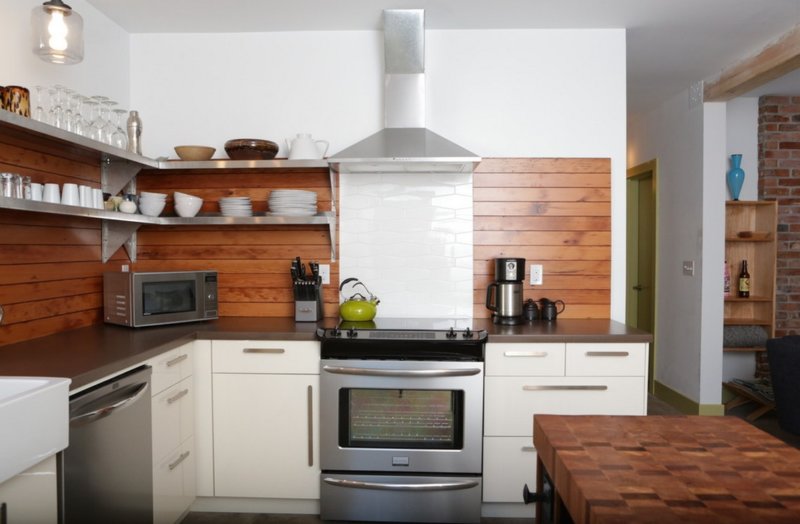
plastic panels
A budget way to finish, but there are enough shortcomings in an apron for a plastic kitchen:
- combustible, heating up, loses its shape;
- moisture resistant, but salts corrode the material;
- photo printing is effective on panels.
![]()
Low price and easy installation makes plastic aprons for the kitchen the most affordable.
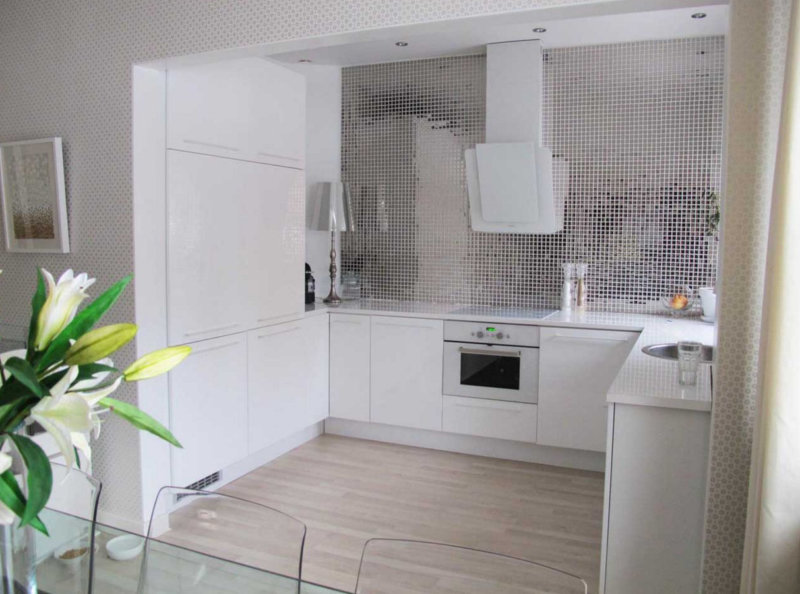
Apron polycarbonate or acrylic glass
In durability, PVC plastic is better, as well as in strength, but does not like high temperatures.
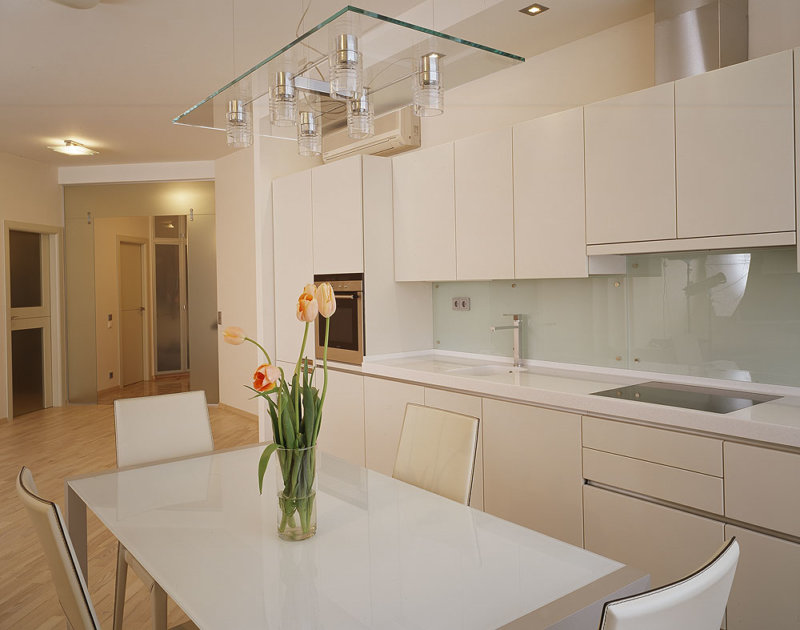
Light weight and installation, replaces glass, which can be made with different levels of transparency, with photo wallpapers, etc. Transparent plastic - good protection photo wallpaper from water and steam.
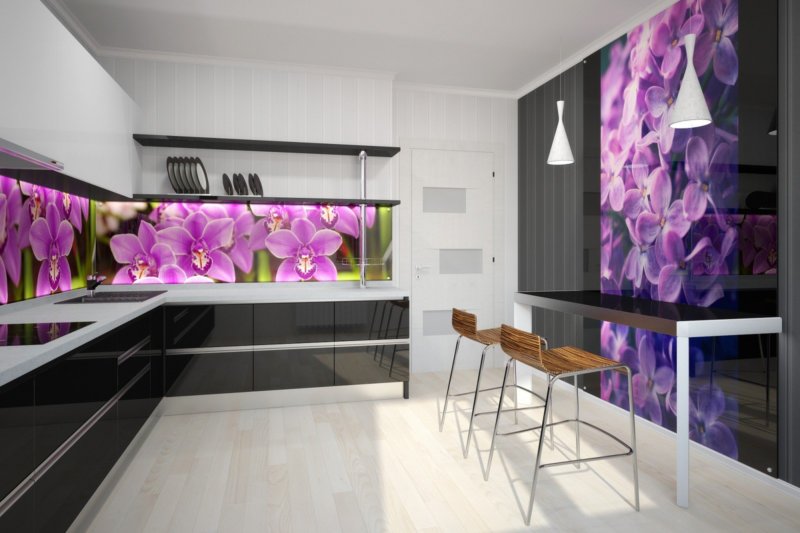
Apron metal
For professional kitchens, stainless steel is often used:
- the material is not combustible;
- moisture resistant material made of galvanized steel, as well as with dyes from polymers;
- resistant to all disinfections (chemical or biological);
- the possibility of surface treatment (tiles, mosaics or panels).
Glass Application
Glass apron for the kitchen is made of tempered glass or triplex. Mass of advantages:
- hygiene;
- not combustible;
- various design (toning, painting, photo printing, matte pattern, engraving, etc.);
- strength is slightly inferior only to tiles;
- safe and secure tempered glass, no sharp fragments if broken (cubes remain).
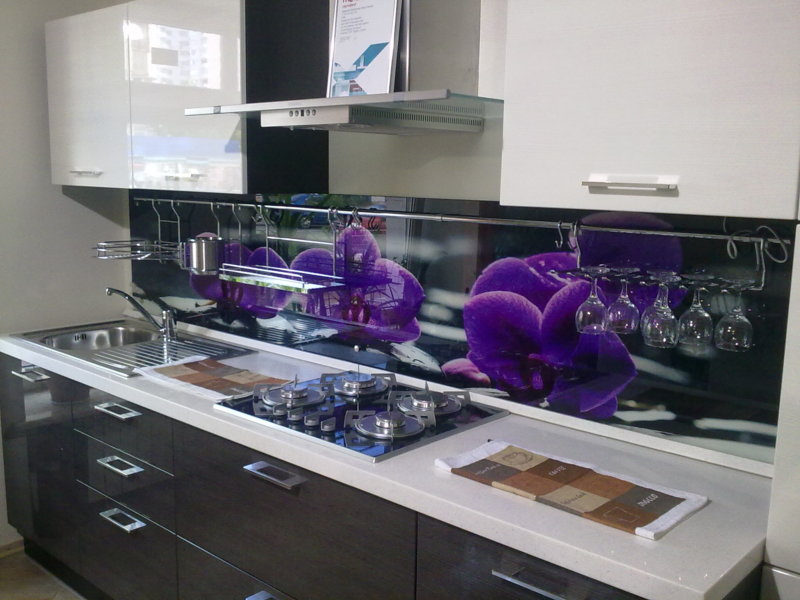
An apron for a kitchen with photo printing on glass can give 3D volumetric images, panoramic views, with a beautiful perspective.

You can install it yourself, but experience is required. Glass panels are heavy and fragile, you need to fix them well.
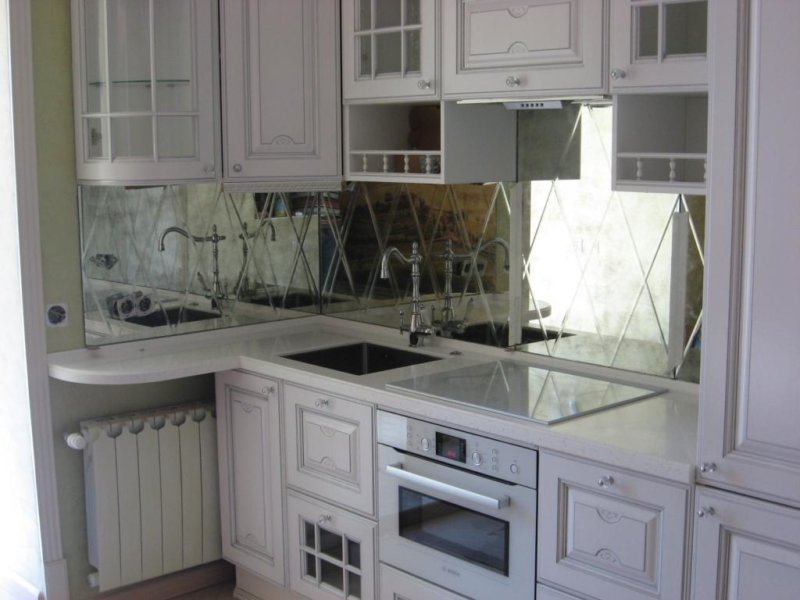
The glass apron can be mirrored, it is great way visually increase the space that designers often use. Photo printing is rarely used here.
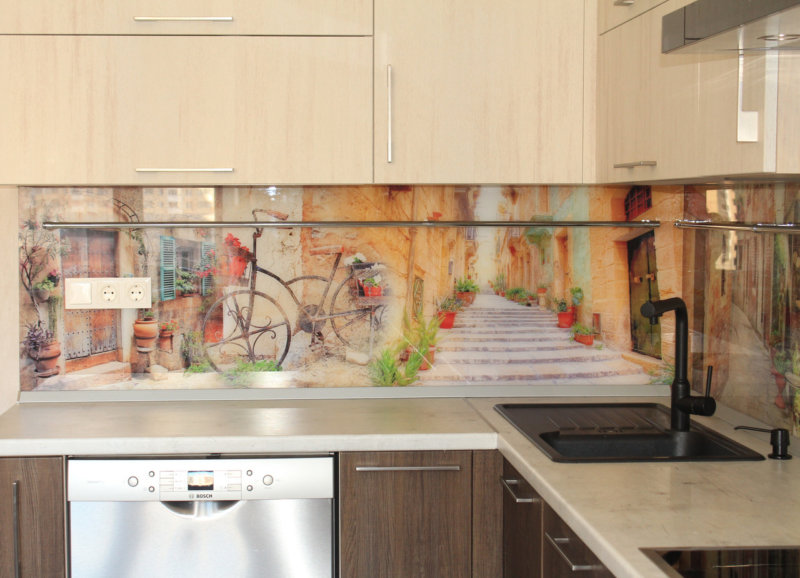
If you like White color, then an apron for a white kitchen can be cream, chocolate - any as an accent. But you can leave it in white, if desired.
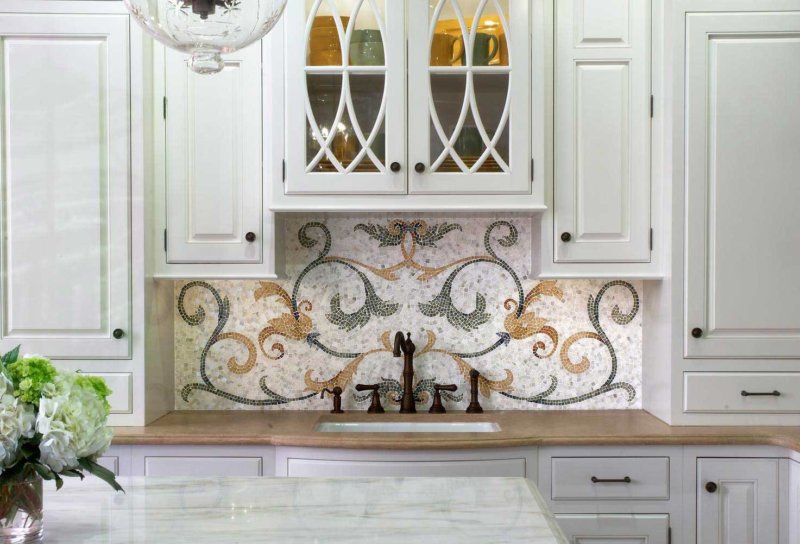
A huge number of designs in any style and color scheme in our collection on the photo of an apron for the kitchen.
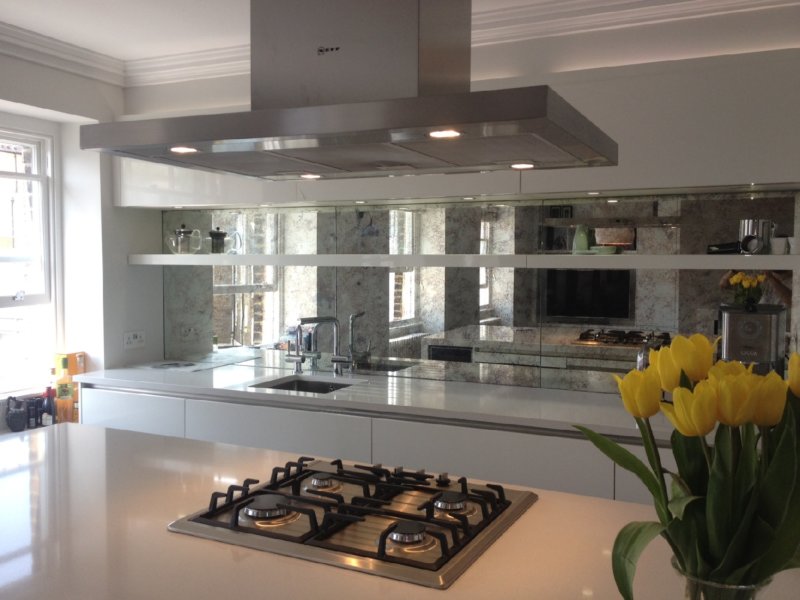
Photo of an apron for the kitchen
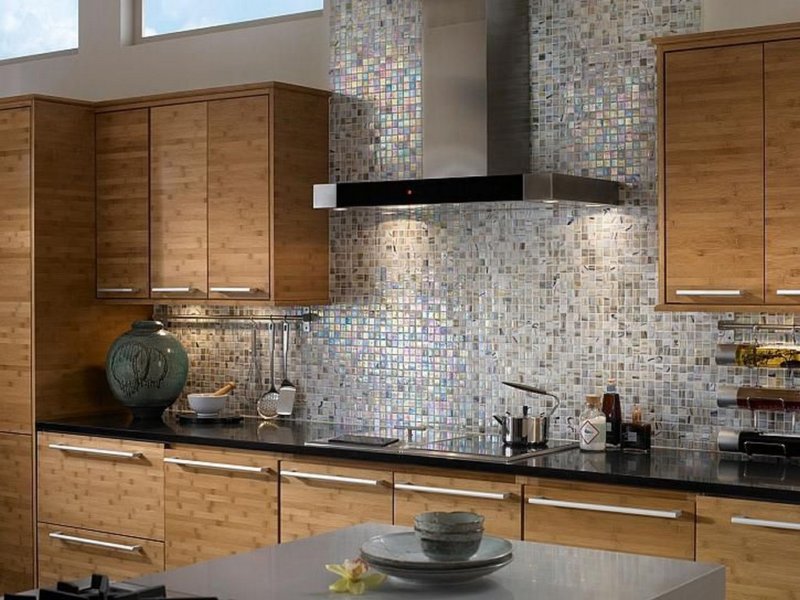
![]()
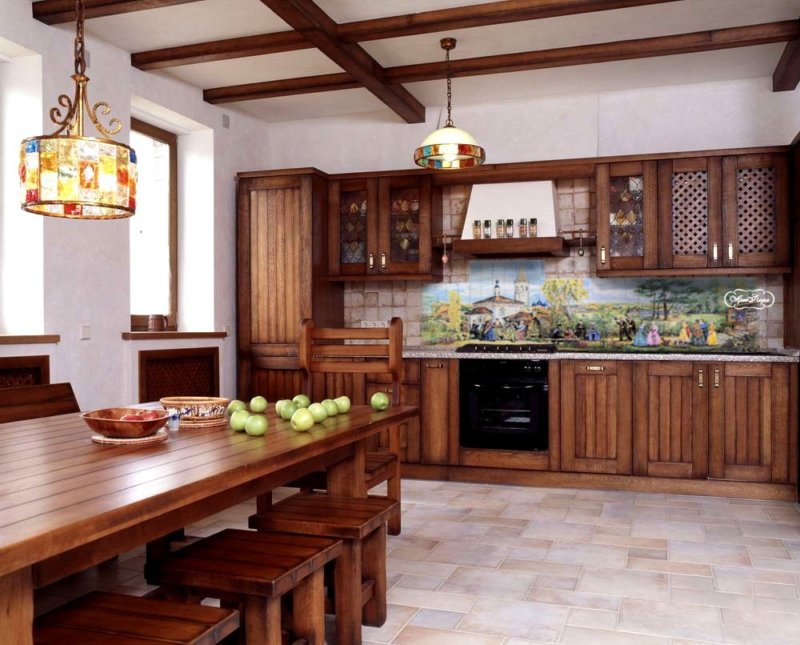
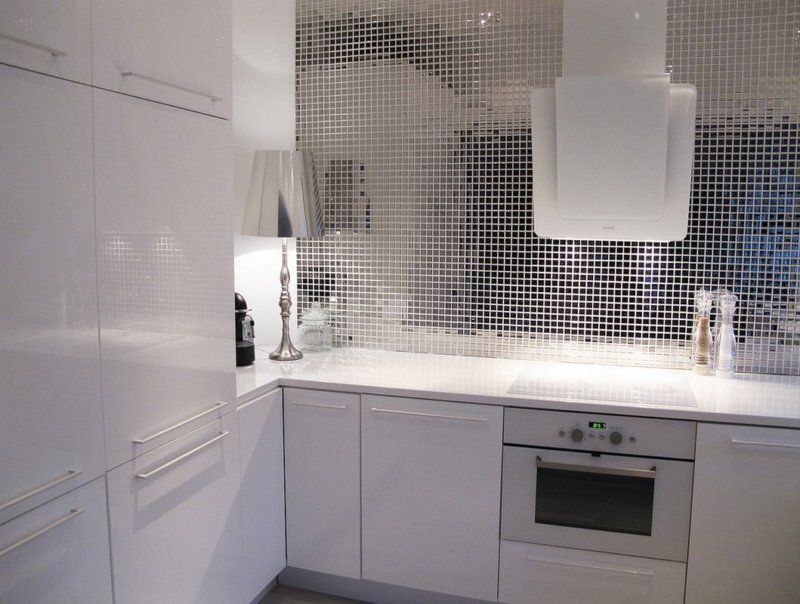
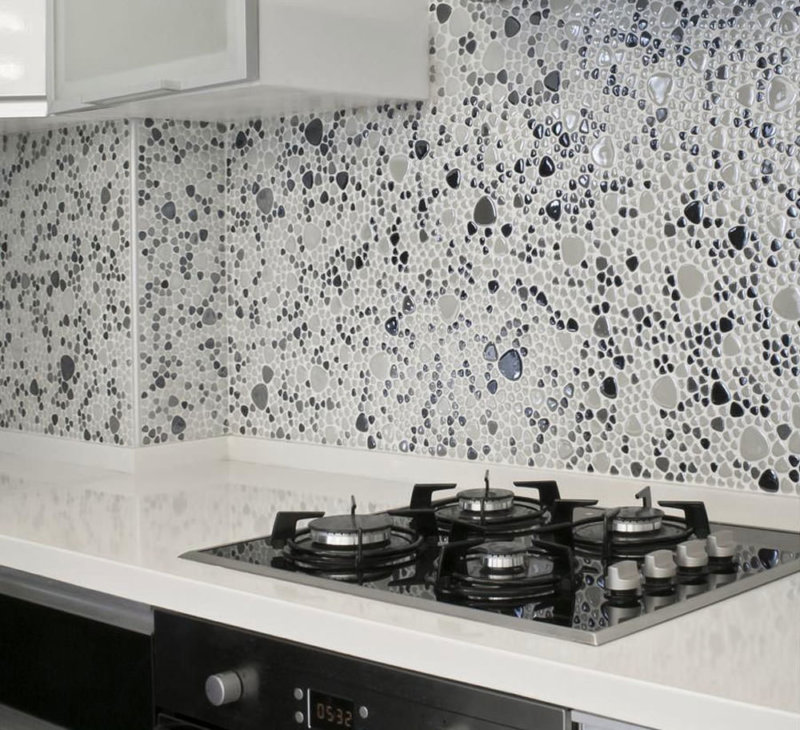
An apron in the kitchen is a kind of overalls for the kitchen area. It is able to protect wall surfaces from splashes of grease or oil.
As a rule, such an apron is made in the area of \u200b\u200bthe sink and stove. Consider some options for finishing the apron for the kitchen.
Overview of materials
Exist different variants finishing apron for the kitchen.
But, when choosing finishing material should be taken into account:
- strength;
- practicality;
- aesthetics.
Advice. For a kitchen apron, it will be better to choose a finishing material that has smooth surface without holes and pores. All this will allow you to better clean the apron coating.
How to trim an apron in the kitchen
Today there is very big choice finishing materials that can be used for an apron in the kitchen.
Materials for kitchen apron:
- ceramic tile;
- mosaic;
- glass;
- MDF panels;
- a natural stone;
- brick;
- metal.
Each of these materials has its own properties and functions. They also differ in cost.
Ceramic tiles in the finish of the apron for the kitchen
Finishing a kitchen apron with tiles is a very common option. This type of design is affordable.
The tile has sufficient strength and heat resistance. That is, when exposed to high temperatures, it will not deform.
Ceramic tiles do not absorb grease and are very easy to clean with any detergents.
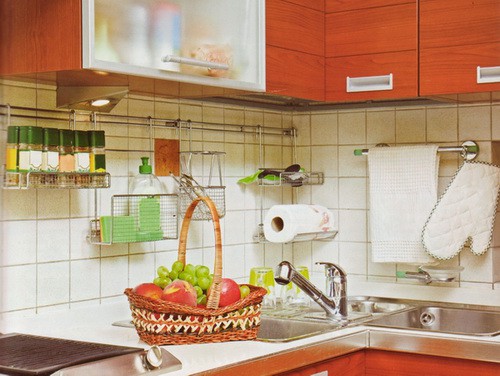
- Do not forget also that the tile will fit very well into any interior design. There are a variety of colors and sizes of such a finishing material.
All of them are widely used not only in the decoration of the apron. - Tiling a kitchen apron is not difficult. All finishing processes can be done by hand and save cash. But before doing the installation of ceramic tiles, you must first level the surface of the wall.
Such work can be done using drywall or ordinary plaster. - You can also use moisture resistant plywood or chipboard for these purposes.. It is very easy to mount ceramic tiles on them using special glue or concrete mortar.
The video shows the process of such finishing.
Advice. For finishing the apron, it is better to choose standard tiles tiles. They can be easily attached to the surface and further cleaned.
The use of mosaics in the decoration of the apron for the kitchen
The decoration of the kitchen apron with the help of mosaics looks very interesting and original. Multi-colored small tiles can create an original and unusual interior.
Mosaic can be:
- ceramic;
- glass;
- from decorative stone;
- from natural stone;
- metal.
Advice. To clean the mosaic of any material, do not use abrasive cleaners, so as not to damage the surface of the finishing material.
- Ceramic mosaics are small elements, 2x2 cm in size. The installation process of such a finishing material is very laborious and takes a long period of time, since each element of the mosaic decoration must be fixed evenly so as not to spoil the aesthetic appearance of the kitchen area. There is different colors mosaics.
With their help, mischievous drawings on the walls are created. - Glass mosaic is made of glass different thickness. Using this finishing material on a backsplash for a kitchen can help create a very original and sophisticated look for such a room.
Glass mosaic can change its color very quickly when lighting changes, which makes this finishing material even more unique. - Mosaic made of natural or decorative stone is not very common.. All this happens for the reason that such options for finishing the kitchen apron are quite expensive and not very practical.
Finishing material of this type is not afraid of high temperatures, but it may be difficult to clean it.

Metal mosaic is painted, as a rule, with a polymer or powder coated. It does not have a huge selection of colors and shades.
For its manufacture, only a stainless type of metal is used. Cleaning a metal mosaic is quite difficult, as it can be damaged upper layer and appearance of the finishing material.
Glass in the finish of the apron for the kitchen
This way of designing a kitchen apron is relatively new and not everyone has yet been able to appreciate its advantages.
Properties of glass apron:
- strength;
- practicality;
- resistance to cleaning agents;
- does not lose its appearance.
Despite the fact that glass is characterized as a fragile material, an apron made of it will be very practical and durable, since glasses of a certain thickness are selected for it. The photo shows an example of such a finish.
Today's manufacturers offer a very large selection of this material. Its price is different.
The cost of glass for an apron depends not only on the thickness of the finishing material, but also on the patterns or ornaments that can be applied to it.
Advice. Under glass panels on an apron in the kitchen you can do additional illumination in the form of small lighting fixtures. All this is original and unusual.

MDF apron for the kitchen area
Very often, only laminated MDF panels are used to finish the apron in the kitchen. They have sufficient moisture resistance and strength.
The only disadvantage of this design is that it is not worth cleaning such a surface using too active detergents due to the fact that the surface of the panels can be damaged and, as a result, not only the finishing material itself will deteriorate, but also the appearance of the room.
Main advantages of MDF panels are:
- fast installation;
- easy to clean;
- has a large selection of colors and colors;
- has high temperature resistance and wear resistance.
MDF panels or slabs can imitate ceramic tiles, bricks, natural stone and more. All this makes it possible to create original interiors and don't spend a lot of money.
There is an instruction, following which you can install such a finishing material with your own hands.
Advice. Finishing material such as MDF boards should not be used if gas stove too close to the apron. Do not forget the high degree of flammability of MDF panels.
Natural and decorative stone in the decoration of the kitchen apron
Options for finishing the kitchen apron with natural or decorative stone are very diverse. Natural stone is environmentally friendly and quite durable.
But this method of finishing is not considered ideal for the kitchen area. On natural stone, different spots may appear over time.
You can use it for a very long period of time.
Advice. In order for the natural stone to be preserved in its original form, you need to use wax protective equipment for processing and purification.
For finishing kitchen apron natural stone, as a rule, use a material whose thickness is at least 2 cm.
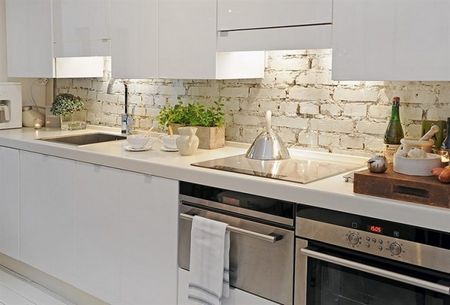
Decorative stone also looks very interesting. It has a beautiful appearance, and the price is largely different from the cost of natural stone.
Decorative stone, like natural stone, does not absorb moisture.
Other options for finishing the apron in the kitchen
For finishing work working area you can also use brick or metal.
This way of decorating the kitchen area is not very popular. Not everyone knows about him.
Brick is not taken for decoration standard size. There are special brick tiles, which are quite easy to mount on the wall using a special mounting adhesive.
The thickness of such tiles reaches 0.5 cm, that is material is light. The seams between the original bricks are grouted. The design of the apron with bricks looks very original.
The use of metal for an apron does not have any aesthetic appearance. This design looks rather rough, although there are a variety of colors and sizes.
The finishing material is sheets that are mounted on the wall with metal screws. There are also advantages to this finish.
It is practical, durable and very easy to clean with any detergent. But with it it is impossible to create an original and refined interior.
Before you make a choice in favor of one or another finishing material for an apron in the kitchen area, you need to take into account the fact that the material must be not only of high quality, but also moisture resistant, since this " protective zone» very often subjected to cleaning and wet cleaning.

